












LUIZ INÁCIO LULA DA SILVA PRESIDENT, BRAZIL
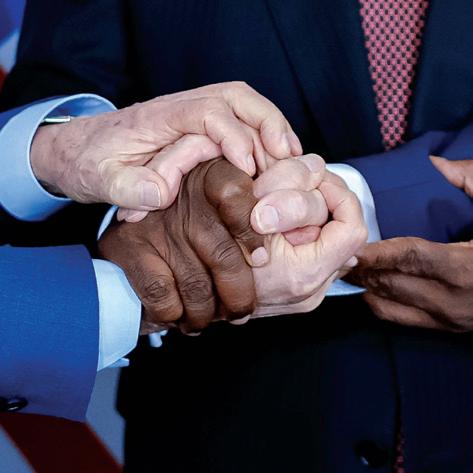
30 G20 RIO DE JANEIRO LEADERS’ DECLARATION
46 B20 BRASIL COMMUNIQUÉ
56 SUSTAINABILITY AND AFRICA: GET MOVING!
60 G20 SOCIAL DECLARATION
62 U20 RIO SUMMIT: THE VOICE OF CITIES IN 2024
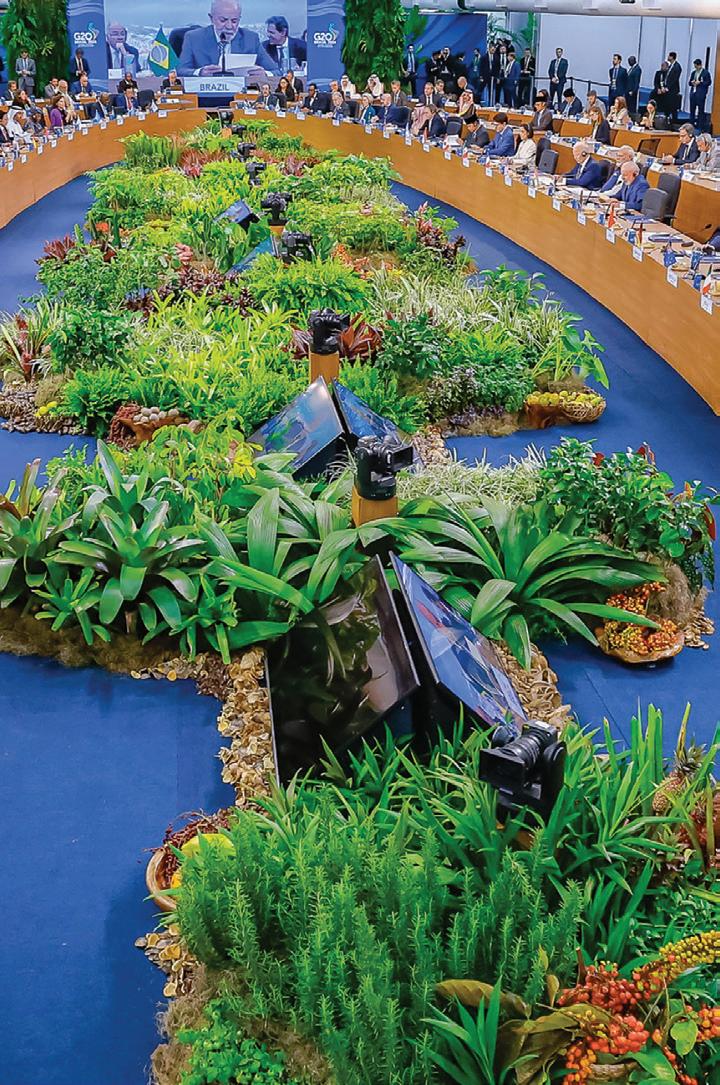
66 PREVIEW TO COP 30
68
COP30: PRESIDENT LUIZ INÁCIO LULA DA SILVA
70
VIRTUAL CLIMATE AMBITION SUMMIT AMB. ANDRÉ ARANHA CORRÊA
74 WHAT IS THE COP?
78 SEA MENACE: A NORTH ATLANTIC ENVIRONMENTAL AND ECONOMIC CRISIS
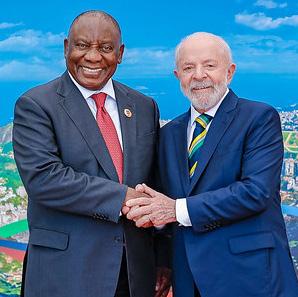
88 PREVIEW TO G20, B20 AND W20 SOUTH AFRICA
90
MESSAGE: PRESIDENT CYRIL RAMAPHOSA
92 B20 SOUTH AFRICA: MOMENTUM IS BUILDING
94 W20 SOUTH AFRICA
98
INDIA’S G20 PRESIDENCY: A TRIUMPH IN GLOBAL DIPLOMACY

“One of the most effective ways to combat climate change is through education and the sharing of knowledge,” says Vice Rector Gélineau.
Recognizing this, Université Laval’s Sustainable Development Profile, available across numerous academic programs, equips students with the tools to address complex sustainability challenges aligned with the United Nations’ 17 Sustainable Development Goals (SDGs).
In 2023 alone, over 315 courses integrated SDG 13 (Climate Action), reaching more than 15,650 students.
The university also offers a unique interdisciplinary master’s program— Chantier d’avenir en action climatique (Climate Action Initiative for the Future)—designed to train future leaders capable of guiding organizations and communities through the climate transition.
Research for a Sustainable Future
Université Laval has taken the same approach in supporting research, creation, and innovation initiatives for the benefit of communities and the planet.
“Our vision revolves around three strategic priorities – fostering inclusive research that values a diversity of perspectives and disciplines; enabling connected, socially engaged research that leverages digital technologies; and promoting sustainable research aligned with the United Nations SDGs,” Gélineau said.
Between 2017 and 2021, faculty produced 492 publications related to SDG 13, according to Elsevier bibliometric data.
A cornerstone of this effort is the Institut Environnement, Développement et Société (EDS Institute), founded in 2004. This interdisciplinary hub fosters solution-oriented research, public
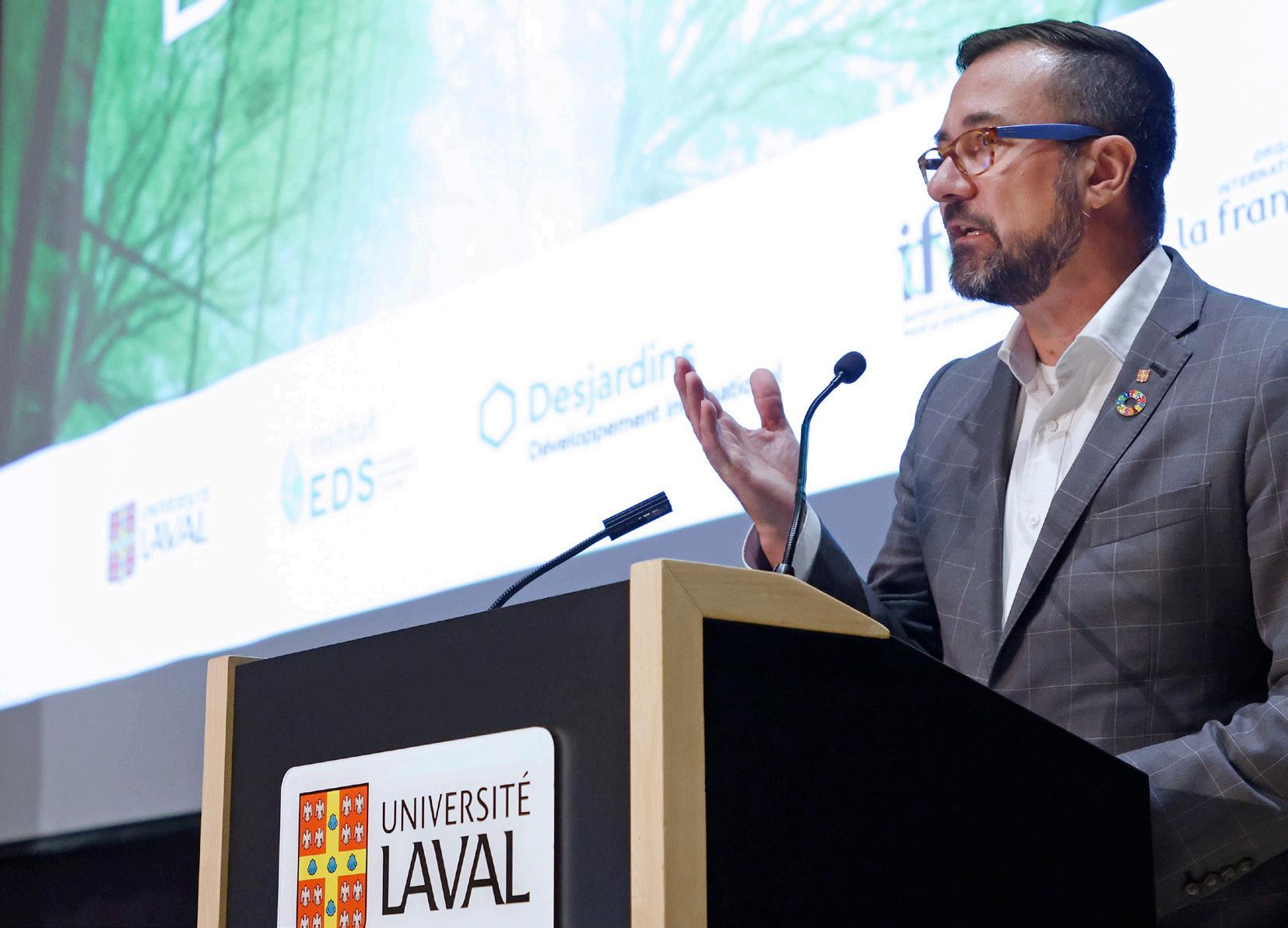
UNIVERSITIES PLAY A CRITICAL ROLE IN INTERNATIONAL EFFORTS TO MITIGATE AND ADAPT TO THE EFFECTS OF CLIMATE CHANGE. WE HAVE A DUTY TO GUIDE THE TRANSFORMATION OF OUR SOCIETIES TOWARD LOW-CARBON, SUSTAINABLE DEVELOPMENT.
engagement, and lifelong learning. One of its flagship initiatives, the Mouvement des entreprises vertes (Green Business Movement), supports the ecological transition of businesses in the Québec City region, promoting sustainable practices and energy innovation.
Another standout initiative is Sentinel North, a cross-disciplinary research and training program coordinated by Université Laval. Over the past decade, it has united more than 200 researchers, 700 students, and 40 ministries and international partners from 20 countries. Its 90 research teams address critical issues such as permafrost thaw, Arctic biodiversity, and sustainable development in northern communities.
“Thanks to Sentinel North’s work, Université Laval has become a leader in understanding the rapidly changing northern environment and its impacts on ecosystems, human health, and infrastructure at the northern and global levels. This is of fundamental importance,” said Gélineau.
Université Laval also manages the Montmorency Forest, the world’s largest teaching and research forest. Spanning 397 square kilometers, it serves as a living laboratory for boreal ecosystem research and sustainable forest management. It is used for education, research, and public awareness. Researchers are collecting real-time data and experimenting with sustainable forest management practices.
Université Laval’s 2023–2028 strategic plan places climate action at the heart of its teaching, research, governance, and community engagement.
“Our approach to reducing carbon emissions, transitioning to renewable energy, and adapting to climate change is grounded in four key actions: measuring, reducing, offsetting, and adapting,” explains Gélineau.
Since 2015, the university has achieved carbon neutrality, with compensation, for its Scope 1 and 2 greenhouse gas emissions. It aims to reduce emissions by 70% from 2006 levels by 2030, in line with global efforts to limit warming to 1.5°C.
The university’s sustainable investment strategy is equally ambitious. It targets a 30% reduction in the carbon footprint of its equity portfolio by 2025 and 50% by 2030. This is achieved by limiting exposure to fossil fuel reserves and prioritizing investments aligned with the UN Principles for Responsible Investment.
Université Laval also plans to reduce its energy intensity by 20% by 2030 (compared to 2012–13 levels) and transition to 100% renewable energy by 2035.
“Our greatest success is the mobilization of our community— students, faculty, staff, and partners— around climate action,” says Gélineau.
The university fosters engagement through awareness campaigns, participatory workshops, and partnerships with external organizations. These initiatives are designed to meet real societal needs and create lasting impact.
A key element of this approach is the University’s ability to build strong partnerships with external organizations from all sectors of society. These climate initiatives must be based on real needs and have a genuine societal impact.
“This community engagement and partnership fosters a shared sense of responsibility and prepares our community members to be agents of change in their field, and beyond,” Gélineau said.
Université Laval’s efforts have earned it global recognition. Since 2022, it has ranked among the top 2% of universities in the Times Higher Education Impact Rankings. In 2023, it reached the prestigious STARS (Sustainability Tracking, Assessment and Rating System) Platinum rating, one of the
highest distinctions for sustainability in higher education.
The university also leads UniC, an international academic network for climate action. With over 1,700 students from 60+ countries, UniC fosters collaboration through workshops, events, and participation in global forums such as the Climate Week NYC.
Université Laval is an active participant in the UNFCCC COP process, sending student and faculty delegations to recent conferences including COP28 in Dubai and COP29 in Baku. These engagements reinforce its commitment to experiential learning and global climate leadership.
“As the climate crisis intensifies, the role of universities as agents of change has never been more critical,” says Gélineau. “Université Laval embraces this responsibility by embedding sustainability into every aspect of its mission.”
Over the past two decades, the university has transformed its vision into action—educating future leaders, advancing climate science, and building a more resilient and equitable world.
“We invite individuals and organizations everywhere to join us on this collective journey toward meaningful climate action.” ■
François Gélineau is Vice Rector, International Affairs and Sustainable Development at Université Laval.
Université Laval: Located in the heart of Québec City—a UNESCO World Heritage site celebrated for its rich history and natural beauty—Université Laval is a thriving academic community of 65,000 students, faculty, and staff. Rooted in a northern identity shaped by the rhythms of the seasons and a spirit of resilience, the university has cultivated a deep commitment to sustainability. As the oldest francophone university in the Americas, Université Laval has emerged as a global leader in climate action and sustainable development, driven by a collective vision to shape a more just and resilient future.



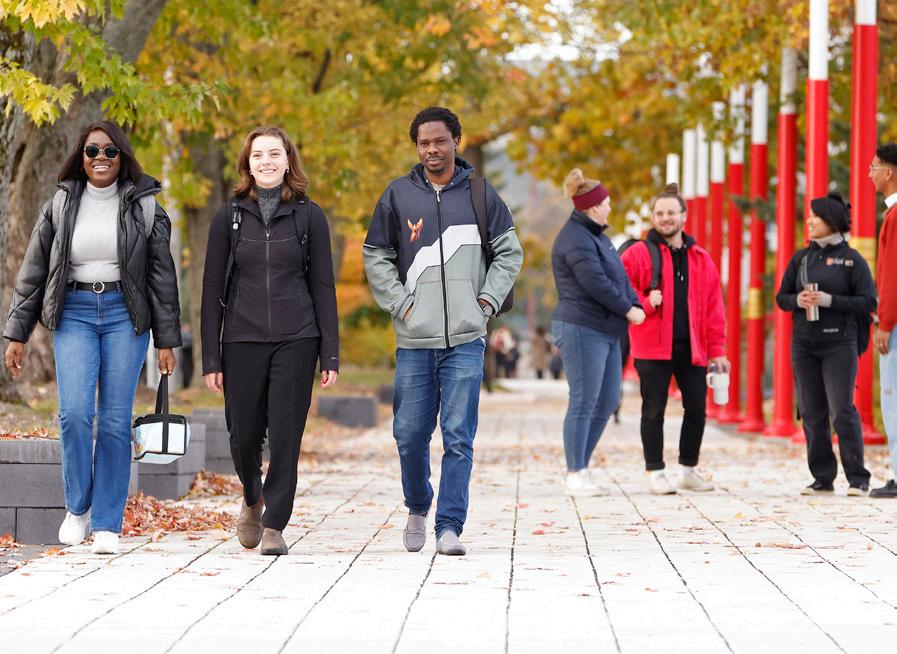

Today, Brazil completes the penultimate stage of a four-year sequence in which developing countries have occupied the leadership of the G20.
Indonesia, India, Brazil, and, now, South Africa bring to the table perspectives that are of interest to the vast majority of the world’s population.
Starting in Bali, passing through New Delhi, and arriving in Rio de Janeiro, we strive to promote measures that have a concrete impact on people’s lives.
We launched a Global Alliance against Hunger and Poverty and began an unprecedented debate on taxing the super-rich.
We put climate change on the agendas of Finance Ministries and central banks and approved the first multilateral document on the bioeconomy.
We issued a Call to Action for reforms that make global governance more effective and representative, and we engage in dialogue with society through the G20 Social.
We launched a roadmap to make multilateral development banks better, bigger, and more effective and gave African countries a voice in the debt debate. We established the Women’s Empowerment Working Group and
proposed an eighteenth Sustainable Development Goal to promote racial equality.
We defined key trade and sustainable development principles and committed to tripling global renewable energy capacity by 2030.
We created a Coalition for Local and Regional Production of Vaccines and Medicines and decided to expand financing for water and sanitation infrastructure.
We welcome events from the World Health Organization’s Investment Round, believing that more resources are needed to collectively respond to new and persistent health challenges.
We approved a Strategy to Promote Cooperation in Open Innovation and address asymmetries in scientific and technological production. We also decided to establish a task force on the governance of artificial intelligence at the G20.
This year, we held more than 140 meetings across 15 Brazilian cities.
We once again adopted consensus statements in almost all working groups.
We left a lesson: that the greater the interaction between the Sherpa and Finance tracks, the greater and more significant the results of our work will be.
We worked hard, even though we knew we had only scratched the surface
of the world’s profound challenges.
After the South African presidency, all G20 countries will have exercised group leadership at least once.
This will be an opportune moment to evaluate the role we have played so far and how we should act from now on.
We have a responsibility to do better.
It is with this hope that I pass the gavel of the G20 presidency to President Ramaphosa.
This is not an ordinary handover of the presidency — it is the concrete expression of the historical, economic, social, and cultural ties that unite Latin America and Africa.
I would like to thank everyone who contributed to the Brazilian presidency, especially those who worked to make our achievements possible.
I wish our comrade Ramaphosa every success in leading the G20. South Africa can count on Brazil to exercise a presidency surpassing our achievements.
I remember the words of another great South African, Nelson Mandela, who said: it is easy to demolish and destroy; the heroes are those who build.
Let us continue building a just world and a sustainable planet.
Thank you very much. ■

Why the next wave of enterprise growth isn’t websites, ads, or headcount. It’s a silent team of digital deal-makers working for you 24/7.
You know the drill Board asks for growth Markets tighten. Budgets shrink
You face a three-headed monster: rising acquisition costs, fickle buyer journeys, and teams already stretched past capacity. You’ve tried bigger ad budgets, longer funnels, louder campaigns. The numbers move— but not far enough, not fast enough, not cheap enough.
Now picture the opposite
No chasing traffic
No funnel tinkering
No cash bonfire on CPMs
Just qualified buyers—ready, eager, wallet-in-hand—flowing into your pipeline while you sleep. Impossible? Two years ago, maybe. Today, AI Agents make it routine.
Meet Your Silent Sales Force
AI Agents are purpose-built digital specialists. One scans the internet for perfect prospects. Another joins conversations, adds value, earns trust. A third guides each lead step by step until the deal closes.
Three roles
One outcome
New clients on autopilot
I call them Traffic Agents, Conversion Agents, and Nurture Agents. Together they form an always-on growth engine that replaces funnels, ads, and manual follow-ups with precision, speed, and zero waste.

1. TRAFFIC AGENTS: FIND YOUR IDEAL BUYERS
Every relevant forum, LinkedIn thread, industry Slack, X space, and niche community: they’re there. They watch, listen, and enter the dialogue the moment a prospect signals need. They give first—sharing white papers, data cuts, or a quick checklist. They collect an email. They guide the visitor to your asset.
No ads
No cold DMs
No dancing on TikTok
Just honest > value Instant trust > Fresh lead
Three clicks in the dashboard and they’re live. You never touch a targeting toggle again.
2. CONVERSION AGENTS: TURN LEADS INTO “LET’S GO”
A fresh email hits your CRM. Immediately, a Conversion Agent assembles the perfect sequence— case study, ROI calculator, invitation to a one-to-one demo. Each step personal, relevant, short.
No pushy talk tracks. No “spray and pray.” No missed objections. Every message lands like it was written by your best rep on their best day—because the Agent trains on your best rep’s wins.
Result? Shorter cycles, bigger deals, zero hand-holding.
3. NURTURE AGENTS: CLOSE THE RELUCTANT FEW
Some leads stall. Budgets shift. Decision loops drag. Fine. A Nurture Agent tags in.
One-to-one follow-ups. Gentle reminders. Fresh proof points. They reopen stalled threads, neutralize risk, and pull champions over the line.
No spam. No awkward “just circling back.” No friction.
Just genuine service that feels helpful, never pushy.
Control Center:Total Clarity, Zero Micromanagement
Open your dashboard. See every Agent, every action, every dollar. Approve a sequence, tweak a tone, switch an offer. Or do nothing at all and watch the client count rise.
One screen
Three metrics
Infinite confidence
Why This Matters to You, Right Now You sit at the intersection of global volatility and shareholder scrutiny. You need predictable growth and lean operations. AI Agents deliver both:
1. Lower CAC, Higher LTV, Faster Payback
No ad auctions to outbid. No funnel consultants to retain. No junior SDR army to manage.
2. Scale Without Headcount
Spin up ten more Agents in seconds. Enter new regions, verticals, languages—without burning payroll.
3. Future-Proof Against Platform Shifts
Algorithms change, cookies crumble, entire channels vanish. Agents adapt in real time—re-routing outreach, updating copy, shifting focus before a human even spots the dip.
That’s resilience. That’s sustainable growth. That’s what the G7, G20, and COP community call inclusive, efficient, digitally enabled commerce. You can call it next-quarter’s numbers—hit early.
Common Questions
(Answered in Three Quick Swipes)
Do I need my brand voice on social?
No. Agents can share value from a neutral angle (“Saw this resource— thought the group would benefit”). Low friction, high reach.
Can Agents replace paid ads entirely? Yes. Many clients cut ad spend by 70% in Q1, re-allocating budget to product, talent, or ESG initiatives.
I’m not technical. How hard is setup? Choose your offer. Pick your Agents. Press Launch. Coffee break over; pipeline on.
When do I see ROI?
Leads in days. Closed business inside a quarter. We back it with a straight shot: five new clients in 18 days or you don’t pay.
Where do I watch results?
Unified dashboard—real-time leads, conversations, revenue. Clear, simple, live.
A Quick Mental Walk-Through It’s 07:00 in Singapore. You’re wheels down for B20 week. Phone buzzes. “Three new deals signed overnight.” You smile, step off the jet, walk straight into your first meeting. No scramble. No late-night Slack pings. Your Agents handled it.
18:00 London time. You brief the board. CAC cut in half. Pipeline 3x. Headcount flat. Sustainability score intact. Applause around the table. Agenda item closed in six minutes.
23:00 Toronto time. You pour a nightcap. Dashboard shows tomorrow’s demos auto-confirmed. You switch off. Agents stay on.
Three scenes
One system Zero stress
The Broader Play: Why Leaders Adopt Now Policy chiefs push digital inclusion. CFOs squeeze OPEX. CMOs drown in data. CHROs fight burnout. AI Agents answer each mandate: Digital Inclusion: Mid-market prospects once priced out of enterprise funnels now engage through targeted microcontent, expanding access.
OPEX Efficiency: Cost per acquisition falls, headcount plateaus, margins widen.
Data Simplicity: Unified lens replaces siloed dashboards, letting leadership focus on insight, not integration.
Talent Wellness: Reps spend time on strategic conversations, not cold prospecting sludge.
Adopt early and lead; wait and follow. The window is open now—before Agents become baseline.
Your Next Step—Zero-Risk, Full-Throttle
Click “See My Free Agents.”
Spin a live set tailored to your region, sector, and offer. Watch them prospect in the wild for a week—on us. No card. No contract. Pure proof.
You’ll see leads flow. You’ll feel the shift—relief, clarity, control. And if you choose to scale? Your Agents go wide, deep, global. Find. Engage. Convert. Automatically.
History tips toward those who automate first. Steam gave way to electricity; electricity bowed to silicon; silicon now yields to self-learning systems. This is that moment in client acquisition. Quiet, rapid, inevitable. You can debate it. You can watch competitors embrace it. Or you can own it—today—and let the next trillion-dollar opportunity walk through your virtual door. Ready?
CLICK. DEPLOY. GROW. Clients.ai
Revenue today. Resilience tomorrow. Responsibility always.



The 2024 G20 and B20 Summits in Brazil marked a historic moment for global leadership, multilateral collaboration, and the advancement of sustainable, inclusive economic strategies. Set against the dynamic backdrop of Latin America’s largest economy, these summits brought together heads of state, business leaders, and civil society to address the most pressing challenges of our time—from climate change and digital transformation to supply chain resilience and social equity.
This G20-B20 Brazil Global Briefing Report Review captures the insights, priorities, and outcomes that emerged from this pivotal gathering. It reflects the voices of innovators and changemakers who stepped forward to share solutions that not only address immediate economic concerns, but also pave the way for a more just and resilient global future.
Brazil’s role extended far beyond the G20. As the host of COP 30 in Belém, Brazil positioned itself as a global leader on climate policy, biodiversity, and Amazon preservation. The synergy between economic and environmental agendas at these summits underscored a clear message: sustainable
growth and climate action are now inseparable.
As publisher of this special review, the Group of Nations was proud to contribute to this global conversation. We also look ahead with great enthusiasm to our upcoming official publications for the G7 Canada 2025 50th Anniversary Summit and COP 30, both of which will build upon the momentum generated in Brazil.
In preparation for the next chapter, we are also honored to be working alongside the Nelson Mandela Foundation, B20 South Africa, and W20 South Africa on the G20 South Africa 2025 Global Briefing Report Review. This forthcoming summit will mark the first time the G20 is hosted on African soil—a milestone moment that will spotlight African innovation, leadership, and the call for a more equitable global order.
For nearly three decades, the Group of Nations has worked to bridge the gap between government policy, global business, and civil society. Through this platform, we continue to amplify voices, accelerate solutions, and connect ideas to action.
We thank all the contributors, partners, and readers who made this edition possible—and we invite you to continue this journey with us.






In today’s world, it’s often the loudest voices that resonate. However, quiet voices matter, too.
If we avoid ignoring the existence of those who are currently unable to raise their voices...
And pay attention to even the faintest vibrations of those voices...
The reverberations have the potential to grow into a powerful wave.
Moving from leadership to partnership.
Striving to realize true coexistence.
Proposing a new vision for society and working to realize it.
International Non-Governmental Organization PEACE. has gotten down to work.

Khual Lian Kam
REPRESENTATIVE DIRECTOR, ingo PEACE.

Dear Ladies and Gentlemen,
It is truly exciting to see that South Africa is hosting the G20 Summit this year.
South Africa stands proudly at the forefront of global business. Their domestic economy is transforming to meet the increasing demand from both local and international stakeholders for growth, efficiency, and profitability.
At the same time, they are capitalizing on opportunities across various sectors to establish a significant global footprint.
The G20 Summit plays a critical role in addressing these opportunities and challenges. It seeks partnerships across the globe for guidance, support, and collaboration.
At ingo PEACE., we are committed to providing humanitarian and economic assistance to bring hope and progress to individuals, communities, and nations around the world. Our mission is to foster peace, security, and development—to build a richer, more inclusive world
through communication that transcends language, culture, and religion.
As we step into the age of data, the importance of information continues to grow. It is vital to build shared understandings from vast datasets, set meaningful goals, and advance togetheras partners.
We believe that democratic processes are the cornerstone of sustainable societies. Yet, we are acutely aware of the countless challenges still crying out for solutions across the globe.
That is why we understand the importance of creating environments conducive to coexistence and why we work tirelessly to understand such communities. Based on this vision, our mission is to serve as a bridge between nations and to contribute to social peace and economic development.
Together, with trusted partners, we remain dedicated to fostering economic, social, and cultural development while respecting each other’s unique values and traditions.

THE POWER OF VOICE. is a completely new type of online media. This new outlet is committed to providing neutral information from an independent perspective.
Our policy is to be a platform on which everyone living in this world can express themselves fairly and freely in a setting where diverse opinions are respected.
We aim to forge a society where individuals can face the challenges and problems before them, raise their voices, take action, and live independently.
By leveraging this type of communication to directly reflect the voices of individuals back to society, ingo PEACE. will strive to create mechanisms for coexistence.
As a pioneer, ingo PEACE. will
Providing humanitarian and business assistance as a bridge between nations
In an effort to bring new hope to individuals, societies, and countries, ingo PEACE. offers humanitarian and business assistance around the world. Our goal is to create a richer and more fulfilling world through communication that transcends race, nationality, language, and religion.
Numerous challenges continue to defy solutions in every area of the world. That’s precisely why we recognize the importance of an environment conducive to coexistence, and why we’re working so hard to realize such communities. We will leave to others what they can do and focus on what we’re uniquely equipped to accomplish by serving as a bridge between nations.
We will analyze problems. What is needed now? What caused the problem in question, and why has it not been solved? We’ll analyze why a solution has proven elusive and think about what can be done to effect one.

We’ll strive to collaborate by engaging in dialog with people from all walks of life, refusing to conclude that challenges no one has yet addressed cannot be resolved. We’re committed to continuously evolving as a pioneer that can take action alongside trusted partners to support a society where all participate while respecting and complementing one another.
As the data industry flourishes and we embark upon a new era, the importance of information is only growing. At times like this, it’s essential to foster shared understanding based on enormous quantities of data, set goals, and move forward through partnership and collaboration. I’m confident that democratic processes like these will lead to the realization of a sustainable society.

Right now, we are working towards the ambitious goal of “sharing instead of owning and co-creating instead of competing.” The resources needed for economic growth will be insufficient if we compete for them, but they can be abundant if we share them. Based on this analysis, we’ve moved away from the conventional concept of international cooperation, which focuses on redistributing surplus national or individual assets.
Instead, we’ve developed an economic model built on the foundation of equitable distribution to people around the world. We’re researching and developing new production systems that can realize this goal as part of an ongoing process of experimentation and verification.
By ensuring that all people can live independently, we will systematically create the mechanisms of a new society by laying a foundation that allows individuals to take the initiative to become involved in society.
We’d like to thank each participant country in the G20 Summit. We would be grateful if all participants and readers would join hands with us and work together.

In 2024, ingo PEACE. successfully orchestrated the delivery of medical aid to the Republic of the Union of Myanmar. This article reports on that achievement, which embodies the organization’s willingness to take on tasks deemed by others to be impossible by engaging in dialog with stakeholders with the goal of providing fair opportunities.
Working with trusted partners to quickly put plans into action
Dedicated to providing fair, neutral information and opportunities, ingo PEACE. seeks to make a sustainable and ongoing contribution to the stability of international society and to global economic activity. It does so by formulating shared channels of international cooperation and democratically implementing cooperative strategies through global partnerships with governmental agencies and the private sector. In keeping with this philosophy, the organization decided to provide medical aid to Myanmar as its first support activity.
Although this news was reported on our official website on May 1, 2024, the project began in January. When specific countries or regions are subjected to economic restrictions or pressure from the international community, the resulting economic damage often goes beyond shortages
of essential goods and medicine, skyrocketing prices, and lost jobs. It can also undermine deteriorating public safety and trigger social unrest, further exacerbating the already challenging conditions faced by ordinary citizens. What was then the ingo PEACE. Preparatory Office conducted discussions and analysis regarding the lives of ordinary citizens in Myanmar, who had few options in the face of worsening conditions. Despite extensive medical assistance being provided worldwide by the United Nations and many other organizations, political issues hindered progress in providing aid, leading to a deepening crisis. We concluded that we were uniquely positioned to help the people of Myanmar through dialog precisely because we’re committed to providing fair and impartial information and opportunities.
Having decided to provide this emergency humanitarian aid, we approached partner NGOs to seek cooperation on logistics. At the same time, we contacted Myanmar’s Ministry of Health to secure approval for the delivery of supplies, which proved to be the most challenging aspect of the process. The subsequent negotiations, correspondence, and coordination played out over the course of several months. Ultimately, we were able to put in place an arrangement to facilitate acceptance of supplies through the Myanmar Red Cross Society, which agreed to act as our liaison with the government.
The packing of relief supplies began in April, and records show that the supplies were shipped
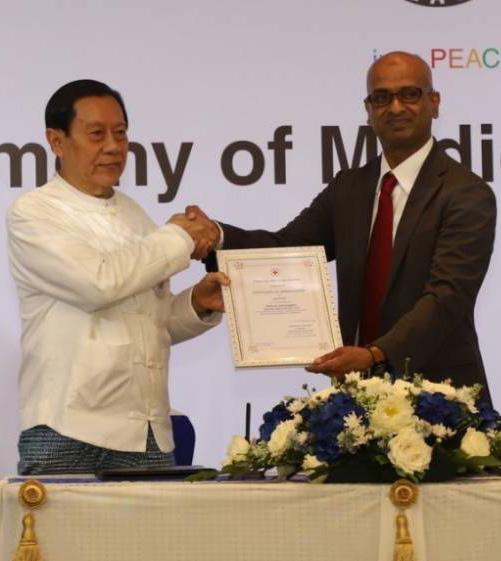
by sea from the U.S. in early June. Unfortunately, humanitarian aid supplies don’t enjoy priority handling during shipment. Shipping supplies by sea from the U.S. to Myanmar usually takes several months. In this case, additional delays were possible due to congestion at transit points, along with the risk that necessary paperwork might not be properly processed in some countries.
Furthermore, arrival of a shipment triggers various procedures, including a detailed review to ensure the items received match the packing list and are authorized for import. Moreover, the recipient must complete receipt of the goods within the specified time frame. Ensuring that the donated supplies reach those in need promptly entails navigating a complex series of processes with precision.
In this case, collaboration with partner NGOs with expertise in humanitarian aid logistics proved to be essential. We carefully coordinated with those NGOs, selecting a reliable shipping company and engaging a licensed non-profit organization to manage logistics risk. Ultimately, a container carrying medical aid supplies worth a total of $470,000 — including bandages, surgical gowns, syringes and needles for various purposes, oxygen masks, toothbrushes, and more — arrived without incident at the port of Yangon at the end of August.
What a commitment to providing fair and impartial information and opportunities uniquely positions us to accomplish
On September 1, 2024, a handover ceremony for the aid supplies was held at a hotel in Yangon. Red Cross representatives, stakeholders from within Myanmar, ambassadors from various countries stationed in Myanmar, and a deputy representative from ingo PEACE. attended the event.
“Today’s ceremony marks an important milestone in our partnership with ingo PEACE.,” said Professor Dr. Myo Nyunt, President of the Myanmar Red Cross Society, as he opened the ceremony. “It also serves as a reminder of the power of unity, and of our shared mission to alleviate human suffering and pursue the health and well-being of all. The supplies we’ve received will undoubtedly help us respond swiftly to people in urgent need of medical care. We deeply appreciate your generous support and dedication.”
In response, ingo PEACE. Trustee
S.M. Nazrul Islam said, “In this case, we were able to successfully deliver medical aid in partnership with the Myanmar Red Cross Society and other organizations. There remains much that we can do on behalf of this country. Going forward, we hope to continue our efforts to support Myanmar’s economic and sociocultural development by partnering with organizations and other like-minded individuals who care about Myanmar.”
ingo PEACE.
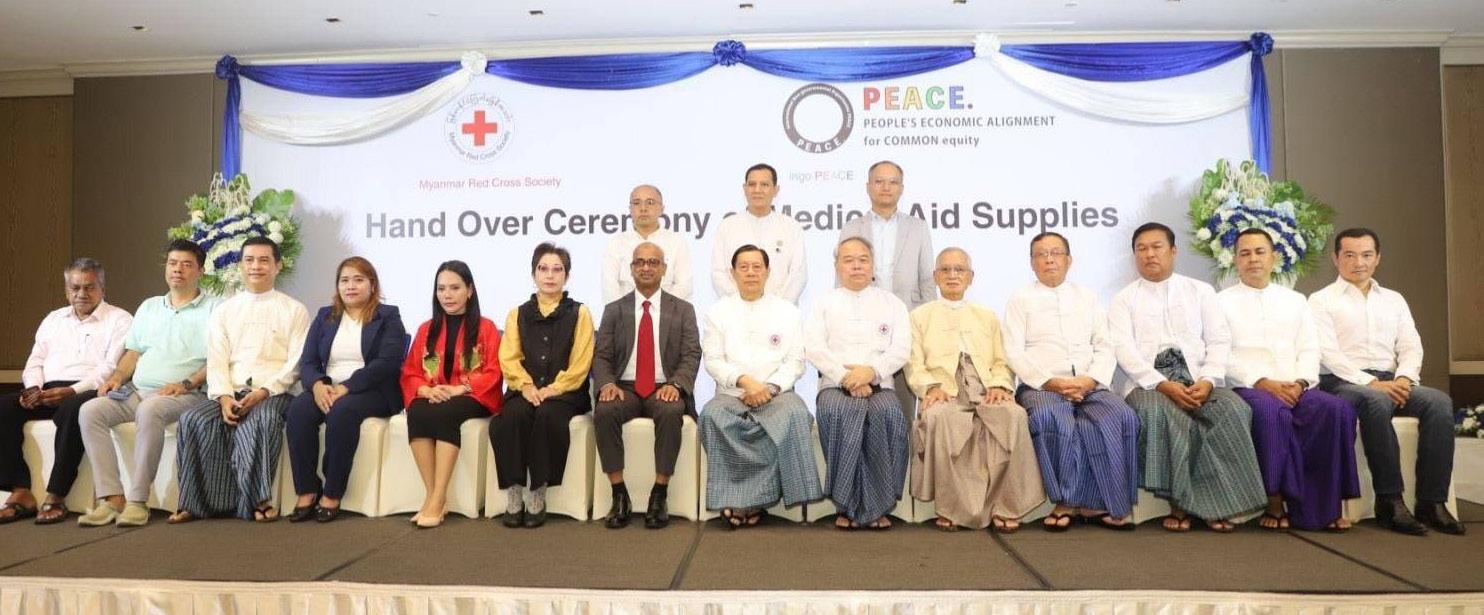
The second half of the event included a signing ceremony and presentation of a certificate. In remarks to close the ceremony, Professor Dr. Tin Maung Hlaing, a member of the Myanmar Red Cross Society’s Executive Committee, said, “Compassionate assistance from ingo PEACE. embodies the true spirit of humanitarianism and serves as a beacon of hope. Your donation is more than just a contribution of medical supplies. It’s a lifeline to people who are struggling to survive. A journey of a thousand miles begins with a single step. Today, we took that first step.”
The ceremony was covered by numerous media outlets and featured on the official social media accounts of the Myanmar Red Cross. Notably, support from other countries and

organizations poured in as soon as the news was shared. The willingness of ingo PEACE. to embrace this challenge embodies a breakthrough in providing humanitarian aid under conditions that were considered by many to be impossible.
Following the completion of customs and other formalities, the aid supplies were officially handed over to the Myanmar Red Cross on October 21 and have since been delivered to the sites that need them most, including medical university hospitals and the Central Medical Stores Depot, which operates under the jurisdiction of the Ministry of Health.
Ingo PEACE. already has several new projects underway.



Esteemed world leaders, distinguished representatives from various nations, and fellow global citizens, we find ourselves at a critical juncture, confronting unprecedented challenges that threaten global stability — among them, an energy crisis, climate change, population growth, and cultural tension. These pressing issues call for the creation of a new societal framework, one that equips us more effectively to navigate and address these complexities. In moments like these, it is vital to recognize the transformative power of culture.
Culture not only connects people but also fosters mutual understanding, bridging divides. However, truly integrating culture into our lives requires deliberate reflection and thoughtful engagement.
I have been deeply engaged with traditional Japanese culture for many years. In particular, my experiences as the head of the Senchado Obaku Baisa school of tea ceremony have profoundly shaped my understanding of culture and tradition. Culture, as I see it, comprises two distinct concepts: Densho culture and Dento culture.
Densho culture focuses on faithfully preserving and passing down practices from the past, maintaining them without deviation. In contrast, Dento culture involves a process wherein each generation refines and polishes inherited practices while discarding elements that have become outdated. It is about weaving together enduring values with those of the present era to create a new synthesis. This continuous evolution of connectedness is the essence of traditional culture.
For this reason, I place great value on Dento culture but have little interest in Densho culture.

However, in the world of tea ceremony, there are many who prioritize preservation above all else. My approach, instead, is to refine and evolve tradition. When I assumed the role of head of the school, the first significant change I implemented was the abolition of seiza — the traditional Japanese formal sitting posture. I believed this step was necessary not only to preserve the essence of tradition, but also to adapt cultural practices to align with contemporary times.
In this way, I hold that Dento culture should not merely be preserved but must evolve to stay relevant. True tradition lies in retaining what is authentic and enduring while allowing culture to adapt and progress alongside the times.
Given this background, as chairperson of ingo PEACE., I view my role not as that of a traditional leader in the conservative sense, but as a facilitator of wa (harmony) — a coordinator who integrates diverse cultures and values. This is an international nongovernmental organization dedicated to creating a new era by harmonizing regional cultures while respecting foundational frameworks such as national borders, ethnicity, and religion. The principle of preserving tradition while reinterpreting it to align with the times and evolving collectively toward the future has been a guiding theme throughout my life.
As chairperson, this is the perspective I wish to convey: While the challenges facing our planet may seem diverse, they fundamentally stem from a single issue: energy. Ultimately, all problems on Earth converge into this issue. I believe it is no exaggeration to say that there is no challenge on this planet that does not, in some way, relate to energy.
Climate change is an issue of energy use. Nuclear accidents are energy-related disasters. Food shortages are, at their core, another form of energy problem. Even the most pressing issue — our rapidly growing population — can be understood through the lens of energy. The real question is this: how can we effectively and equitably distribute various forms of energy to people across the globe?
This, I believe, is the true energy problem that humanity must solve as we move forward. My message is not simply about stopping wars. Rather, I contend that if we could achieve a cooperative, equitable system of energy distribution and secure its broad acceptance, many of the world’s challenges would naturally move toward resolution.
The world currently operates under the entrenched notion that energy is limited, fostering a lack of international cooperation and leading nations to resort to war as a means of competing for energy resources. At its core, war is a colossal clash of energy, with both sides exhausting their resources and the victor seizing the energy of the defeated. For generations, energy has been regarded as exceedingly difficult to equalize and distribute fairly, leading many to conclude that equitable distribution is nearly impossible without resorting to conflict.
While it’s true that the challenge lies in the difficulty of equalizing and distributing energy, I believe there is a key insight that could point us toward a solution.

That insight is this: Among all forms of energy, the only one that harms no one is the energy generated by culture and the arts. This unique form of energy has the potential to unite rather than divide. The world must begin to pay more serious attention to this overlooked and transformative source of energy.
The key lies in finding an effective way to harmonize and balance energy that does not harm people with energy that is highly fragile, ensuring its equitable circulation across the Earth and among humanity. I believe this approach to energy holds the potential to pave the way toward lasting peace.

As the chairperson, I define “peace” as “a state where all forms of energy reach every living person, ensuring that no place on Earth is left with zero energy.” I aim to propose this definition to the world and seek global agreement. Under this vision, those who possess various forms of energy would collaborate to eliminate energy deserts. This effort would involve discussing and prioritizing challenges as they arise, developing phased and cooperative strategies, and starting with concrete, actionable steps.
That said, I acknowledge that achieving an energy distribution that satisfies everyone is an ideal that may be difficult to realize due to the simple reality of human greed. As humans, not gods, it is perhaps inevitable that some individuals will be unwilling to relinquish their vested interests. ➔

However, I would urge such individuals to, at the very least, take responsibility for ensuring that no energy deserts exist on Earth. By achieving this, I believe it will become possible for all 8 billion people on our planet to live with dignity and move forward together into a sustainable future.
To be honest, I have rarely used the Japanese word for peace, heiwa, in the sense of the “absence of external conflict.” Instead, I have preferred the word heian, which has a similar meaning but places greater emphasis on inner serenity. Emperor Hirohito once said, “I pray for heian in people’s hearts.” While I can only speculate, I suspect there has been no emperor who sought peace as earnestly as he did. Few have sought it as deeply, having endured hardships beyond what words can describe. Yet, notably, he steadfastly refrained from using the word heiwa. Instead, when he prayed for peace in people’s hearts, he chose the word heian
This deliberate choice of words likely stemmed from the perspective of his time. He did not seem to regard peace merely as the opposite of war or as a temporary lull between conflicts, as many then might have thought. Rather, he seemed to envision peace as the permanent

absence of conflict, a state far deeper and more enduring. For this reason, I believe the emperor did not use the word heiwa lightly.
As a Japanese person, I have embraced that sentiment and reflected on the true meaning of peace in the sense of heiwa. Through this reflection, I came to a striking realization: peace has never truly been defined. This realization led me, through ingo PEACE., to propose the definition of peace — heiwa — as described above. However, I do not claim that this is the sole or absolute definition; rather, I present it as one possible perspective on understanding peace. I invite you to use this opportunity to engage in discussion about how best to define the word. If you discover another definition that feels more appropriate, we would genuinely welcome your thoughts and insights.
If this process does not result in a concrete definition, then let us come together to collectively define what peace truly means. Once we reach an agreement on that definition, we should unite in our efforts to make it a reality. This, in essence, is my proposal.
Let us reflect on the fundamental nature of energy, which lies at the core of peace. Energy is not something that is merely consumed; it is something that changes form and continuously circulates through the universe.
In other words, energy flows through people and objects, transforming its state while perpetually moving through the cosmos. This perspective calls for a renewed understanding of energy and its role in our world.
For instance, addressing the global issue of carbon dioxide (CO2) emissions may require us to rethink CO2 not as waste but as a form of energy that can be harnessed and circulated. The real challenge, I believe, lies in the retention of energy in the atmosphere in the form of CO2
Consider this: Soil has the natural capacity to bind and store CO2 at more than six times the absorption capacity of the atmosphere and over four times that of plants. It inherently possesses the ability to embrace and utilize CO2. However, global reliance on chemical fertilizers and pesticides over the past 80 years has decimated the microorganisms responsible for carbon sequestration in soil. As a result, soil, once a sink for CO2, has become a source of emissions.
Even as we work to plant forests, the very soil with a CO2 absorption capacity far surpassing that of plants is being degraded by excessive chemical use, turning it into a dependent system incapable of producing crops without chemical input, accelerating desertification, and exacerbating climate change. This paradox is a striking example of how human ego disrupts the natural flow of energy and destroys the Earth’s ecosystem.
Humans have both destroyed the planet’s greenery and become the primary emitters of CO2. From the Earth’s perspective, it is clear that humans are the main disruptors of energy flow. The realization that energy circulates rather than being consumed lies at the very foundation of the philosophy of harmony — one that we must adopt to ensure the Earth’s survival.

ingo PEACE.
In 2024, the organization successfully coordinated the first delivery of medical aid supplies from the United States to the Republic of the Union of Myanmar, in collaboration with the Myanmar Red Cross Society. While providing such supplies is crucial for addressing immediate shortages, I believe that in the near future, it will be equally vital to accompany these efforts with the delivery of culture and the arts.
I hypothesize that fostering the maturation of social culture can help address one of the most pressing energy challenges: the population explosion. Population explosions predominantly occur in developing regions, whereas G20 countries are not experiencing such growth. In fact, Japan is facing an unstoppable population decline. While factors such as economic development and social systems play a role, I believe cultural maturity is also a key determinant.
As economies develop, social cultures mature, and a greater proportion of energy is directed toward culture and education. By providing international support that includes cultural development in regions where social maturity is needed, we can redirect energy away from activities that lead to explosive population growth and toward those that align with cultural enrichment. This shift has the potential to foster the creation of new social cultures, which in turn can naturally guide the global population toward an appropriate balance.
Of course, such a transformation will take time. Considering the average life expectancy in developing nations and the world’s poorest countries, I estimate that the process could take 35 to 40 years. During this time, if population growth halts and begins to decline, continued energy support for cultural
development could ensure this transition happens peacefully, without the need for conflict.
As the energy devoted to culture increases, unique cultures will emerge, fostering interactions that evolve into mutual respect and unity, transcending discrimination. From another perspective, it is also true that cultures inevitably wither in the absence of interaction. Thus, I believe that engaging in creative cultural exchanges can enable culture to play a harmonious and transformative role for humanity.
This vision represents one of the core approaches that ingo PEACE. advocates.
Historically, this reality — that cultures wither in the absence of meaningful interaction — becomes clear when we consider that the Inca and Aztec civilizations have had little to no influence on our way of life, which is rooted instead in the four great ancient civilizations. The lack of interaction between the Inca and Aztec civilizations and these ancient civilizations can be attributed to various factors, such as the absence of paper for recording information and an inability to establish contact.
Had such exchanges taken place, I believe the trajectory of our science and culture would have been profoundly different. For example, skulls uncovered at Inca sites clearly show evidence of brain surgery, which was being performed as far back as 600 years ago. In contrast, brain surgery only began in relatively modern times within our own civilization, which is based on the four great ancient civilizations. This stark difference suggests that the world of medicine could have evolved along entirely different lines.
Furthermore, despite the absence of iron, the Inca civilization produced textiles as wide as 4 meters.
Remarkably, the techniques used to create these textiles remain a mystery.
I believe that interactions between diverse cultures possess tremendous potential to influence one another positively and contribute to the collective happiness of humanity. The goal is to provide thoughtful, nuanced support while promoting cultural and artistic exchanges. By harnessing the unique energy of culture, a form of energy that harms no one, we can create a framework to envelop and equitably distribute more material and fragile forms of energy.
What kind of world could we create if cultural and artistic exchanges were to expand across the globe? When it comes to culture, the goal is not merely to eliminate opportunity deserts but to foster meaningful interaction. It is about encouraging exchange and striving for harmony — a philosophy of coexistence rooted in the understanding that no culture can thrive without interaction. International cooperation and similar efforts can sometimes feel awkward because they often focus on replenishing energy lost through competition over limited resources. For instance, food energy provided through international aid, under such conditions, can inadvertently trigger a vicious cycle, leading to explosive population growth.
To break this cycle, I believe we need a new approach, one that integrates support for cultural exchange into a broader international cooperation strategy. Through our work, I hope to help build such a framework.
Conventional international cooperation has traditionally been based on vertical intervention, where nations or organizations ➔

in leadership positions take the initiative and guide others. However, this model is no longer effective in addressing today’s complex global challenges. We aim to implement horizontal intervention, where decisions are not imposed by leaders, but rather made through equal collaboration among nations and regions as they work together to solve problems. This approach defines the international cooperation strategy that we are working to achieve.
Our mission at ingo PEACE.
Our mission is to eliminate energy deserts and create a world where everyone has access to the energy needed to live. We strive to build a society where energy — whether in the form of food, healthcare, information, or culture — is distributed equitably. To achieve this goal, we are committed to fostering international cooperation and working together with people from all walks of life.

Our principal activities are built on four pillars:
1. International food assistance: Ensuring a stable food supply by securing agricultural land through international cooperation, supporting safe food production, and advancing production technologies
2. International medical assistance: Contributing to the establishment of stable healthcare systems across all countries and regions by collaborating with experienced organizations
3. International information assistance: Supporting the collection and discussion of critical information needed to address global challenges while amplifying voices from around the world through media operations
4. Support for community service programs: Providing opportunities for more people to engage in the organization’s activities and fostering closer connections to community service and social good
These four initiatives are all rooted in the principle of empowering all with the strength to live. By bringing
these efforts to the global stage, we act on our commitment to protect the lives of the vulnerable. This is the mission of ingo PEACE. as it aspires to define peace as a world where energy deserts have been entirely eliminated.
Throughout history, the world has witnessed times when monetary value nearly vanished, vast lands were reduced to wastelands, and social systems were repeatedly destroyed and rebuilt. Our current social system was established in the aftermath of World War II. In 1945, it was likely a reasonable system, and indeed it has fostered significant global progress.
However, after nearly 80 years, this system is showing signs of institutional fatigue, and solutions can no longer be found within its framework. To address today’s challenges, the global community must come together to rebuild the system itself.
As with Dento culture, as mentioned earlier, the next generation must refine and polish the systems developed in past eras. This process requires us to dismantle what is broken and, armed with the courage to trust in humanity, boldly transform it.
The foundation for systemic change lies in the definition of peace proposed by ingo PEACE., an organization that exists to amplify this message and share it with the world. Together, let us work to create a new strategy for international cooperation.
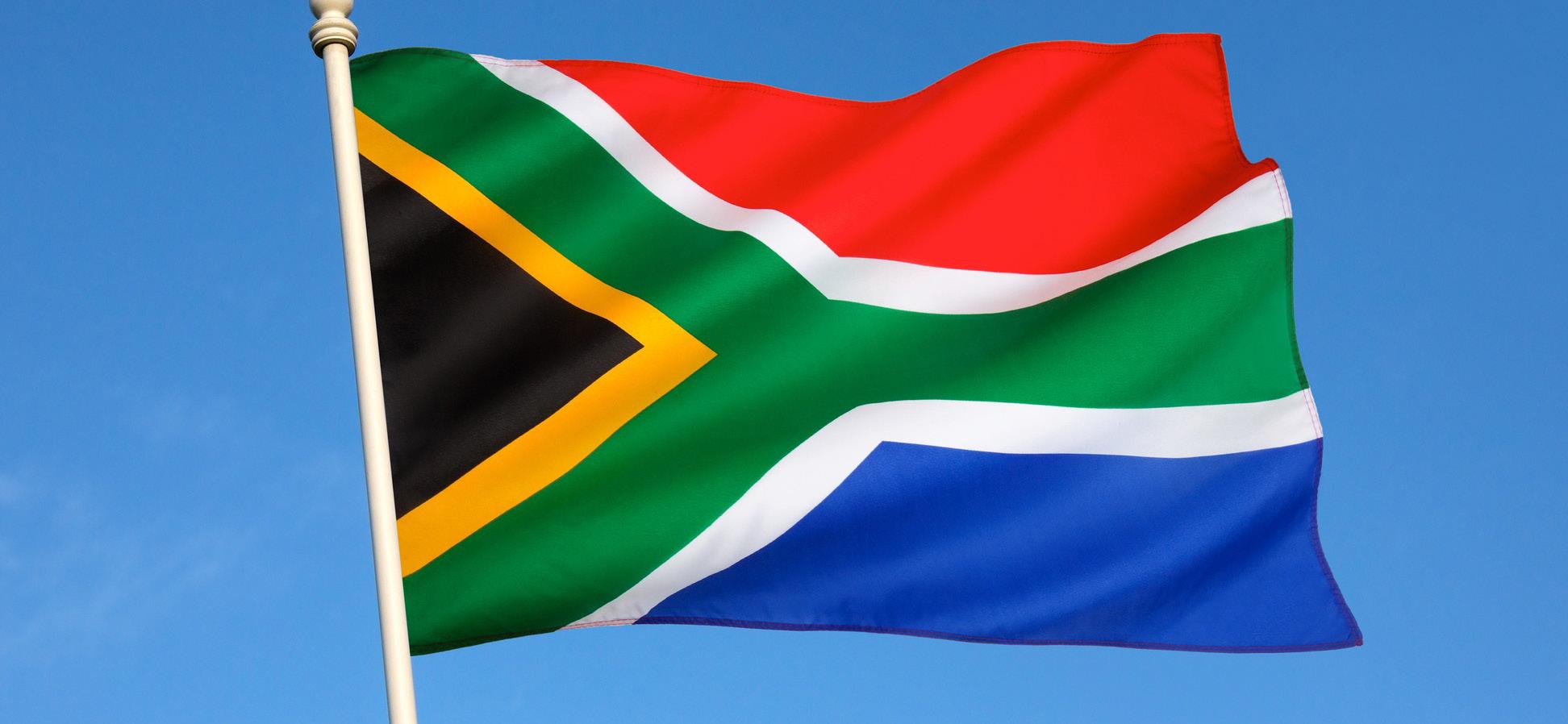
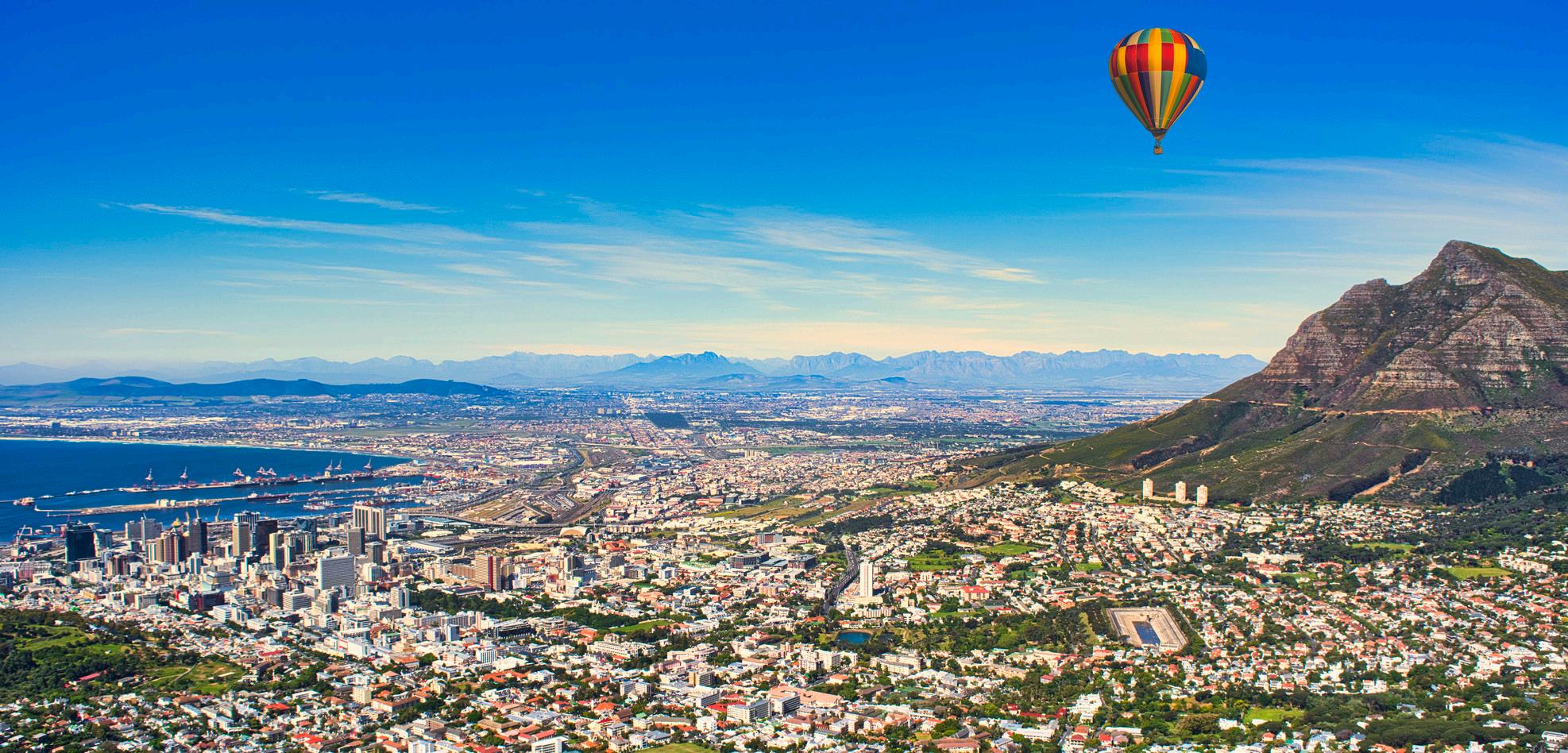

We at ingo PEACE. are planning events, meetings, and other opportunities to meet directly with you at the G20 Summit in 2025.
We look forward to seeing you in South Africa.
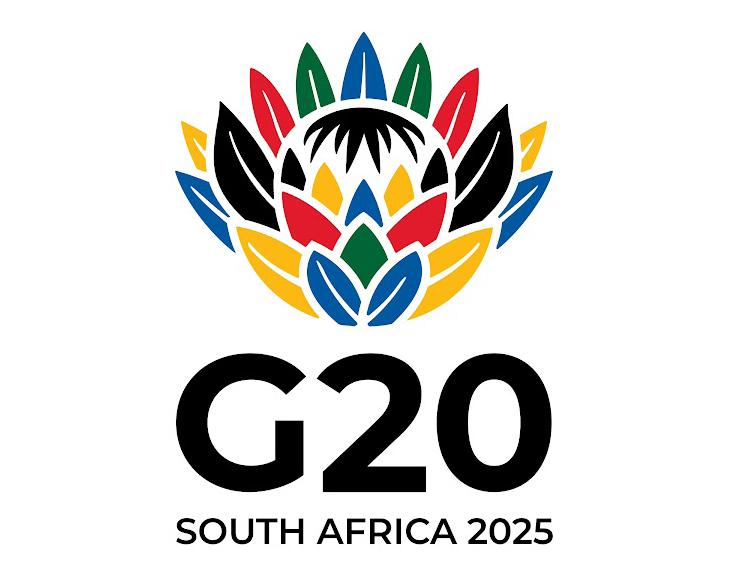




1. We, the Leaders of the G20, met in Rio de Janeiro on 18-19 November 2024 to address major global challenges and crises and promote strong, sustainable, balanced, and inclusive growth. We gather in the birthplace of the Sustainable Development Agenda to reaffirm our commitment to building a just world and a sustainable planet, while leaving no one behind.
2. We reaffirm the role of the G20 as the premier forum for international economic cooperation. Together, we share a collective responsibility for the effective stewardship of the global economy, fostering the conditions for sustainable, resilient and inclusive global growth. We remain committed to support developing countries in responding to global crises and challenges and achieving the Sustainable Development Goals.
3. We live in times of major geopolitical, socioeconomic, and climate and environmental challenges and crises, which require urgent action. With only six yea left to achieve the Sustainable Development Goals (SDGs) of the 2030 Agenda, progress towards only 17% of the SDG targets is on track, nearly half are showing minimal or moderate progress, and progress on over one third has stalled or even regressed. The G20 is well suited to address those challenges through much needed international cooperation and political drive. As Leaders of the G20, we recognize that the crises we face do not affect the world equally,disproportionally burdening the poorest and those already in vulnerable situations.
4. We recognize that inequality within and among countries is at the root of most globalchallenges that we face and is aggravated by them. We will accelerate our efforts and reaffirm our strong commitment to the Sustainable Development Goals. The world requires not only urgent action, but also socially just, environmentally sustainable and economically sound measures. For that reason, we work, in 2024, under the motto “Building a just world and a sustainable planet” –placing inequality, in all its dimensions, at the center of the G20 agenda.
5. We observe good prospects of a soft landing of the global economy, although multiple challenges remain and some downside risks have increased amid elevated uncertainty. We will continue to foster strong, sustainable, balanced and inclusive growth, address cost of living pressures, safeguard fiscal sustainability and mitigate negative spillovers. Our central banks remain strongly committed to achieving price stability in line with their respective mandates. Our fiscal policies will safeguard fiscal sustainability and rebuild buffers, remain growth-friendly, and catalyze public and private investments towards productivity enhancing reforms. We are reassured by the fact that economic activity has proved to be more resilient than expected in many parts of the world and that global inflation is coming down from elevated levels, although there is some variation across countries. Still, growth has been highly uneven across countries, contributing to the risk of economic divergence. We are concerned that medium and long-term global growth prospects are below historical averages. We will continue to strive to reduce growth disparities across countries through structural reforms. We reaffirm the April 2021 exchange rate commitment made by our Finance Ministers and Central Bank Governors. We also reaffirm our commitment to promote an open, resilient, inclusive, and stable financial system, which supports economic growth, and is grounded in full, timely and consistent implementation of agreed international standards, supported by on-going policy coordination. We reiterate our commitment to further promote sustainable capital flows and fostering sound policy frameworks, notably central bank independence.
6. We note with distress the immense human suffering and the adverse impact of wars and conflicts around the world.
7. Concerning the ongoing conflicts and wars, we reiterate our national positions andresolutions adopted at the UN Security Council and the UN General Assembly andunderscore that all states must act in a manner consistent with the Purposes and Principles of the UN Charter in its entirety. In line with the UN Charter, all states must refrain from the threat or use of force to seek territorial acquisition against the →
→ territorial integrity and sovereignty or political independence of any state. We affirm that all parties must comply with their obligations under international law, including international humanitarian law and international human rights law, and in this regard condemn all attacks against civilians and infrastructure.
8. While expressing our deep concern about the catastrophic humanitarian situation in the Gaza Strip and the escalation in Lebanon, we emphasize the urgent need to expand the flow of humanitarian assistance and to reinforce the protection of civilians and demand the lifting of all barriers to the provision of humanitarian assistance at scale. We highlight the human suffering and negative impacts of the war. Affirming the Palestinian right to self-determination, we reiterate our unwavering commitment to the vision o the two- State solution where Israel and a Palestinian State live side by side in peace within secure and recognized borders, consistent with international law and relevant UN resolutions. We are united in support for a comprehensive ceasefire in Gaza in line with UN SecurityCouncil Resolution n. 2735 and in Lebanon that enables citizens to return safely to their homes on both sides of the Blue Line.
9. Specifically concerning the war in Ukraine, while recalling our discussions in New Delhi, we highlight the human suffering and negative added impacts of the war with regard to global food and energy security, supply chains, macrofinancial stability, inflation and growth. We welcome all relevant and constructive initiatives that support a comprehensive, just, and durable peace, upholding all the Purposes and Principles of the UN Charter for the promotion of peaceful, friendly, and good neighborly relations among nations.
10. We recommit to advancing the goal of a world free of nuclear weapons and a safer place for all and will uphold our obligations in this regard.
11. We condemn terrorism in all its forms and manifestations.
12. The peaceful resolution of conflicts and efforts to address crises as well as diplomacy

and dialogue are critical. Only with peace will we achieve sustainability and prosperity.
13. To guide our actions towards concrete results, the Brazilian G20 Presidency has focused this year’s work on three priorities: (i) social inclusion and the fight against hunger and poverty; (ii) sustainable development, energy transitions and climate action; and (iii) the reform of global governance institutions.
14. The advances towards reducing poverty and eradicating hunger have suffered significant setbacks since the COVID-19 pandemic. The number of people facing hunger has increased, reaching the staggering figure of around 733 million
people in 2023, with children and women being the most affected. These unprecedented challenges call for greater and more effective commitment, financing, and actions at all levels and soundeconomic policies to foster growth and job creation.
15. The world produces more than enough food to eradicate hunger. Collectively, we do not lack knowledge nor resources to fight poverty and defeat hunger. What we need ispolitical will to create the conditions to expand access to food. In light of this, we have launched the Global Alliance against Hunger and Poverty and welcome its innovative approach to mobilizing finance and knowledge sharing to support the implementation of country-led, countryowned, large-scale and evidence-based programs aiming at reducing
Agriculture is at the forefront of addressing key challenges,such as fighting poverty, ending hunger, improving nutrition, while confronting climatechange, biodiversity loss, pollution and desertification. While recognizing there is no onesize-fits-all solution to the challenges of agriculture and food systems, we commit to support developing countries to enhance their capacity for sustainable food productionand marketing. hunger and poverty worldwide. We invite all countries, international organizations, multilateral development banks, knowledge centers and philanthropic institutions to join the Alliance so we can accelerate efforts to eradicate hunger and poverty while reducing inequalities and contributing to revitalizing global partnerships for sustainable development. The Alliance champions proven strategies such as cash transfers, development of homegrown school feeding programs, improving access to microfinance and the formal financial system and social protection, among other strategies that can be adapted to each country’s national circumstances.
16. We underscore the G20 commitment to the importance of food security and nutrition and of the progressive realization of the right to adequate food as reaffirmed through the Deccan High-Level Principles. Agriculture is at the forefront of addressing key challenges, such as fighting poverty, ending hunger, improving nutrition, while confronting climate change, biodiversity loss, pollution and desertification. While recognizing there is no onesize- fits-all solution to the challenges of agriculture and food systems, we commit to support developing countries to enhance their capacity for sustainable food production and marketing. We also renew our
commitment to work towards sustainably increasing agricultural productivity and reducing food loss and waste including by increasing our efforts to achieve the UN SDG 12.3 target on food losses and waste. In light of the dynamic interplay of global agriculture and food trade, we recognize the interdependence of countries in achieving food security and nutrition, food safety, and sustainability through open trade policies consistent with WTO rules. While recognizing the importance of domestic production, diversifying international, regional and local supply roots is also an important way to strengthen the resilience of world food supply chains to external shocks. We also aim to address the challenges of fertilizer shortages, including through strengthening local production, trade, increase fertilizer efficiency, and utilize biofertilizers while addressing the need to improve soil health and minimize water pollution.
17. We call for speedy implementation of the G20 2023 Action Plan on Accelerating Progress on the SDGs. We further commit to enhancing additional tools and mechanisms to fight inequalities, such as scaling up development cooperation, including North-South, South-South, and triangular cooperation, as well as the unlocking of resources through multilateral development banks and innovative financial tools and mechanisms, such as blended finance, that can promote sustainable flows of concessional resources, with clear allocation frameworks to support low- and middle-income countries most in need. We call on all partners to mobilize new and additional domestic and international resources from all sources to meet that challenge, while at the same time increasing their effectiveness. We also note the importance of transparency and mutual accountability. We remain committed to the United Nations Development Agenda and look forward to the success of the 4th International Conference on Financing for Development, in Seville, Spain in 2025. We also reaffirm our commitment to help developing countries better integrate into the global industrial, value and supply chains and accelerate their industrialization and modernization process, as part of our efforts to promote sustainable development and to fight inequalities.
18. We reaffirm our shared commitments and our dedication to lead by example in the global efforts against corruption and related illicit financial flows. We acknowledge the impact of corruption on global challenges such as poverty, social and economic inequality, as well as sustainable development, and recognize that anti corruption and integrity promotion can contribute to building a just world and a sustainable planet. We will make the best use of GlobE Network and other international anti-corruption networks.
19. We endorse the Rio de Janeiro G20 Ministerial Declaration on International Tax Cooperation. Progressive taxation is one of the key tools to reduce domestic inequalities, strengthen fiscal sustainability, foster budget consolidation, promote strong, sustainable, balanced, and inclusive growth and facilitate the achievement of the SDGs. We applaud domestic tax reforms carried out by several G20 members to tackle inequalities and promote fairer and more progressive tax systems recently and recognize that improving domestic resource mobilization is important to support the SDGs.
20. With full respect to tax sovereignty, we will seek to engage cooperatively to ensure that ultra-high-net-worth individuals are effectively taxed. Cooperation could involve exchanging best practices, encouraging debates around tax principles, and devising antiavoidance mechanisms, including addressing potentially harmful tax practices. We look forward to continuing to discuss these issues in the G20 and other relevant forums, counting on the technical inputs of relevant international organizations, academia, and experts. We encourage the Inclusive Framework on BEPS (IF) to consider working on these issues in the context of effective progressive tax policies.
21. We welcome the progress made on the Two-Pillar Solution under the IF. We reiterate our commitment to the October 2021 Statement of the IF and to the swift implementation of the Two-Pillar Solution by all interested jurisdictions, including expeditious negotiations on the final package of Pillar One. Our international tax cooperation should be inclusive and effective and aimed at reaching broad consensus, maximizing synergies among the →

→ existing international fora, while seeking to avoid unnecessary duplication of efforts. Wecontinue constructive discussion at the United Nations on the development of a Framework Convention on International Tax Cooperation and its protocols.
22. We recognize the constraints faced by many countries in implementing large-scale policies, including those to eradicate hunger and reduce poverty. It is imperative that those who are most in need receive greater support, ensuring that no one is left behind. We recognize the need to scale up resources from all sources for the fight against hunger and poverty and, in support of this and other development goals, aim to reach a robust and impactful IDA 21 replenishment, including an expansion of its donor country base and continued support from existing donors, as well as the replenishment of other important regional instruments such as the African Development Fund.
23. We recognize that market fluctuations, tight financial conditions, and debt vulnerabilities, among others, could be adding near-term pressure on strained public budgets amid increasing financing
costs. We believe that country-specific solutions to development financing challenges could be based on combined policy measures that support growth, domestic resource mobilization, capacity building, private capital flows, and targeted concessional financing. In this context, we call on the international community to make efforts to support vulnerable countries facing near-term liquidity challenges whose debt is sustainable. We encourage the IMF and World Bank to continue their work related to feasible options which are country-specific and on a voluntary basis to help those countries and report back to G20 Finance Ministers next year.
24. We acknowledge that inequalities have an inter-generational impact, as the unequal social mobility, opportunities and outcomes of a generation directly influence those of the next. All people, irrespective of age, sex, disability, race, ethnicity, origin, religion, or economic or other status, should have access to essential services to meet their basic needs, to decent work and to other social and economic opportunities that ensure their full, equal, effective and meaningful participation in society. Reducing inequality
is pivotal for achieving strong, sustainable, balanced, and inclusive growth. We encourage countries to lead by example by adopting further measures to promote inequality reduction, in accordance with national circumstances. We are striving to promote the social, economic, and political inclusion and empowerment of all, including by eliminating discriminatory laws,policies, and practices and promoting appropriate legislation, policies, and action in this regard, in particular on combating racism and promoting ethnic and racial equality. We recognize the significant role of financial inclusion in improving financial wellbeing and achieving the SDGs.
25. We reiterate the central coordinating role of the World Health Organization (WHO) in the global health architecture, supported by adequate, predictable, transparent, flexible and sustainable financing. We support the conducting of the WHO Investment Round as an additional measure for financing the WHO activities. We remain committed to building more resilient, equitable, sustainable, and inclusive health systems for the provision of integrated people-centered health services, including mental health, and to achieve Universal Health Coverage, focusing on improving essential health services and health systems to better than pre-pandemic levels in the next one to two years. We support strengthening health workforce training, including through the WHO Academy. We welcome the establishment of a Coalition for Local and Regional Production, Innovation and Equitable Access centered on voluntary cooperation in order to promote access to vaccines, therapeutics and diagnostics, and other health technologies for neglected diseases and persons in vulnerable situations. We also reaffirm our commitment to ending the epidemics of AIDS, tuberculosis, malaria, and for polio eradication. We emphasize advancing a One Health approach, recognizing the interlinkages between human, animal, plant, and environmental health, and the necessity to address antimicrobial resistance. We recognize the potential role of evidence-based traditional and complementary medicine. We will promote coordination and advance discussions on scaling up investments in health-related SDGs and Prevention, →






























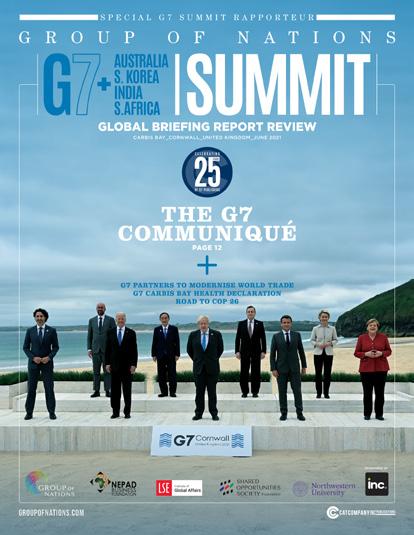














































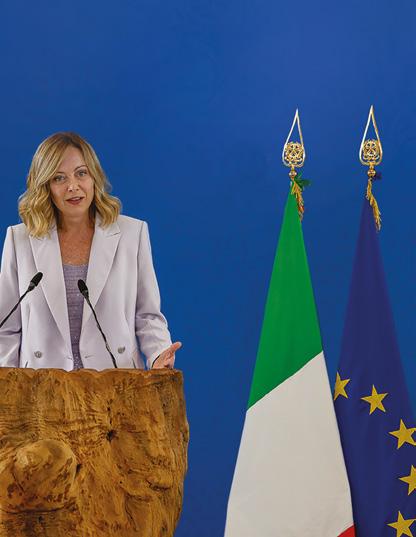



→ Preparedness, and Response to pandemics, and, in this regard, recognize the contribution of the Pandemic Fund and other financing initiatives. We encourage further contributions to the Pandemic Fund from a diversified donor base to achieve the new funding goal. We support the conclusion of the ongoing negotiations to draft and negotiate a WHO convention, agreement, or other international instrument on pandemic prevention, preparedness and response, which aims tocomplement the International Health Regulations (IHR), with full respect for sovereignty of individual States. We reiterate our commitment to an instrument that is ambitious, balanced, effective and fit-forpurpose, including equitable access to medical countermeasures during pandemics. In the context of the current mpox outbreak, we emphasize the importance of global coordination to address this and other emerging and
reemerging public health emergencies, and in this regard welcome the work of the G20 Joint Finance and Health Task Force and ask it to report on its progress by 2025.
26. We acknowledge that access to safe drinking water, sanitation, and hygiene is a prerequisite to health and nutrition and is critical to sustainable development outcomes. In this regard, mobilizing resources to build sustainable and resilient water and sanitation systems is essential for a healthier and more equitable future for all. We, therefore, support the promotion of water, sanitation, and hygiene (WASH) systems that are inclusive, integrated, sustainable, and gender-responsive to build resilience to the impacts of biodiversity loss, climate change, environmental degradation, water-borne diseases, disasters, and pollution. To this end, we welcome the Call to Action on Strengthening Drinking Water and Sanitation and Hygiene Services.
27. We emphasize the critical role of quality education and training, including digital education, as an enabler for human dignity and empowerment; equity, equality, and inclusiveness; sustainable and socioeconomic growth; active citizenship, prosperity, peace and well-being. We note with concern the current global teacher shortage. Professional development policies capable of qualifying and retaining teachers and of stimulating the interest of earlycareer teachers have become an essential component of the multidimensional challenge of preparing our societies for the future ahead.
28. We recognize culture’s power and intrinsic value in nurturing solidarity, dialogue, collaboration and cooperation, fostering a more sustainable world, in all dimensions and from all perspectives. We commit to the principles of inclusion, social participation and accessibility, for the full
exercise of cultural rights, confronting racism, discrimination and prejudice, and call for a strengthened and effective global engagement on the discussion of copyright and related rights in the digital environment and the impacts of AI on copyright right holders. We encourage countries to enhance international cooperation, collaboration and exchange towards the development of the creative economy. We reaffirm our commitment to the relevant UNESCO culture conventions. We reaffirm our commitment to support policies that promote the contribution of those working in the culture, arts and heritage sectors and call on countries to strengthen cooperation and dialogue addressing social and economic rights and artistic freedom, both online and offline, in accordance with intellectual property rights frameworks and international labor standards, for the enhancement of fair pay and decent working conditions. We encourage strengthening the protection of cultural heritage, including historical monuments and religious sites. We call for support of open and inclusive dialogue on the return and restitution of cultural property, including illegally exported property, building on a broad historical perspective that renews relationships between countries while enabling alternative dispute resolution mechanisms, as appropriate. We acknowledge the increased recognition of the value of the return and restitution of cultural property to countries and communities of origin based on the consent between the relevant parties.
29. We commit to harness the potential of digital and emerging technologies to reduceinequalities. We recognize that digital inclusion requires universal and meaningful connectivity and that digital government solutions are key to improve people’s lives while protecting privacy, personal data, human rights and fundamental freedoms. We acknowledge the contribution of digital public infrastructure to an equitable digitaltransformation and recognize the transformative power of digital technologies to bridge existing divides and empower societies and individuals including all women and girls and people in vulnerable situations. We recognize that digital platforms have reshaped the digital ecosystem and online interactions by
We encourage countries to enhance international cooperation, collaboration and exchange towards the development of the creative economy. We reaffirm our commitment to the relevant UNESCO culture conventions.
amplifying information dissemination and facilitating communication within and across geographical boundaries. However, the digitization of the information realm and the accelerated evolution of new technologies, such as artificial intelligence (AI), has dramatically impacted the speed, scale and reach of misinformation and disinformation, hate speech and other forms of online harms. In this sense, we emphasize the need for digital platformsˋ transparency and responsibility in line with relevant policies and applicable legal frameworks and will work with platforms and relevant stakeholders in this regard. Transparency, with appropriate safeguards, and explainability regarding data, algorithms and content moderation that respects intellectual property rights and privacy, and data protection can be key for building healthy information ecosystems. In the context of data sharing, we reaffirm the importance of enabling cross-border data flows and data free flow with trust, while respecting domestic as well as international applicable legal frameworks and acknowledging the role of data for development.
30. We welcome the inaugural convening of the G20 Research and Innovation Working Group in 2024 and reaffirm the importance of open, fair, diverse, and mutually beneficial international cooperation in research and innovation. This cooperation can be facilitated by using tools such as open innovation, which has now been defined by the G20 Research and Innovation Ministers, plus open science, research infrastructures as appropriate, voluntary technology transfer and co-development of capacities on
mutually agreed terms, exchanges of researchers, scientists, and resources around the world, science and technology assistance to developing countries, and enhanced science communication. We further acknowledge the need to reduce global inequalities and asymmetries in the access and production of science, technology, and innovation.
31. We recognize the importance of creating quality jobs and promoting decent work for all to achieve social inclusion. We reaffirm our commitments to (i) protect workers’ rights as described in the International Labour Organization’s Declaration on Fundamental Principles and Rights at Work, empowering workers and eradicating forced labor, ending modern slavery and human trafficking as well as eliminating all forms of child labor; (ii) to ensure occupational safety and health and access to adequate social protection for all workers; (iii) to focus our efforts and policies on guaranteeing a just transition in all sectors; (iv) to bridge digital divides and prioritize the inclusion of people in vulnerable situations; (v) to develop and implement comprehensive policies that dismantle discriminatory social and cultural norms as well as legal barriers to ensure women’s equal, full and meaningful participation in our economies, and (vi) to promote social dialogue and collective bargaining.
32. We celebrate the inaugural convening of the G20 Empowerment of Women WorkingGroup in 2024 and reaffirm our full commitment to gender equality and the empowerment of all women and girls. We encourage women-led development and will promote the full, equal, effective and meaningful participation and leadership of women in all sectors and at all levels of the economy, which is crucial to the growth of global GDP. We recognize that all women and girls face particular barriers because of various factors, such as lackof access to health care, education, career development, equal pay, and leadership opportunities.
Acknowledging that gender-based violence, including sexual violence against women and girls, is alarmingly high across public and private spheres, we condemn every form of discrimination against women and girls and recall our commitment to end genderbased violence including sexual violence →
→ and combat misogyny online and offline. We commit to promoting gender equality in paid and unpaid care work to ensure equal, full and meaningful participation of women in the economy, by promoting social and gender co-responsibility, encouraging and facilitating men’s and boys’ equal involvement in care work and challenging gender norms that prevent equitable distribution and redistribution of caregiving responsibilities. As we approach the 30th anniversary of the Beijing Declaration and Platform for Action, we will strengthen our efforts to fulfill its implementation, including the outcome documents of its review conferences. We commit to implementing the G20 Roadmap Towards and Beyond the Brisbane Goal and look forward to our Ministers developing proposals with a view to establishing new G20 commitments for the post-2025 period, in particular regarding closing the gender pay gap. We recognize the role of women as agents of peace.
33. As the world faces an unprecedented increase in the frequency of large-scale disasters, we recognize they disproportionately affect people in vulnerable situations, particularly low-
income groups, and exacerbate poverty and inequality. We commit to accelerating international disaster risk reduction cooperation in line with the Sendai Framework for Disaster Risk Reduction. We emphasize the critical role of a disaster preparedness approach and the need for investment in people, goods and infrastructure for disaster risk reduction.
34. We reaffirm our commitment to support migrants, including migrant workers and refugees in our efforts towards a more inclusive world, in line with national policies, legislations and circumstances, ensuring full respect for the human rights and their fundamental freedoms regardless of their migration status. We also recognize the importance of preventing irregular migration flows and the smuggling of migrants, as part of a comprehensive approach for safe, orderly and regular migration while responding to humanitarian needs and the root causes of displacement. We support strengthening cooperation between countries of origin, transit and destination. We will continue the dialogue on migration and forced displacement during future Presidencies.

35. We emphasize the role of sustainable development in its three dimensions –economic, social, and environmental – as a guiding principle for cooperation for people, planet and prosperity, with the ultimate goal of overcoming our collective challenges. We reaffirm our respective commitments to scale up urgent action to address the crises and challenges posed by climate change, biodiversity loss, desertification, ocean and land degradation, drought and pollution.
36. We reaffirm our strong commitment to multilateralism, especially in the light of the progress made under the UNFCCC and the Paris Agreement and reiterate our resolve toremain united in the pursuit of efforts to achieve the purpose and long-term goals of the Agreement. We understand and acknowledge the urgency and seriousness of climate change. We reaffirm the Paris Agreement temperature goal of holding the increase in the global average temperature to well below 2 degrees Celsius above pre-industrial levels and pursuing efforts to limit temperature increase to 1.5 degrees Celsius above preindustrial levels, recognizing that this would significantly reduce the risks and impacts of climate change. We underscore that the impacts of climate change will be much lower at the temperature increase of 1.5 degrees Celsius compared with 2 degrees Celsius and reiterate our resolve to pursue efforts to limit the temperature increase to 1.5 degreesCelsius.
37. We are determined to lead bold, timely and structural actions in our national economies and in the international financial system with a view to accelerating and scaling up climate action, in synergy with sustainable development priorities and efforts to eradicate poverty and hunger. Recognizing that the whole of our efforts will be more powerful than the sum of their parts, we will cooperate and join efforts towards a global mobilization againstclimate change.
38. Mindful of our leadership role, we reaffirm our steadfast commitments, in pursuit of the objective of UNFCCC, to tackle climate change by strengthening the
full and effective implementation of the Paris Agreement, reflecting equity and the principle of common but differentiated responsibilities and respective capabilities, in light of different national circumstances. We reiterate our commitment and will intensify our efforts to achieve global net zero greenhouse gas emissions/carbon neutrality by or around mid-century. We encourage each other to bring forward net zero GHG emissions/climate neutrality commitments in a nationally determined manner, taking into account the Paris Agreement and our different national circumstances, pathways and approaches.
39. We welcome and fully subscribe to the ambitious and balanced outcome of the UNClimate Change Conference in Dubai (COP28), in particular the UAE Consensus and its first Global Stocktake of the Paris Agreement (GST-1).
40. We will respond positively to the GST-1 encouragement for Parties to the Paris Agreement to come forward in their next nationally determined contributions withambitious, economy-wide emission reduction targets, covering all greenhouse gases, sectors and categories and aligned with limiting global warming to 1.5 C, as informed by the latest science, in the light of different national circumstances.
41. We acknowledge the need for urgent action to scale up, prioritize and mainstream whole of society and whole-of-economy adaptation in the wake of the widespread, significant, and growing impacts of climate change. We reaffirm that GST-1 called for urgent, incremental, transformational and country-driven adaptation action based on different national circumstances and for the enhancement of adaptation efforts in line with what is needed to achieve the goal in Article 2, paragraph 1(b) of the Paris Agreement.
42. We recognize the need for deep, rapid and sustained reductions in greenhouse gas emissions in line with 1.5 C pathways and call on members to contribute to the global efforts against climate change, in a nationally determined manner, taking into account the Paris Agreement and their different national circumstances, pathways and approaches, as addressed in GST-1.
We further recognize, as addressed in GST-1, that members should cooperate on promoting a supportive and open international economic system aimed at achieving sustainable economic growth and development in all countries and thus enabling them to better to address the problems of climate change, noting that measures taken to combat climate change, including unilateral ones, should not constitute a means of arbitrary or unjustifiable discrimination or a disguised restriction on international trade.
43. We underscore the need for increased international collaboration and support, including with a view to scaling up public and private climate finance and investment for developing countries, accelerating broadly accessible technological innovation, enhancing resilience and low-greenhousegas emissions pathways, and supporting ambitious green industrial planning and strategies. We reiterate the New Delhi Leaders Declaration recognition of the need for rapidly and substantially scaling up climate finance from billions to trillions from all sources.
44. Regarding sustainable finance, we continue to support the Sustainable Finance Roadmap and welcome the consensus achieved in the 2024 G20 Sustainable Finance Report. We recognize the importance of optimizing the operations of vertical climate and environmental funds, aligning them with countries’ needs, priorities, and strategies to enhance national ownership and maximize the impact of investments. We encourage these funds to work together, take concrete steps to unlock their full potential, and improve access, including through a common application and enhanced cooperation with MDBs and national development institutions. We underscore the importance of continuing the work on operationalizing just transitions, considering its economic, social and environmental dimensions and local circumstances, and advancing work to address challenges to Nature-Based Solutions (NbS) financing.
45. Underlining the importance of progress towards making finance flows consistent with a pathway towards low greenhouse gas emissions and climate-resilient →

→ development, we welcome the initiative taken by Brazil’s G20 Presidency to establish the Task Force on a Global Mobilization against Climate Change (TF-CLIMA), bringing together the Sherpa and Finance tracks, while helping further mainstream climate change into the global financial, economic and development agendas. Building on TF-CLIMA, we will cooperate and join efforts to identify and address structural barriers to foster private capital flows for climate action, particularly for developing countries. We recognize that relevant institutions should work to ensure that risks are well captured, including by exploring to increase the transparency of credit ratings and country risk assessments.
46. We will accelerate the reform of the international financial architecture so that it can meet the urgent challenge of sustainable development, climate change and efforts to eradicate poverty. We support the voluntary building-up of country platforms as one of the possible instruments to boost sustainable finance in emerging markets and developing economies. Platforms that are country-led, flexible, and well adapted to national circumstances work as efficient instruments to mobilize both public and private capital to finance projects and programs in developing countries, helping match mitigation, adaptation, and resiliencebuilding challenges with concrete flows of resources for just transitions.
47. We look forward to a successful New Collective Quantified Goal (NCQG) outcome in Baku. We pledge our support to the COP29 Presidency and commit to successful negotiations in Baku. We also pledge our support to the COP30 Presidency, in 2025.
48. We commit to accelerating clean, sustainable, just, affordable and inclusive energy transitions, in line with SDG7, the Paris Agreement and the outcome of the GST-1, adopted at the UN Climate Change Conference in Dubai (COP28), that leave no one behind, especially the poor and those in vulnerable situations, taking into account different national circumstances.
49. We support the implementation of efforts to triple renewable energy capacity globally and double the global average annual rate of energy efficiency
We reiterate our commitment in the New Delhi Leaders’ Declaration to increase our efforts to implement the commitment made in 2009 in Pittsburgh to phase-out andrationalize, over the medium term, inefficient fossil fuel subsidies that encourage wastefulconsumption and commit to achieve this objective, while providing targeted support for the poorest and the most vulnerable.
improvements globally through existing targets and policies, similarly support the implementation with respect to other zero and low-emission technologies, including abatement and removal technologies in line with national circumstances by 2030. Furthermore, we recognize the need to catalyze and scale up investment from all financial sources and channels for bridging the funding gap for energy transitions globally, especially in developing countries. Reaffirming that developing countries need to be supported in their transitions to low carbon emissions, we will work towards facilitating low-cost financing for them. We acknowledge the important role of domestic energy planning, capacity building, policy strategies and frameworks, as well as cooperation between different levels of government, in creating enabling environments to attract financing for energy transitions.
50. We reiterate our commitment in the New Delhi Leaders’ Declaration to increase our efforts to implement the commitment made in 2009 in Pittsburgh to phase-out andrationalize, over the medium term, inefficient fossil fuel subsidies that encourage wasteful consumption and commit to achieve this objective, while providing targeted support for the poorest and the most vulnerable.
51. We underscore the crucial role of technologically neutral, integrated, and inclusive approaches to develop and deploy a variety of low-emitting energies, sustainable fuels and technologies, including for abatement and removal, carbon management, and emission reduction, with a view to creating scale and global markets to accelerate energy transitions, particularly in hard-to-abate sectors. We encourage, as appropriate, the use of mutually recognized methodologies and standards for assessing greenhouse gas emissions.
52. We support reliable, diversified, sustainable and responsible supply chains for energy transitions, including for critical minerals and materials beneficiated at source, semiconductors and technologies. We note the work of experts convened under the UN Secretary General’s Panel on Critical Energy Transition Minerals.
53. We commit to accelerate efforts to achieve universal access to clean cooking by 2030, including through formulation and implementation of enabling policies and provision and mobilization of financial and technological support from all sources to developing countries in order to increase the annual investments and support the affordability of clean cooking projects.
54. We endorse the voluntary “Principles for Just and Inclusive Energy Transitions” adopted by the G20 Energy Transitions Working Group and, in line with national circumstances, take them into account when devising and implementing domestic policies to pursue energy transitions.
55. We reaffirm the commitment to the swift, full, and effective implementation of the Kunming-Montreal Global Biodiversity Framework (KM-GBF) adopted at the COP15 to the Convention on Biological Diversity (CBD), and encourage other countries to do the same. We stress the importance of Parties to the CBD updating or revising national biodiversity strategies and action plans in alignment with the KM-GBF and its goals and targets as soon as possible and we call for enhanced financial resources from all sources. We look forward to a successful conclusion of the sixteenth session of the Conference of the Parties (COP16) of the United Nations

Convention to Combat Desertification (UNCCD) that will take place in Riyadh in December 2024.
56. Recognizing that forests provide crucial ecosystem services, as well as for climate purposes acting as sinks, we stress the importance of scaling up efforts to protect, conserve and sustainably manage forest and combat deforestation, including through enhanced efforts towards halting and reversing deforestation and forest degradation by 2030, highlighting the contributions of these actions for sustainable development and taking into account the social and economic challenges of local communities as well as Indigenous Peoples. In the context of forests, we will avoid discriminatory green economic policies, consistent with WTO rules and multilateral environmental agreements. We are committed to mobilizing new and additional finance for forests from all sources, including concessional and innovative financing for developing countries. We encourage innovative mechanisms that seek to mobilize new and diverse sources of funding to pay for ecosystem services. As such, we take note of the plans to establish the Tropical ForestForever Facility (TFFF) and acknowledge the Facility as an innovative tool for forest conservation.
We reaffirm the G20 ambition to reduce land degradation by 50% by 2040 on a voluntary basis, as committed under the G20 Land Initiative. We will also take steps to prevent, manage, and address the negative impacts of droughts and extreme wildfires.
57. As the world’s largest economies, which generate at different levels, around 75% ofglobal waste and the majority of the global consumption of natural resources, noting the varying contributions and circumstances among countries, we reaffirm our commitment to significantly reduce the generation of waste, including unmanaged and poorly managed waste, through zero waste and other initiatives. We prioritize the prevention and, where not possible, the reduction, reuse and recycling of waste in support of a circular economy. We recognize the importance of embracing sustainable production and consumption patterns and mainstreaming Lifestyles for Sustainable Development (LiFE).
58. We are determined to end plastic pollution and commit to working together with the ambition to conclude by the end of 2024 the negotiations of an ambitious, fair and transparent international legally binding instrument on plastic pollution, including in the marine environment, based
on a comprehensive approach in line with the mandate of UNEA resolution 5/14, at the Fifth Session of the Intergovernmental Negotiating Committee (INC-5) in Busan, Republic of Korea.
59. Fully aware of the critical importance of the oceans and seas for sustainable development,we recognize that adequate financing and our increased efforts and appropriate planning and management are essential to ensure the protection of the marine environment and the conservation and sustainable use of marine resources and biodiversity. Building on the consensus we reached in New Delhi, we call on all countries for the early entry into force, and implementation by the Parties, of the Agreement under the United Nations Convention on the Law of the Sea on the Conservation and Sustainable Use of Marine Biological Diversity of Areas beyond National Jurisdiction (BBNJ Agreement), emphasizing the necessity of enhanced international cooperation, capacity-building, technical assistance, and financial support, particularly to developing countries. We willengage actively in the 3rd United Nations Ocean Conference in Nice in 2025. We lookforward to the continuation of the Oceans20 initiative in the future presidencies. →
→ 60. We express great satisfaction with the launch of the G20 Initiative on Bioeconomy (GIB) in 2024. Recognizing the remarkable potential of bioeconomy to contribute to building a sustainable future and fostering economic growth for all, we have decided on the ten voluntary, non-binding High-Level Principles on Bioeconomy, which aim to outline how this innovative complementary productive paradigm can and should be economically, socially, and environmentally sustainable. We recognize the potential for further cooperation and welcome the decision of South Africa to continue the work of the GIB in the next G20 Presidency of the group.
61. There will be no sustainability nor prosperity without peace. We know the horrors and suffering produced by all wars. To reap the benefits of our joint efforts to promote sustainable development in all its dimensions – social, economic and environmental – we need to better equip the world with a reformed global governance. The G20 was born out of financial and economic crises, and we managed to work together to overcome them. Now we confront a multifaceted crisis, in which political and geopolitical tensions imperil our capacity to address challenges such as the promotion of growth, the reduction of poverty, and the fight against climate change.
62. The challenges the global community faces today can only be addressed through multilateral solutions for a better tomorrow and the strengthening of global governance for both present and future generations. In order to deliver on the promises of the United Nations and other relevant international organizations around the world, we pledge to work for a reinvigorated and strengthened multilateral system, rooted in the purposes and principles of the UN Charter and international law, with renewed institutions and a reformed governance that is more representative, effective, transparent and accountable, reflecting the social, economic and political realities of the 21st century.
63. We commit to invigorate the General Assembly through the strengthening of its

role, as the chief deliberative, policymaking and representative organ of the United Nations, to uphold the purposes and principles of the UN Charter, including on questions relating to the maintenance of international peace and security, through an improved and intensified interaction with the Security Council. We also commit to invigorate the Assembly through transformative procedures and practices that recognize its authority and enhance its effectiveness and efficiency, in line with the UN Charter, and increased nominations ofwomen candidates for President of the General Assembly.
64. We pledge to reform the Security Council through a transformative reform that aligns it with the realities and demands of the 21st century, makes it more representative, inclusive, efficient, effective, democratic and accountable, and more transparent to the whole of the UN membership, allowing for better responsibility sharing among all its members, while improving the effectiveness and transparency of its working methods. We call for an enlarged Security Council composition that improves the representation of the underrepresented and unrepresented regions and groups, such as Africa, Asia-Pacific and Latin America and the Caribbean.
65. We pledge to strengthen the Economic and Social Council (ECOSOC) through greater synergies and coherence with UN Agencies, Funds and Programs to better promote sustainable development in its three dimensions and to assist member states in achieving the SDGs. We commit to increased ECOSOC coherence and enhanced engagement with international financial institutions, particularly within the High-Level Political Forum, and forums for international economic cooperation, such as the G20, while respectingexisting governance mechanisms and mandates independent of the United Nations.
66. We commit to strengthen the Peacebuilding Commission through an enhanced role in proactively addressing the underlying causes and drivers of conflicts and by mobilizing political and financial support for national prevention, sustaining peace and peacebuilding efforts, in particular to avoid possible relapse into conflict, in accordance with the Commission’s mandate.
67. We will work towards a more representative UN Secretariat through transparency, equitable geographical distribution, rotation of nationalities,
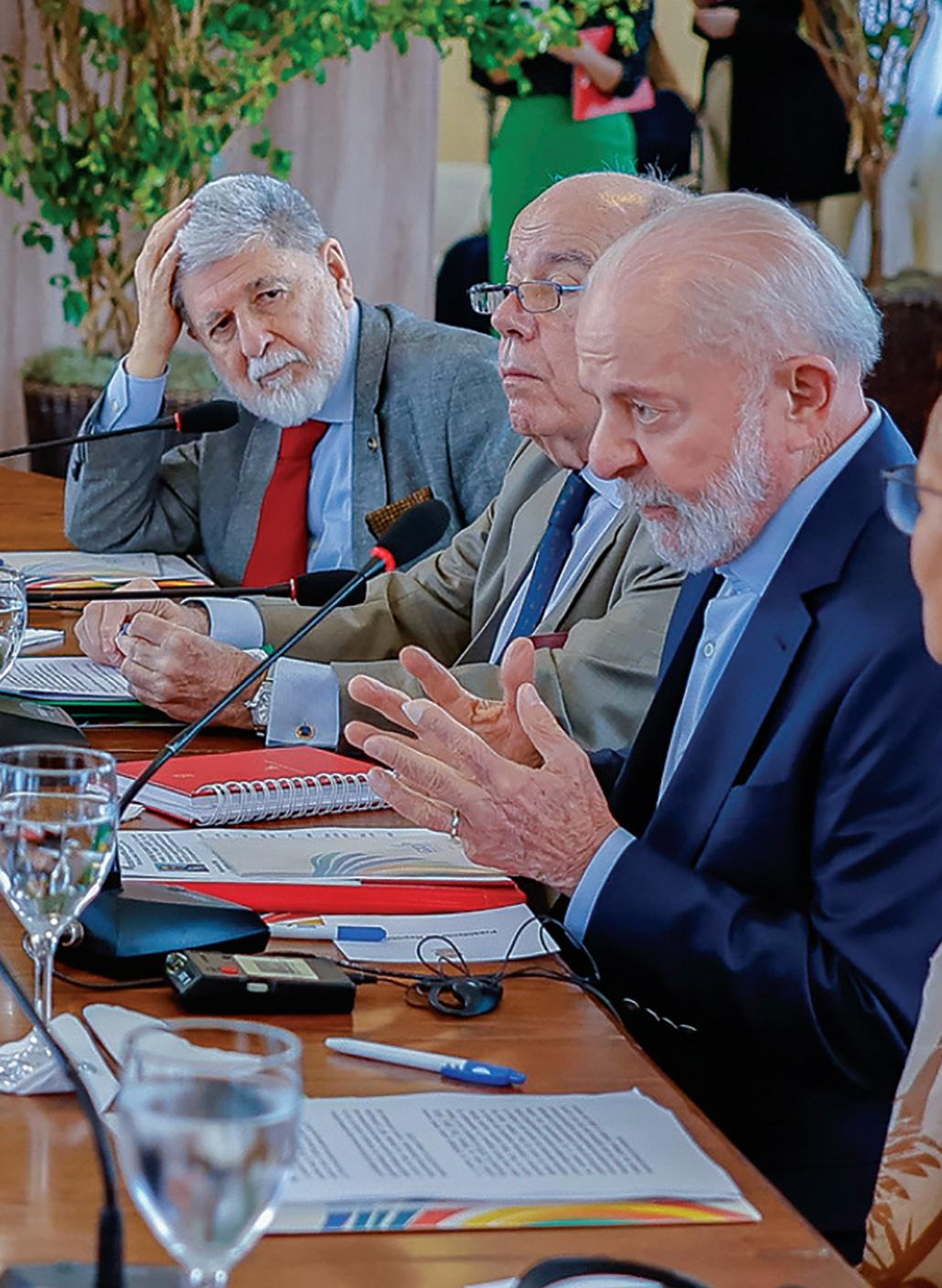
68. In order to promote the reform of the United Nations that will allow us to live up to our shared goals, we will work together with all the UN membership in the spirit of the G20 Call to Action on Global Governance Reform.
countries. We look forward to the pcoming International Bank for Reconstruction and Development 2025 Shareholding Review, in line with the Lima Shareholding principles.
We commit to strengthen the Peacebuilding Commission through an enhanced role inproactively addressing the underlying causes and drivers of conflicts and by mobilizingpolitical and financial support for national prevention, sustaining peace and peacebuildingefforts, in particular to avoid possible relapse into conflict, in accordance with the Commission’s mandate.
merit and gender balance in filling positions, and increasing the nomination of women for senior positions, including SecretaryGeneral, while reaffirming that no post should be considered the exclusive preserve of any member state or group of states.
69. Building on the legacy of previous G20 Presidencies, and the mandate we gave in New Delhi, we endorse the G20 Roadmap towards Better, Bigger, and More Effective Multilateral Development Banks (MDBs), which presents comprehensive recommendations and actions for MDBs to evolve their visions, incentive structures, operational approaches, and financial capacities, so that they are better equipped to maximize their impact in addressing a wide range of global and regional challenges, while accelerating progress towards the SDGs. While respecting each MDB’s mandate and governance structure, we call on the MDB’s, working alongside relevant stakeholders, to implement the G20 MDB Roadmap and encourage them to engage on a periodic reporting on the implementation progress. We welcome the implementation of the World Banks Group’s Evolution Roadmap and the reforms being undertaken by other MDBs. We also call on MDBs to continue working as a system, and to partner with governments, national and subnational development banks, insurance and reinsurance providers and the private sector. We appreciate the growing number of MDBs reporting on Capital Adequacy Framework (CAF) implementation and the progress made so far. We note that CAF measures still have the potential to unlock additional lending headroom over the next decade with further implementation still to come. We encourage MDBs to boost domestic resource mobilization and enhance private capital mobilization.
70. We reaffirm our commitment in the New Delhi Leaders’ Declaration to collectively mobilize more headroom and concessional finance to boost World Bank capacity to help low- and middle-income countries that need help in addressing global challenges, with a clear framework for the allocation of scarce concessional resources, and to provide strong support for the poorest
71. We underscore the need for enhancing the representation and voice of developing countries in decision-making in MDBs and other international economic and financial institutions, to deliver more effective, credible, accountable, and legitimate institutions. In that context, we welcome the creation of a 25th chair at the International Monetary Fund (IMF) Executive Board to enhance the voice and representation of Sub-Saharan Africa.
72. We reaffirm our commitment to a strong, quota-based, and adequately resourced IMF at the center of the global financial safety net. We acknowledge the urgency and importance of realignment in quota shares to better reflect members’ relative positions in the world economy while protecting the quota shares of the poorest members. We welcome the IMF Executive Board’s ongoing work to develop by June 2025 possible approaches as a guide for further quota realignment, including through a new quota formula, under the 17th General Review of Quotas. We stand ready to act constructively to help build momentum at the IMF Executive Board. We welcome the IMF Executive Board review of charges and surcharges and the review of Poverty Reduction and Growth Trust (PRGT) facilities and financing. These reviews are relevant steps and we will continue to support the Fund’s efforts to adapt to evolving circumstances.
73. We welcome the landmark achievement of the global ambition of USD 100 billion of voluntary contributions (in SDRs or equivalent) in pledges for countries most in need and call for the swift delivery of pending pledges. We will continue to invite countries that are willing and legally able to explore channeling Special Drawing Rights (SDRs) to MDBs, while respecting the reserve asset status of the resulting SDRdenominated claims and ensuring their liquidity, in order to strengthen MDBs´ financial capacity to support SDGs and address global challenges, including the goals of the Global Alliance against Hunger and Poverty. →
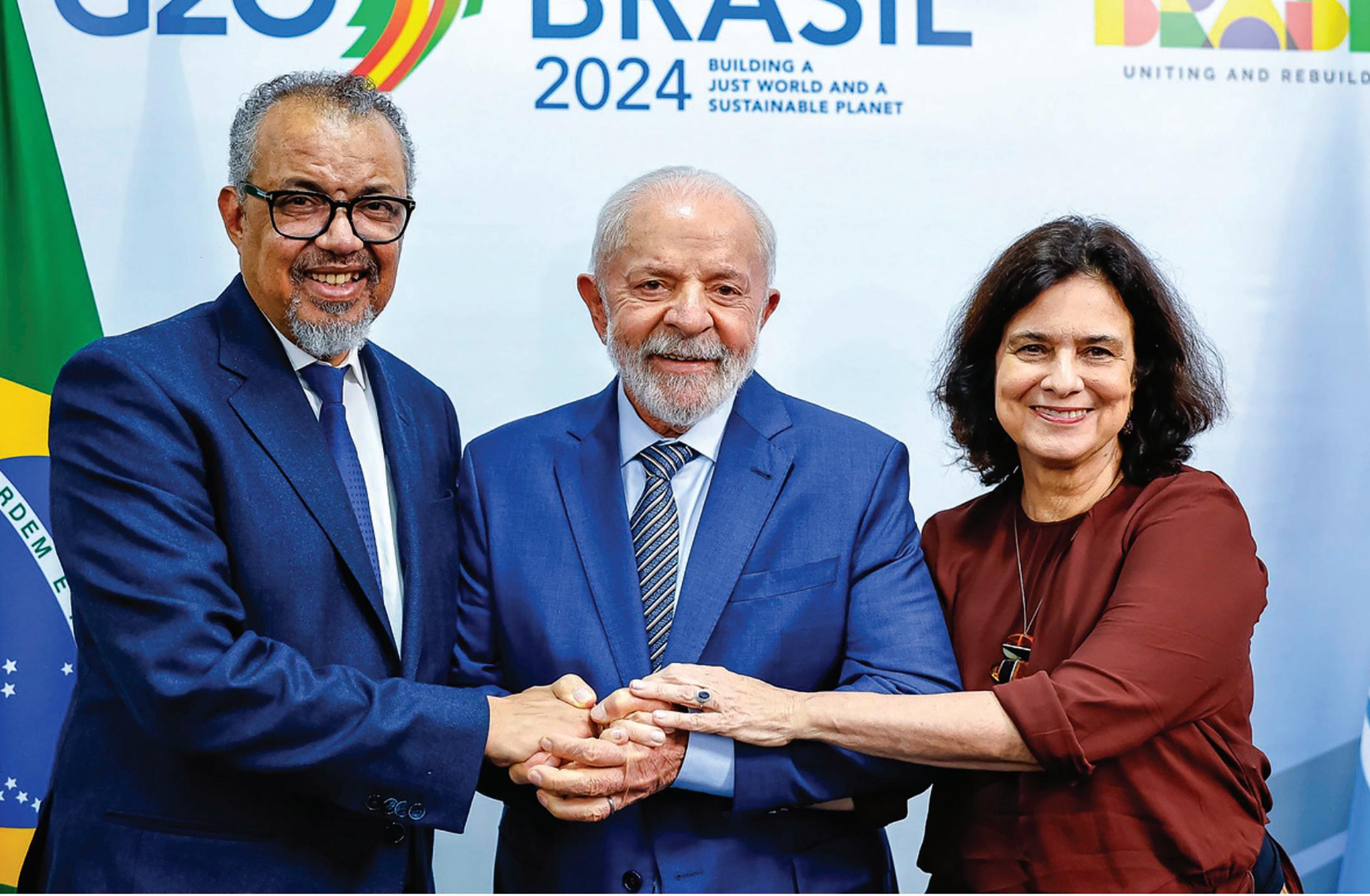
→ 74. We re-emphasize the importance of addressing debt vulnerabilities in low and middleincome countries in an effective, comprehensive and systematic manner. We welcome the progress made on debt treatments under the G20 Common Framework and beyond. We remain committed to addressing global debt vulnerabilities, including by stepping up the Common Framework’s implementation in a predictable, timely, orderly, and coordinated manner, informed by the G20 Note on the Lessons Learned from the First Cases Under the Common Framework. We continue to stand by all the commitments made in the Common Framework for Debt Treatments beyond the DSSI, including those in the second and final paragraphs. We welcome joint efforts by all stakeholders to continue working towards enhancing debt transparency and encourage private creditors to follow. We continue to support the Global Sovereign Debt Roundtable to further advance common understanding among key stakeholders, including the private sector, bilateral and multilateral creditors and debtor countries. We welcome the Africa-led debates on Debt, Development and Infrastructure convened by the Brazilian G20 Presidency in 2024.
75. International trade is an important
engine for inclusive economic growth, combating poverty and hunger and promoting sustainable development and the SDGs. Stressing the importance of ensuring that trade and sustainable development are mutually supportive, we endorse the G20 Principles on Trade and Sustainable Development to serve as guidelines for the design and implementation of measures related to trade and sustainable development. To enable trade and investment to fully realize its potential and act as a driver of global growth and prosperity, we emphasize the need to ensure a rules-based, non-discriminatory, fair, open, inclusive, equitable, sustainable and transparent multilateral trading system, with the WTO at its core. Ensuring a level playing field and fair competition consistent with WTO rules is essential to ensuring prosperity and fostering a favorable trade and investment environment for all. We reiterate the centrality of the development dimension of the WTO.
76. On the 30th anniversary of the Marrakesh Agreement, we reiterate our support to work towards the necessary reform of the WTO to improve all its functions, with a view to addressing current trade challenges and enabling trade to serve as an engine of growth and prosperity for all. We remain committed to conducting
discussions with a view to having a fully and well-functioning dispute settlement system accessible to all members by 2024.
77. The rapid progress of AI promises prosperity and expansion of the global digital economy. It is our endeavor to leverage AI for good and for all by solving challenges in a responsible, inclusive and human-centric manner, while protecting people’s rights and safety. To ensure safe, secure, and trustworthy AI development, deployment and use, the protection of human rights, transparency and explainability, fairness, accountability, regulation, safety, appropriate human oversight, ethics, biases, privacy, data protection and data governance must be addressed. We recognize the need to leverage the opportunities of AI, including Generative AI, while remaining mindful of its challenges. We will seek to promote a pro-innovation regulatory/governance approach to AI that will limit risks while enabling us to benefit from what it has to offer. To unlock the full potential of AI, equitably share its benefits, and mitigate risks, we will work together to promote international cooperation and further discussions on international governance for AI, recognizing the need to incorporate the voices of developed and developing countries. We recognize the role of the United Nations, alongside other existing fora, in promoting international AI cooperation, including to empower sustainable development. Acknowledging growing digital divides within and between countries, we call for the promotion of inclusive international cooperation and capacity building for developing countries in this domain and welcome international initiatives to support these efforts. We reaffirm the G20 AI principles and the UNESCO Recommendation on Ethics of AI.
78. We acknowledge that the development, deployment and use of emerging technologies, including artificial intelligence, can provide many opportunities to workers, but also poses ethical concerns and risks for their rights and well-being. As AI and other technologies continue to evolve, it is also necessary to bridge digital divides, including halving the gender digital divide
It is our endeavor to leverage AI for good and for all by solving challenges in a responsible, inclusive and human-centric manner, while protecting people’s rights and safety.
by 2030, prioritize the inclusion of people in vulnerable situations in the labor market, as well as ensure fairness respect for intellectual property, data protection, privacy, and security. We agree to advocate and promote responsible AI for improving education and health outcomes as well as women’s empowerment. We recognize that digital literacy and skills are essential to achieve meaningful digital inclusion. We recognize that technologies’ integration in the workplace is most successful when it incorporates the observations and feedback of workers and thus encourage enterprises to engage in social dialogue and other forms of consultation when integrating digital technologies at work. With this in mind, we welcome the decision of G20 Labor and Employment Ministers to establish guidelines for the safe, secure and trustworthy use of AI in the world of work, in collaboration with other relevant workstreams.
79. We look forward to the continuation of the work of the Digital Economy Working Group, as well as to discussions in the G20 in a High-Level Initiative/Task-Force on Artificial Intelligence and Innovation to support these efforts, under the South African Presidency.
80. We welcome the African Union as a full member of the G20. Africa’s voice should be amplified in the G20 and all other international fora. We reiterate our strong

support to Africa including through the Compact with Africa and the G20 initiative on supporting industrialization in Africa and LDCs, and support the African Union to realize the trade and economic integration and aspirations under its Agenda 2063 as it enters its second decade of implementation.
81. In 2024, the G20 continued to reinforce the group’s role as an inclusive and effective forum. We fostered an improved dialogue and articulation within the G20, bringing together the Sherpa and Finance tracks through an increased number of joint meetings, as well as by convening two additional joint task forces, which dealt with some of the key priorities of the Brazilian G20 Presidency: the fight against hunger and poverty and the global mobilization against climate change.
82. We highlight the importance of G20’s outreach with all members of the international community. In that regard, we commend the convening of a Foreign Ministers Meeting in the United Nations Headquarters during the Brazilian Presidency, which was the first G20 meeting open to all United Nations Members.
83. We welcome the innovative approach undertaken by the Brazilian G20 Presidency to better integrate engagement groups, as
it highlighted the constructive role civil societycan, and should, play in addressing economic, financial, political, environmental and social issues. We applaud the decision to convene a G20 Social Summit, an initiative that provided non-government stakeholders a unique opportunity to voice their views onfundamental issues of the international agenda.
84. Considering that the G20 is a Leadersled and informal group and should remain so, Sherpas will evaluate the G20’s first full cycle of presidencies under South Africa’s presidency and, with full respect to the principles agreed at the Cannes Summit in 2011, provide recommendations to the second cycle, including a roadmap for future presidencies.
85. We remain resolute in our commitment to fighting hunger, poverty, and inequality, promoting sustainable development in its economic, social, and environmental dimensions, and reforming global governance. We welcome Saudi Arabia’s ambition to advance its turn for hosting the G20 Presidency in the next cycle. We thank Brazil for its leadership this year and look forward to working together in 2025 under South Africa’s Presidency and meeting again in the United States in 2026. ■


The Business 20 (B20), acting as the G20’s official business engagement group, convened under Brazil’s presidency in 2024 to embark on an ambitious mission: to forge a path toward “Inclusive Growth for a Sustainable Future.” This document, the B20 Brasil Final Communiqué, is not merely a list of policy recommendations but the culmination of a year of rigorous work by global business leaders, policy experts, and stakeholders. It represents a shared commitment to address the complexities of today’s world, providing concrete, actionable strategies designed to meet the pressing economic, social, and environmental challenges of our time. Guided by five core principles, the B20 Brasil presents a comprehensive, strategic vision for a more equitable and prosperous world, outlining concrete, actionable steps towards realizing this vision.
The B20 acts as a crucial bridge between the G20 and the global business community, playing a critical role in shaping the global policy agenda. By providing insights, recommendations, and actionable solutions, the B20 enhances the effectiveness of global decision-making. The B20’s mandate is to give voice to the private sector’s perspectives and to address challenges and opportunities that are specific to their experiences, leveraging their knowledge and expertise to provide robust and effective policy recommendations. This year, the B20 Brasil cycle, with its focus on “Inclusive Growth for a Sustainable Future,” sought to align the priorities of the business community with broader G20 concerns. The emphasis was on developing concrete, measurable solutions that would translate into meaningful action at the highest levels of global policymaking.
The B20 Brasil initiative was under the guidance of the following key leaders:
• Chair: Dan Ioschpe, a prominent Brazilian business leader, took on the role of chair.
• Advisory Council President: Antonio Ricardo Alvarez Alban, President of the Brazilian National Confederation of Industry (CNI)
• B20 Sherpa: Constanza Negri Biasutti →
→ The combined experience of these leaders, coupled with the insights and contributions of the Task Force and Action Council Chairs, Co-Chairs, and members, ensured the development of comprehensive, and balanced policy recommendations. The collaboration created an environment that promoted diverse viewpoints and a shared sense of urgency.
At the heart of the B20 Brasil agenda, five guiding claims serve as the cornerstone for all policy recommendations. These foundational claims, address the key challenges and opportunities shaping the global socio-economic landscape and represent the interconnectedness of different sectors and global concerns:
1. Promoting Inclusive Growth and Combating Hunger, Poverty, and Inequalities: The recognition that no sustainable prosperity can be achieved without addressing systemic inequalities. This requires actions designed to uplift marginalized communities, provide equal opportunities, and eradicate extreme poverty and hunger.
2. Accelerating a Fair Net-Zero Transition: This pillar acknowledges the urgent need to address climate change. It promotes a swift transition to net-zero economies, while ensuring that all actors are part of a just and fair process.
3. Increasing Productivity Through Innovation: The recognition that innovation is key to long-term prosperity, and that it must be harnessed to boost efficiency and productivity.
4. Fostering the Resilience of Global Value Chains: Highlighting that a healthy global economy depends on a functioning global system of trade, B20 seeks to ensure supply chains are robust and adaptable to future shocks.
5. Enhancing Human Capital: This final pillar emphasizes the essential role of investing in people, developing new skills, and ensuring that all members of society are prepared for the challenges and opportunities of the future.
These claims are interconnected, and are mutually reinforcing to provide a cohesive framework for the B20 Brasil policy proposals.
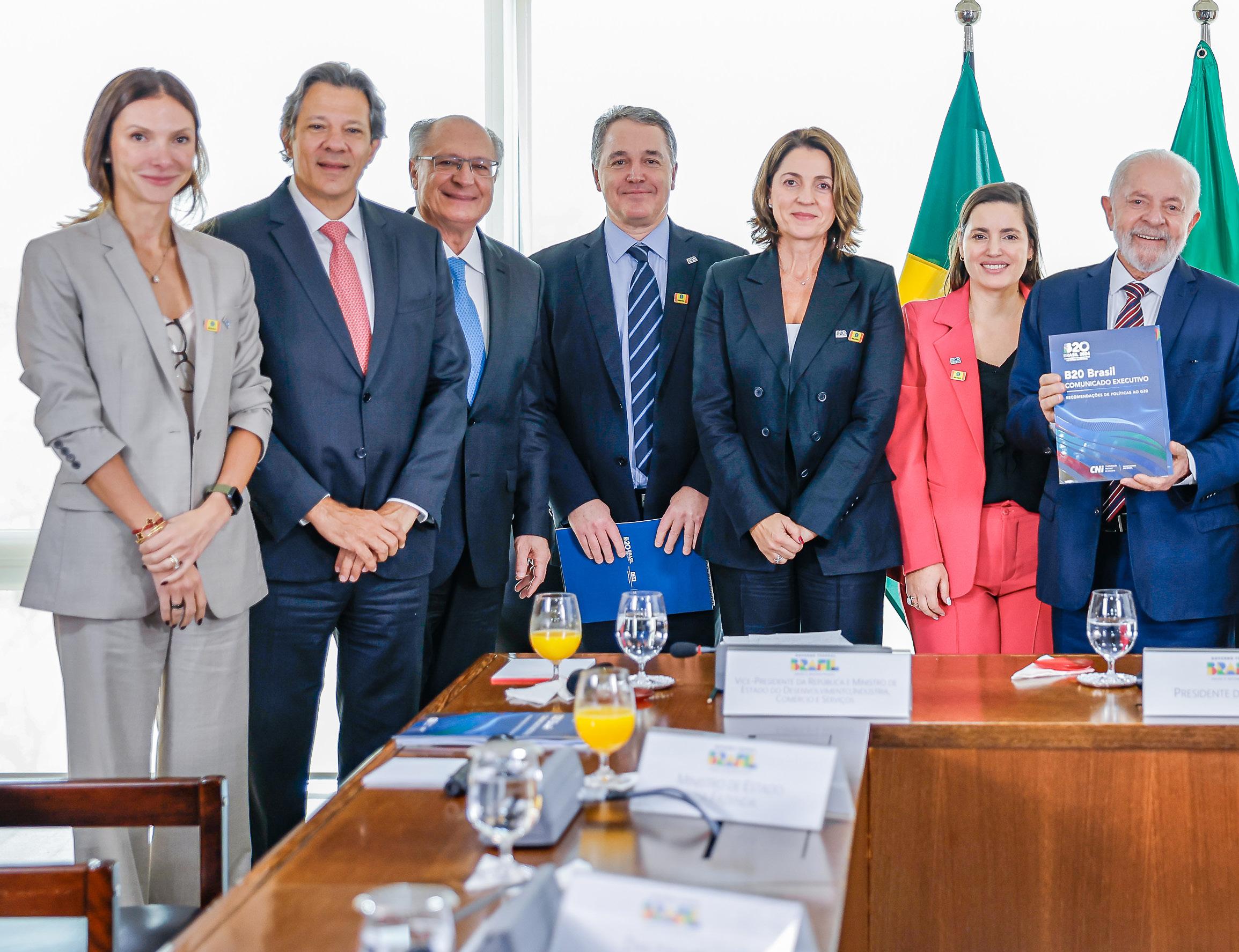
GUIDING CLAIMS AND SYNERGIES
This section presents a deep exploration of the five guiding claims and their implications for global business and policy. It also explains the specific synergy areas that were identified as points of convergence for the diverse perspectives and proposals from all Task Forces and the Action Council.
Guiding Claim 1: Promoting Inclusive Growth and Combating Hunger, Poverty, and Inequalities
• The Global Context: While global GDP has increased steadily in recent decades, there has also been a drastic rise in global inequalities, and hundreds of millions of people continue to be trapped in extreme poverty and hunger. The COVID-19 pandemic has exacerbated these issues. Data from the World Inequality Report reveal that the top 10% of the world’s population hold 76% of all global wealth, while the poorest half own just 2%. Women’s economic empowerment is also still not prioritized, with women’s share of total labor income standing at less than 35%. These inequalities contribute to global instability and hold back human potential.
• B20 Response: B20 Brasil recognizes that promoting true inclusive growth needs comprehensive solutions that are not focused on economic growth alone. B20 Brasil’s recommendations center on:
- Transforming Global Food Systems: B20 believes that a transformation of the current system is needed to ensure access to safe and nutritious food for all. This includes the promotion of sustainable agricultural practices, and supporting the dissemination of technologies and technical assistance. Financial mechanisms should also be prioritized for small and medium sized enterprises in the sector, along with a focus on promoting access to global markets through fair trade principles.
- Example: The B20 is encouraging policies that support agro-ecological methods and the use of precision agriculture techniques.
• Promoting Diversity and Inclusion: The B20 recognizes that underrepresented groups continue to face barriers that limit their potential. To ensure equality, the B20 supports measures to address systematic discrimination, prejudice, and biases that limit access to education, employment, healthcare, and political participation.

Data from the World Inequality Report reveal that the top 10% of the world’s population hold 76% of all global wealth, while the poorest half own just 2%. Women’s economic empowerment is also still not prioritized, with women’s share of total labor income standing at less than 35%. These inequalities contribute to global instability and hold back human potential.
marginalized are provided with pathways to economic prosperity, with a special focus on MSMEs and entrepreneurship. Support systems need to focus on access to financial resources, creating collaborative relationships with the public and private sectors and enabling environments where all can thrive.
- Example: B20 promotes the adoption of inclusive financial instruments and investment vehicles that meet the specific needs of MSMEs.
Synergy Areas within Guiding Claim 1:
• Synergy 1.1: Inclusive Food System Transformation: Recognizing the importance of food for both economic growth and human well-being, this synergy brings together sector specific solutions to further a holistic approach. This approach calls for enhancing production efficiency and promoting investment in sustainable practices, while also ensuring that value chains are inclusive, efficient and equitable.
- Example: The B20 advocates for integrating digital technologies for traceability of food products.
• Synergy 1.2: Diversity and Inclusion Across Sectors: This synergy underscores the need to tackle barriers to inclusion at all levels. This requires promoting fair representation and equal access to resources and opportunities, particularly for women, minorities and those that are socioeconomically disadvantaged.
- Example: The B20 supports the adoption of policies that measure diversity in the workforce and leadership.
Guiding Claim 2: Accelerating a Fair Net-Zero Transition
• B20 Response: The B20 acknowledges the urgency of transitioning to net-zero, while emphasizing that this process must be fair, equitable, and aligned with the needs of people and planet. To do this, the B20 has focused on recommendations that:
- Promote a Just and Fair Transition: Acknowledging that the move away from fossil fuels has impacts on all segments of society. Governments and businesses must actively ensure that workers, communities and vulnerable groups are at the forefront of new planning and initiatives.
- Scale up Climate Finance:
The B20 calls for a concerted effort to increase the flow of private and public capital to climate action. This includes innovative finance mechanisms, better use of development funds, and the expansion of capital markets for low-carbon investments.
- Ensure Corporate Transparency: As sustainability continues to move from the fringes to the mainstream, a set of standards and metrics are needed to provide transparency and accountability to all stakeholders, from consumers, to investors, to governments.
Synergy Areas within Guiding Claim 2:
- Example: The B20 recommends public policies that support and ensure equal opportunities for underrepresented groups, including legislation that provides accessible and diverse workplaces
* Fostering Economic Empowerment: It is imperative that those who are
• The Global Context: The Intergovernmental Panel on Climate Change (IPCC) reports highlight that the effects of climate change are already being seen across the globe. Failing to take action has a disproportionate effect on those who are most vulnerable and it will be essential to limit warming to 1.5C above preindustrial levels to reduce irreversible environmental damage. Recent data indicates that there is a huge gap between the current commitments from governments and what is needed to reach the goal of limiting warming. This gap is further exacerbated by the massive investments that will be needed.
• Synergy 2.1: Ensuring a Fair NetZero Transition: The B20 sees that this transition requires a strong commitment from all to build a sustainable future. Policy recommendations need to be fair and address socio-economic needs. This calls for collaboration across multiple stakeholders and the adoption of standards to help with a collective response.
- Example: B20 calls for workforce development programs to equip workers with the new skills that are required for green economy jobs.
• Synergy 2.2: Financing the Net-Zero Transition: B20 has identified a key need to de-risk climate investments, while promoting the development of innovative financial instruments to unlock much needed funding and capital.
- Example: The B20 supports the development of carbon markets that can be used to incentivize reduction and to protect nature. →
Guiding Claim 3: Increasing Productivity Through Innovation
• The Global Context: In recent decades the world has seen significant gains in living standards thanks to robust economic growth. Productivity gains have been a key driver to this process, but the last decade has seen a sharp slowing down in productivity growth.
• B20 Response: The B20 recognizes the critical importance of innovation to accelerate sustainable economic growth by:
- Boosting Investment in R&D: Research and development is essential to drive long term productivity increases, and to generate new technological solutions to meet future challenges.
- Leveraging Digitalization: A better adoption of digital tools and technologies across all sectors will allow for enhanced efficiency and productivity. This includes the expansion of digital infrastructure and skills to support their proper implementation.
- Optimizing Resources: The correct allocation of resources through competition, globalization, and dynamic business environments will help to maximize investment and increase productivity.
Synergy Areas within Guiding Claim 3:
• Synergy 3.1: Enhancing SectorSpecific Applications of Digital Technologies and AI: This synergy focuses on the need to accelerate the integration of AI into specific sectors, highlighting its transformative potential, while acknowledging the need for responsible adoption, that is guided by international cooperation, ethics, and the implementation of regulatory frameworks.
- Example: The B20 recommends policies to support AI innovation clusters and ecosystems.
• Synergy 3.2: Enhancing Global Commerce Through Data Free Flow with Trust and International Cooperation: In today’s digital economy, the free flow of data is essential for innovation and growth, but also needs to be balanced with the need for trust and security. This calls for a multi-stakeholder approach to the operationalization of DFFT and building interoperable systems to support cross border trade.
- Example: The B20 calls for a collaboration between governments and businesses to establish inter operable data-sharing frameworks.

Guiding Claim 4: Fostering the Resilience of Global Value Chains
• The Global Context: GVCs have reshaped the world economy and increased global trade and investment. Yet these supply chains have shown their vulnerability during times of crisis, especially during the COVID-19 pandemic. Severe production shocks nd geopolitical tensions are highlighting the need to build greater resilience.
• B20 Response: B20 recognizes the importance of building strong and robust supply chains by:
- Risk Management: It is key to strengthen risk assessment across global value chains, improving transparency, diversifying suppliers and implementing more robust systems.
- Sustainability: GVCs also need to prioritize long term sustainability by promoting circular economy principles and investing in alternative energy sources, while safeguarding the rights of workers.
- Multilateral Cooperation: Public policy must focus on strengthening the WTO and the multilateral trading system, promoting predictability and minimizing protectionism, and facilitating investment in technology, training and capacity building.
Synergy Areas within Guiding Claim 4:
• Synergy 4.1: Financing Micro, Small, and Medium-Sized Enterprises: MSMEs have a critical role in promoting economic growth and job creation, particularly in emerging markets. To improve their competitiveness and allow them to better navigate the new global context, actions must focus on addressing their financial needs, removing administrative hurdles and offering tailored support.
- Example: The B20 supports the streamlining of bureaucratic processes and simplified regulatory frameworks to help MSMEs.
• Synergy 4.2: Enabling Sustainability and Resilience in GVCs Through Trade: This synergy recognizes the power of trade in advancing both sustainability and resilience in global value chains. It supports open markets, promotes the adoption of sustainable practices, and encourages collaboration to drive long-term growth and responsible use of resources.
- Example: The B20 supports the use of internationally accepted methodologies for carbon footprint calculation and reporting.
Guiding Claim 5:
Enhancing Human Capital
• The Global Context: The future of work is undergoing constant changes, driven by technology, automation, and changing environmental conditions. This requires that education and training systems adapt to prepare people for future opportunities. This includes a growing need for lifelong learning and upskilling programs, and it requires the development of frameworks to support individuals and communities in navigating new realities.
• B20 Response: The B20 emphasizes policies that:
- Provide Enhanced Educational Opportunities: This includes investments in educators, new curricula, and ensuring access to digital learning and digital infrastructure. It also includes the need to modernize and create more relevant vocational training for the demands of the future.
- Promote Reskilling and Upskilling: This can be done through flexible pathways that recognize skills and competencies for different forms of education, including micro-credentials, non-traditional learning, and workintegrated programs.
• Ensure Workforce Inclusion: The workforce must reflect the population it serves. Barriers that limit access to employment must be removed, promoting a more diverse and equitable job market.
Synergy Area Within Guiding Claim 5:
• Synergy 5.1: Inclusive, Productive, and Resilient Workforce: This synergy brings together multiple strands that aim to help the global community tackle the challenges and opportunities of the new world of work. It promotes quality education, enhanced access to training, and the implementation of measures that foster diversity and inclusion in the workforce. It also requires the support of the public sector, the private sector, and civil society to provide resources and opportunities for all.
This section offers a detailed summary of the actionable policy recommendations proposed by each of the B20 Task Forces and Action Council. Each summary is expanded here to include a more detailed list of priorities and actions. (Note: Each of the next sections will follow the below structure)
Task Force/Action Council Title: Expanding on Key Policy Recommendations
Core Themes: This will provide an overview of the key areas of focus for this Task Force or Council.
Policy Priorities: This section will outline the main areas of policy action that are deemed as crucial for the particular mandate. Specific Actions for the G20: This section will highlight specific, detailed recommendations that the Task Force and Action Council deem crucial for implementation.
Trade & Investment Task Force: Expanding on Key Policy Recommendations
• Core Themes: Improving global trade and investment governance, promoting sustainable and resilient trade, and enhancing trade efficiency.
• Policy Priorities: The B20 calls for strengthening the multilateral trading system by restoring the WTO Dispute Settlement Body (DSB); enhancing transparency and cooperation in trade by developing a common framework for carbon reporting, reducing protectionist policies and addressing supply chain vulnerabilities; increasing access to trade finance through digital technologies.
• Specific Actions for the G20:
- Restore and reform the WTO DSB to provide a platform for dispute resolution.
- Establish multilateral and plurilateral agreements to liberalize trade and minimize future trade barriers.
- Promote internationally accepted methodologies for carbon footprint reporting for all products and services.
- Review unilateral restrictive trade policies and implement regulatory mechanisms to promote resilience.
- Adopt digital document standards for customs clearance and enhance access to trade finance for LDCs and MSMEs.
Employment & Education Task Force: Expanding on Key Policy Recommendations
• Core Themes: Preparing a resilient workforce for the future of work, fostering diverse and inclusive workplaces, and boosting innovation and sustainable growth.
• Policy Priorities: Developing skills for the future through modernized education and training systems; enhancing representation of underrepresented groups, while promoting the recognition of alternate and future forms of work, while fostering collaboration in areas of research and technology.
• Specific Actions for the G20:
- Increase emphasis on STEM and digital skills, and modernize teacher training to include these elements.
- Create financial incentives to promote programs for reskilling and upskilling with an emphasis on work-integrated learning solutions.
- Prioritize the development of international tax frameworks to support job mobility and safe labor migration. →
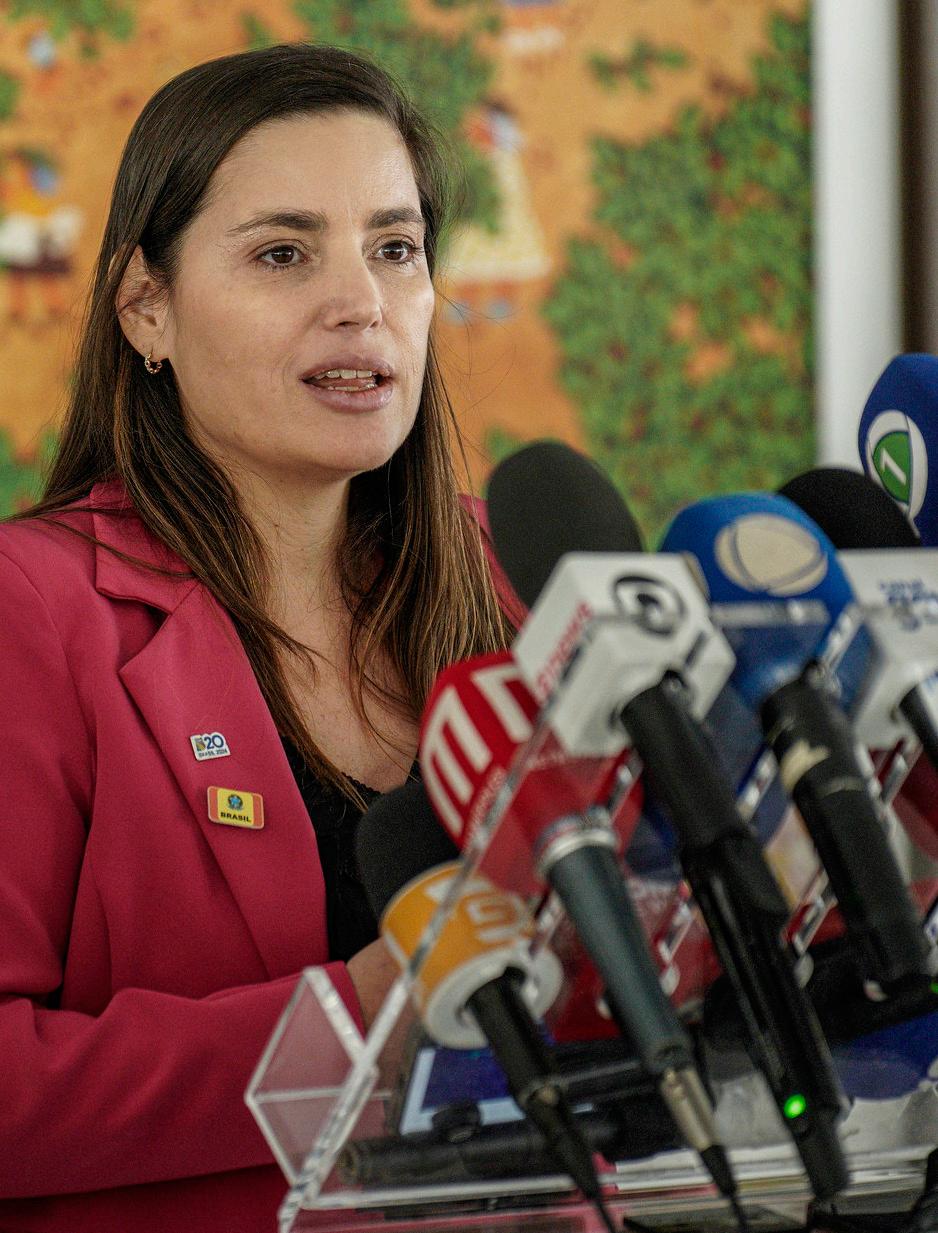
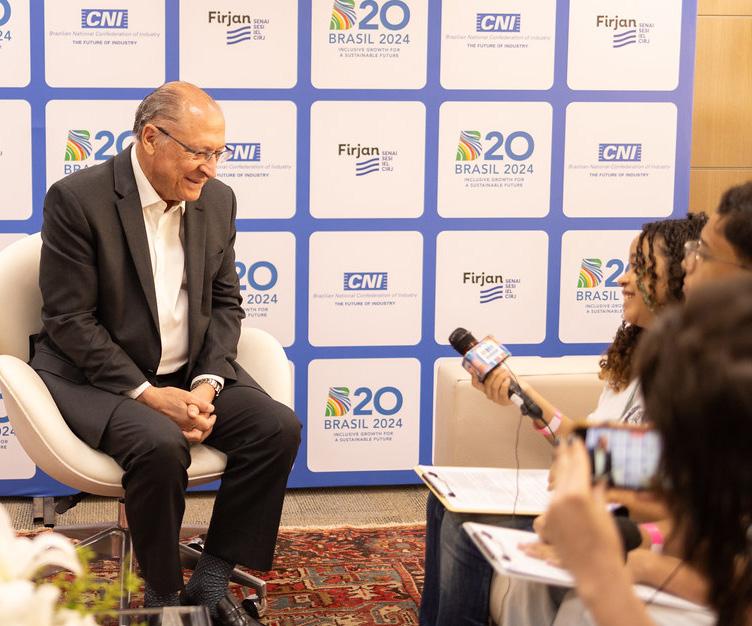
- Incentivize companies to promote equal access to work opportunities, and reward programs to promote D&I.
Energy Transition & Climate Task Force: Expanding on Key Policy Recommendations
• Core Themes: Transitioning to renewable energy, increasing energy efficiency, and implementing natural climate solutions.
• Policy Priorities: Increasing the use of sustainable renewable energy sources while also ensuring a just transition that is inclusive; making use of best practices to double energy efficiency; implementing nature-based carbon capture solutions.
• Specific Actions for the G20:
- Tripling renewable energy capacity by 2030, and expanding grid infrastructure.
- Establish incentives to promote bioenergy and biofuel, while accelerating the transition to net-zero emissions
- Promote the creation of a thriving Natural Climate Solutions global market.
- Double the average annual rate of energy-efficiency improvement while
supporting the uptake of circular economy practices.
Digital Transformation Task Force: Expanding on Key Policy Recommendations
• Core Themes: Achieving digital connectivity, safeguarding data, and leveraging AI ethically.
• Policy Priorities: Increasing global connectivity; ensuring cybersecurity and digital trust; and harnessing the benefits of AI ethically and responsibly.
• Specific Actions for the G20:
• Promote Public-Private Partnerships to encourage investments in digital infrastructure and reduce gaps in usage across different populations
• Adopt digital standards for trade transactions and streamline the interoperability of data for better flow of information.
* Foster international cooperation to improve cyber-security, while establishing frameworks that promote responsible AI development, deployment and governance.
Finance & Infrastructure Task Force: Expanding on Key Policy Recommendations
• Core Themes: Catalyzing private capital, increasing public financing, and ensuring the integration of MSMEs into value chains.
• Policy Priorities: Mobilizing private sector climate financing; developing infrastructure projects that contribute to a net zero and resilient economy; while supporting the needs of MSMEs in the global value chain through regulatory and financial support.
• Specific Actions for the G20:
- Review and promote best practices for public sector financing.
- Develop innovative and risk mitigating tools to facilitate private sector investment.
- Streamline permitting processes for climate-resilient projects and promote the use of technology to support infrastructure roll-out.
- Facilitate global integration of MSMEs by developing cross-border interoperability and reviewing the regulatory frameworks that affect MSMEs access to trade and finance.
Integrity & Compliance Task Force: Expanding on Key Policy Recommendations
• Core Themes: Developing robust measures against corruption, fostering collective action for integrity, and promoting ethical leadership.
• Policy Priorities: Promoting the implementation of anti-corruption measures; fostering collaboration across sectors, and encouraging ethical leadership to build trust and social responsibility.
• Specific Actions for the G20:
- Provide incentives for private sector anti-corruption practices and convergence of sustainability standards.
- Foster collective action by engaging the public, private and civil society sectors, and strengthen cooperation across value chains.
- Promote international frameworks to enhance ethical business practices and the responsible use of new technologies and AI.
Sustainable Food Systems & Agriculture Task Force: Expanding on Key Policy Recommendations
• Core Themes: Supporting food productivity and sustainable technologies, developing funding models for transition, and promoting fair agricultural trade.
• Policy Priorities: Increasing the productivity of agricultural sectors; developing financing systems that can support the transition to sustainable practices, and reinforcing the role of the WTO to ensure a fair trading system.
• Specific Actions for the G20:
- Promote investments in scientific research and development to support sustainable agriculture, and facilitate access to agronomic technical assistance and promote the implementation of innovative technologies.
- Facilitate new financing tools to support climate resilient food systems and practices.
- Strengthen the multilateral agricultural trading system, eliminating marketdistorting barriers and implementing international standards for sustainability in trade.
Women, Diversity, and Inclusion in Business Action Council: Expanding on Key Policy Recommendations
• Core Themes: Increasing the participation of underrepresented groups, enabling inclusive environments in the labor force, and promoting ethical leadership to advance D&I in business.
• Policy Priorities: Addressing structural inequalities that limit the participation of underrepresented groups; fostering access to equitable opportunities, while promoting a more inclusive work culture that incorporates policies to combat bias and promote equality.
• Specific Actions for the G20:
- Create guidelines for data collection for underrepresented groups, and create strategies tailored for every sector.
- Promote financial incentives to implement diversity and inclusion action plans, while supporting care provisions.
- Promote policies that focus on equitable access to education, and support for upskilling and reskilling to create equitable work places.
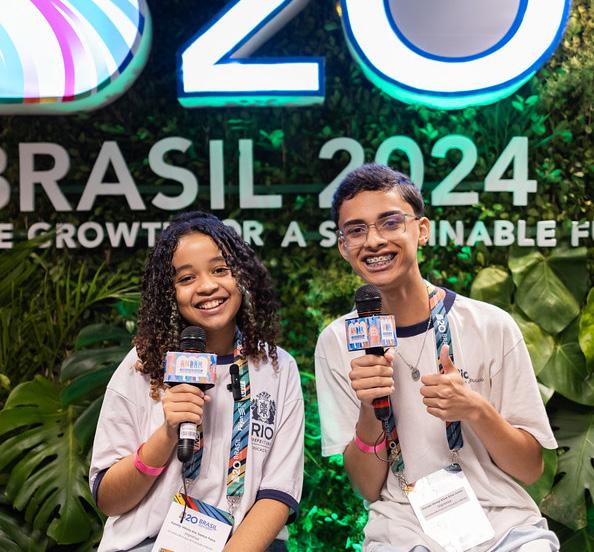
The purpose of this pillar is to leverage the B20 agenda to create a positive impact within Brazil, supporting key priorities and addressing pressing local challenges. It is designed to bridge global policy with local action and bring international recommendations and insights into national level programs.
The B20 Brasil Legacy program has been carefully designed to ensure the sustainability and continuity of the B20 process. This is done through the implementation of three critical pillars that target specific aspects of impact, governance, and continuity:
• B20-to-B20 Transition: This pillar is designed to facilitate a more seamless handover to future B20 presidencies and promotes greater collaboration with incoming hosts, building on the successes
of previous cycles. This will include strategic planning, knowledge transfer, and the provision of detailed documentation and tools to facilitate the implementation of previous agreements and policies.
• B20-Society Initiatives: The aim of this pillar is to create real-world impact by supporting action-driven initiatives led by private sector organizations, civil society, and other institutions. These initiatives aim to address specific challenges around the B20 guiding claims while creating long lasting tangible results, and strengthening the links between B20 and broader society. →
• B20-Brasil Domestic Action: The purpose of this pillar is to leverage the B20 agenda to create a positive impact within Brazil, supporting key priorities and addressing pressing local challenges. It is designed to bridge global policy with local action and bring international recommendations and insights into national level programs.
Key Objectives of B20 Legacy
• B20-to-B20 Transition: To facilitate a smooth handover and ensure continuity across different cycles of the B20. This is designed to be a practical approach to ensure knowledge is shared and that future B20s can leverage from previous work.
• B20-Society Initiatives: To encourage the business community to put recommendations into practice by engaging in action-oriented programs and collaborations. This allows for new and innovative programs to be designed.
• B20-Brasil Domestic Action: To generate impact within Brazil and address domestic concerns, while fostering public-private partnerships, and ensuring national and local alignment.
Examples of B20 Legacy Initiatives
B20 Brazil developed several exemplary projects to highlight its work:
• SheLeads B20: The SheLeads program is designed to increase the representation of women in B20 leadership positions. It aims for concrete results in each B20 cycle, reducing gender disparity.
• B20 Women in Trade Initiative: This initiative partners with the G20’s Trade & Investment Working Group, developing policies that will help women navigate international trade opportunities, and ensuring that they receive a fair share of the benefits.
• B20 Climate Hub: A critical resource hub, created as a public web portal, that showcases effective policies for implementation.
• B20 Carbon Center of Excellence: The B20 recognized that there is a need for knowledge and support in scaling up carbon markets, so they created a new hub to drive practical action.
• B20 Collective Action Hub: To promote collective and collaborative action on ethical behavior, transparency and good governance and address all forms of corruption.

The SheLeads program is designed to increase the representation of women in B20 leadership positions. It aims for concrete results in each B20 cycle, reducing gender disparity.
• B20 AI Platform: To address concerns about the ethical use of Al and to promote frameworks that guarantee responsible Al adoption to promote both innovation and increase productivity.
This section would present detailed statements from key members of the B20 Brasil Advisory Council and the International Business Advocacy Caucus. These perspectives will highlight the importance of the recommendations and the collective endorsement by the global business community.
This annex will include a detailed organizational chart illustrating the relationships between the Steering Committee, Task Forces, Action Council,
and other working groups. A comprehensive list of the members of both the Advisory Council and the International Business Advocacy Caucus with their affiliations will also be provided. Finally, a detailed timeline will also show the key meetings, deliverables and milestones of the B20 Brasil cycle, and including transition activities to next cycle.
The comprehensive KPI Dashboard will offer specific metrics to measure the progress of B20 recommendations and facilitate ongoing monitoring, evaluation, and accountability. These key performance indicators (KPIs) are based on the policy recommendations put forward by each Task Force and the Action Council. The dashboard provides concrete, measurable targets that will help track and monitor progress and highlight gaps in implementation.
Annex 3: B20 Secretariat
This annex will acknowledge and present the team of dedicated professionals that supported and worked through the B20 Brasil cycle to produce this comprehensive communiqué.
4: B20
The full list of all key partners and sponsors that contributed to B20 Brasil’s success will be presented here, highlighting their involvement and the value of collaboration.
The B20 Brasil Final Communiqué serves as more than just a policy document, and is in fact a practical and actionable roadmap for a more inclusive and sustainable global economy. It is a testament to the power of business leadership, collaboration, and innovation in addressing complex global challenges. The B20 Brazil cycle, has been focused on building a world that is not only prosperous, but also more equitable and environmentally responsible, urging all G20 members to prioritize the implementation of the proposed recommendations and to work collaboratively with the business sector to drive meaningful change. This document represents B20’s ongoing commitment to building a better future for all. ■


The key role to be played by country platforms, starting from those supporting firms’ working capital
Gianluca Riccio
CFA, Chair of the Business at OECD Finance Committee, Co-Chair Finance and Infrastructure Taskforce at the B20 BrazilMember of the Action Council on Women, Diversity and Inclusion at the B20 Brazil
The 2024 G20 Leaders’ final Communique of the Summit in Rio de Janeiro clearly highlighted that G20 Leaders commit to “accelerate the reform of the international financial architecture so that it can meet the urgent challenge of sustainable development, climate change and efforts to eradicate poverty”. Moreover, it is especially important that they extend their support to “the voluntary building-up of country platforms as one of the possible instruments to boost sustainable finance in emerging markets and developing economies. Platforms that are country-led, flexible, and well adapted to national circumstances work as efficient instruments to mobilise both public and private capital to finance projects and programs in developing countries, helping match mitigation, adaptation, and resilience building challenges with concrete flows of resources for just transitions“ [G20 Leaders’ Declaration, paragraph 46. November 2024]. These commitments meet the recommendations made by the B20 in the last few years, and more specifically the recommendations made by the B20 Finance and Infrastructure Taskforce [B20 Finance & Infrastructure TF policy paper, recommendation 3]; and the 2024 joint publication B20 – Business at OECD –IOE “Funding Sustainability Efforts: from
aspirations to concrete mechanisms and set milestones” [B20-BIAC-IOE, 2024 - B20BIAC-IOE publication ]. Indeed, the paper recommended to G20 Leaders to seek synergies across different domains to support financing for sustainable growth and stability.
Why are these commitments so important?
Progress towards Sustainability is lagging. In 2023 in Delhi the G20 Leaders highlighted that the “global economic growth is below its long-run average and remains uneven“, and also that “global greenhouse gas (GHG) emissions continue to increase, with climate change, biodiversity loss, pollution, drought, land degradation and desertification threatening lives and livelihoods“. Even countries that have shown healthy economic growth, like India showing regular growth at an average rate of 7%, have however shown material increase in GHG, driven mostly by the heavy use of coal.
Bloomberg NEF in Delhi presented an eye-opening analysis showing that to meet the COP 2050 targets, the investments needed are in the order of USD 180 trillion to over USD 200 trillion depending how stringent of a target is set (figure 1). Ultimately, the pace the world is currently moving at is nowhere near meeting these targets.
The G20 Nations have made collective commitments towards Sustainability investments, also outlining Sustainability future requirements, however they recognise that “at the midway point to 2030, the global progress on SDGs is off-track with only 12% of the targets on track”. In addition, from the corporate sector perspective the issuance of sustainable bonds, despite having increased significantly,1 remain marginal with only 16% of all bonds issued by non-financial corporates (USD 274 billion), and 9% of all bonds issued by the financial institutions (USD 265 billion) being sustainable issuances. In 2022, Sustainability-linked bonds” (SLBs) for which the issuer’s financing costs can vary depending on whether it meets specific sustainability performance targets within a timeline, represented only 13% of total sustainable bonds issued, meaning less than 2% overall (figure 2). →
The challenge is evident, but the G20 commitments made in Brazil may offer a game changer.
To deliver the ambitions targeted in sustainability, policymakers are required to
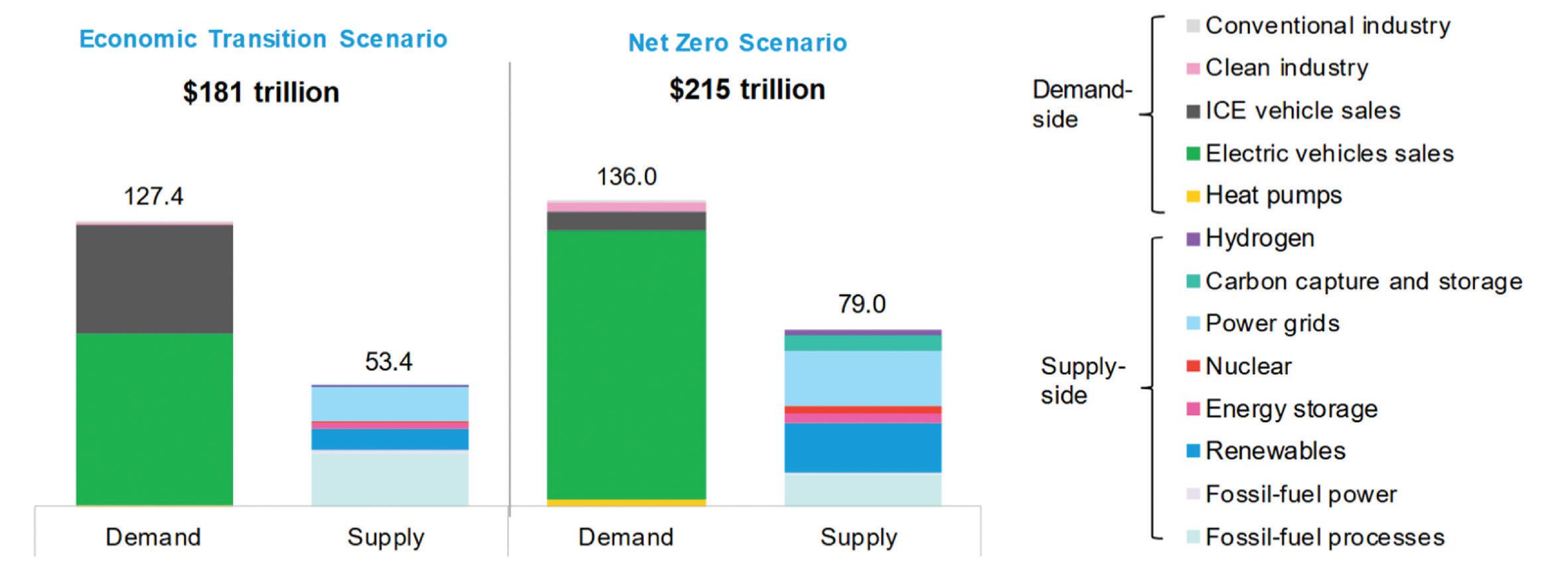
→ offer solutions that generate flywheels across GVC, so to generate positive spillover effects that cascade across the wider economy. The very same challenges and required solutions apply to the investments needed in Africa. To achieve either, funding efforts do not need to be labelled “green”, “sustainable” or “for Africa”, but need to be effective in their content and generate a virtuous circle. The answer emerging from the Brazilian G20 this year is that success can be achieved, but resources alone will not be sufficient if firms face difficulties in accessing funds due to high regulatory and transaction costs, long-dated inherent risks, and a fragmented ecosystem. There is a need of joint private-public investment efforts operating on “Platforms that are flexible, and well adapted” to either the national circumstances or those of the relevant Global Value Chains (GVCs). Such platforms will support Small and Medium-Sized Enterprises (SMEs),
who appear to have been left behind in the agenda, despite being the largest employers globally. Productivity is key, and it is one of the three pillars, together with Stability, and Economic Growth, of the “Sustainable Growth Propeller” (SGP) conceptual framework introduced in the 2022 G20 cycle [B20-BIAC-IOE, 2022] outlined in figure 3 below. The DGP offers a powerful enabler to enact the G20 Sustainability agenda, while also fast-tracking inclusive economic growth and job creation. The G20 India Presidency embraced this objective focusing on the need for actionable policy recommendations on priorities towards responsible, accelerated, innovative, sustainable, and equitable businesses.
A tangible example: payment platforms supporting working capital to free up capitals towards investments. The key challenge is always in executing a strategy, however in this case, concrete
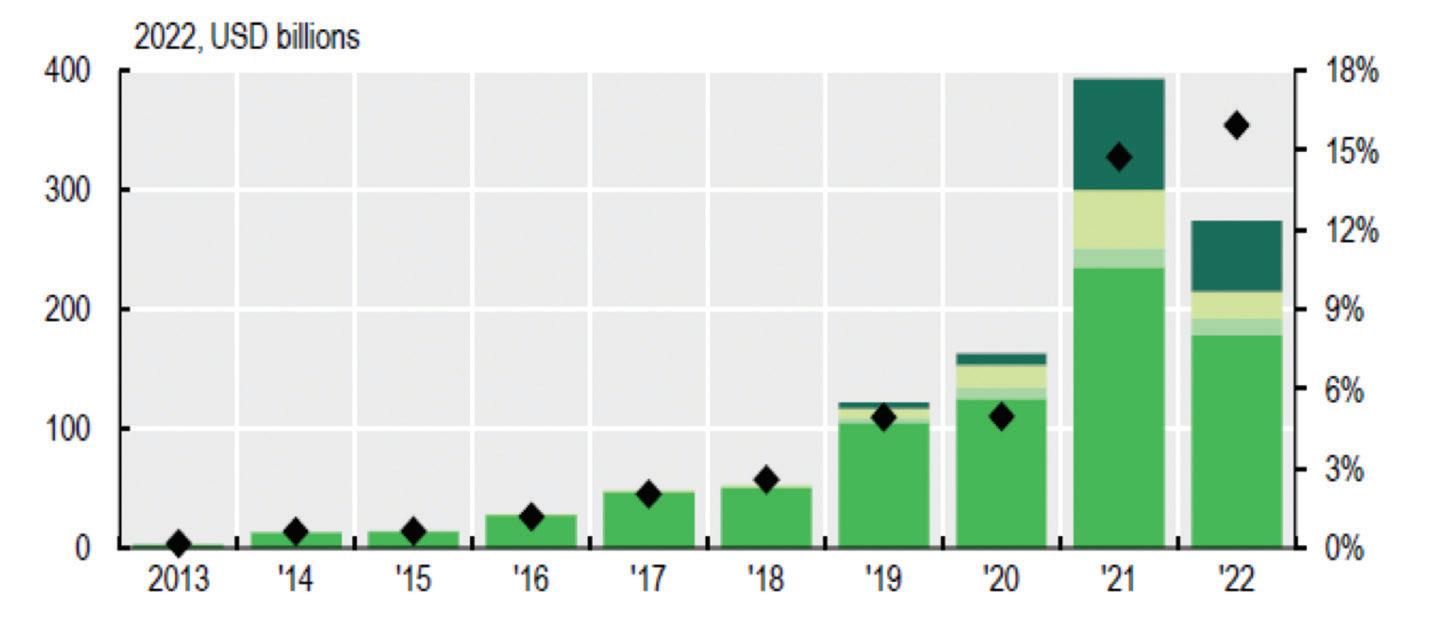

examples do exist, as by addressing firms’ working capital and efficient payments. Indeed, enhancing firms’ ability to effectively manage their working capital will boost productivity, which in turn can positively result in sustainable and inclusive economic growth. The B20, Business at OECD (BIAC) and the International Organisation of Employers (IOE) published a joint paper in Delhi in this direction: “Addressing efficiency in payments and working capital to deliver Sustainability and Growth”, This paper shows the impact that creating trustworthy and interoperable national payment platforms can offer. These are platforms that would be leveraging already existing technology and standards, based on two key components:
• Enabling counterparty identification by making wide use of the Legal Entity Identifier (LEI), while including digital documentation as a key factor in the process.
• Offering trusted and interoperable early-payment platforms that match account payables and account receivables, leveraging technology with clear security and data protection requirements; fully aligning to the G20 communique’ recognition “that safe, secure, trusted, accountable and inclusive digital public infrastructure, can foster resilience, and enable service delivery and innovation”.
The resulting “GVC ecosystems” built on trustworthy interoperable early-payment platforms structured on the basis of safe principles and requirements will benefit all players across both private and public grounds, and also aligns to this year’s GPFI priority towards “Financial Inclusion and Productivity Gains”, as well as paving the road to enhance SME participation in GVCs. Ultimately, if scaled, it could produce a few trillion US dollars of new annual economic benefit globally, in multiple directions:
• Timely payments ensure effective working capital and cash flow management by firms. Working capital can amount to as much as several months’ worth of revenues, which is not trivial. Improving its management can be an effective way to free-up needed cash.
• Aligning account receivables and account payables will foster efficient GVCs.
• It strengthens financial stability as firms raise their credit standing and can borrow at lower costs. The European Central Bank (ECB) concluded that effective and timely payments allow firms to enhance their liquidity and creditworthiness, which also benefits banks having raised the credit standing of their clients, and shifting their lending towards proper Capex investments, with longer maturities. Therefore, early payment platforms accelerating invoice payments are complementary to banks, not competitors.
• 'Shifting from short-term to longer-term credit offers higher net profit ratios towards more solid customers. Taking a step further, ensuring that working capital is funded when needed through early payments, would contribute to safeguard that the significant investments towards fund longer-term Capex as intended, whether aimed towards Sustainability, Africa or other longer term objectives.
• Employment: Facilitating early payments can generate several millions of additional permanent jobs at minimal cost for all parties, including governments. Studies have shown that a fall in the need to finance working capital has material effects on job creation and is progressively stronger for small, labour-intensive firms. Since 70% of funding needed by SMEs is used to meet working capital needs, it is not surprising that research indicates that nearly 20% of every new dollar of working capital for SMEs leads to improved salaries and job creation. Considering that the SME funding gap of over USD 5 trillion (over USD 8 trillion adding informal MSMEs) or the outstanding accounts receivables of USD 30 trillion, the ability of facilitating early payments can generate several millions of additional jobs.
• Economic Growth: taking a step further, a study started in 2022 by the McKinsey Global Institute together with C2FO started a study in 2022 on the improvements of working capital on GDP. Results so far have been compelling and consistent the “rule of thumb” of Okun’s Law2: in each national economy McKinsey analysed, an effective national platform for working capital built along the lines of described in this paper would increase both GDP and employment. In a large country like Mexico, a working capital
platform with national scale can contribute to unlocking up to 1.1% of GDP and up to 1.3% employment growth. In a small country like United Arab Emirates, these can go up to 3% and 5%, respectively.
• Platforms based on reliable certification increase transparency and traceability, contributing to financial crime prevention, such as money laundering or terrorist financing, and efficient sharing of ESG data.
Importantly, such working capital platforms are not a theoretical or utopistic exercise, but they do exist today. C2FO (www.C2FO.com), is a good example of global platforms where technology supports collaboration across GVCs and increases the available supply of working capital. For example, their platform has over 2 million suppliers in its network and has provided more than USD 350 billion (as December 2024) in funding to users around the
world, by ensuring that companies’ invoices are paid at the “right time”, i.e. when the creditor needs the working capital, not just when the invoice is legally due (the platform averaged over 30 days earlier in payments).This offers a tangible example of how the “Sustainable Growth Propeller” (fig. 3) can work in practice, delivering a balanced approach in raising efficiencies and facilitating the transition towards a sustainable and internationally inclusive global economy; by creating jobs and supporting economic growth.
Environmentally led investments are the ideal opportunity to test innovative ideas to facilitate payments and working capital, making them more efficient throughout GVCs, across both borders and sectors, which in turn can act as an enduring flywheel that sparks employment and knowhow, aiding social sustainability. We just need to Get Moving! ■

The G20 Social Summit, held from November 14 to 16 in Rio de Janeiro, marks the culmination of the broad participation process of the G20 Social, convened by the Brazilian Presidency of the G20. It addresses this DECLARATION to world leaders, who will meet at the G20 Summit on November 18 and 19. This document outlines the main proposals of global civil society, agreed upon during the work carried out throughout the year, around the three central themes of the Brazilian Presidency of the G20:
• Fighting Hunger, Poverty and Inequality
• Sustainability, Climate Change and Just Transition;
• Global Governance Reform
Who we are and where we speak from We represent social movements and civil society organizations from Brazil and around the world, brought together at the end of an intense participatory processes that sought to give a voice to the most diverse segments of global society, often impacted but rarely heard in major geopolitical and macroeconomic decisions made by a select group of leaders.
During these months of work, we sought to incorporate the demands, claims, and proposals historically built by organizations and movements of women, Black men and women, indigenous and native peoples, traditional communities, people with disabilities, LGBTQIA+, youth, children, adolescents, elderly people, displaced or homeless populations, migrants, refugees and stateless people, rural and urban workers, and workers in the formal, informal, solidarity and care economies. All calling for a reform of global governance that ensures the end of armed conflicts, development, and social and environmental justice for themselves and for the entire planet.
Fighting poverty hunger and inequality
As a matter of urgency and top priority, it is imperative that all G20 countries and other States join the Global Alliance
against Hunger and Poverty initiative. In line with the Sustainable Development Goals of the UN 2030 Agenda, this alliance must promote cooperation and intercooperation among countries and international organizations, establishing a specific fund to finance public policies and programs to combat hunger in order to guarantee universal access to adequate food.
We advocate for food sovereignty based on the production of healthy foods as a pillar to eradicate the scourge of hunger in every nation and on a global scale.
Peoples’ right to democratic access to land and water and the right to control their own food production and distribution, with an emphasis on agroecological practices and environmental preservation, must be recognized. Promoting healthy eating habits must be central in otder to ensure ocioenvironmental justice, guaranteeing that all social groups —regardless of race, class, gender or origin— have equal access to environmental benefits, respecting traditional food cultures and avoiding the commodification of natural resources.
We reaffirm the centrality of decent work, in line with ILO standards, as a fundamental element for overcoming poverty and inequality. Combating slave labor, child labor, human trafficking, and all other forms of exploitation and precarious work is imperative. We stress the importance of formalizing the labor market and fostering inclusive, counter-hegemonic economies, such as the popular and solidarity economy, cooperatives, solidarity kitchens, and the recognition and valorization of the care economy. Ensuring access to decent jobs, social security, and protection systems for all—especially young people, Black individuals, women, and the most vulnerable—is essential, as is the expansion of union rights.
The dilemmas faced by millions of people suffering from hunger, inequality, and poverty are mirrored in the lack of commitment by the most developed countries and their elites to addressing
climate change and global warming. Those most affected by hunger and poverty are also the ones who bear the brunt of climate emergencies and natural disasters, which are becoming increasingly intense and frequent worldwide.
We reiterate the urgency of tackling climate change, with respect for science and the traditional knowledge of our peoples, highlighting the importance of adaptation and mitigation commitments within the scope of the Nationally Determined Contributions (NDC) and the Paris Agreement. It is an ethical requirement that world leaders make a firm commitment to reducing greenhouse gas emissions and deforestation, as well as protecting the oceans, essential conditions for limiting global warming to 1.5°C and avoiding irreversible damage to the planet.
The just transition, as a process of socioeconomic transformation towards a sustainable model, must serve as the guiding principle for replacing the fossil fuelbased production model with a low-carbon economy. This transformation must tackle social exclusion, energy poverty, and environmental racism while ensuring equitable conditions for workers, Black people, and vulnerable communities. We stress that achieving this transition demands significant investments in environmental education, social participation, and civic engagement.
We must also strengthen the protection of our tropical forests through the establishment of the Forever Tropical Forest Fund (FTFF), an international financing mechanism dedicated to their preservation and the socio-productive inclusion of the populations that inhabit and sustain them. Alongside a New Collective Quantified Goal (NCQG) for climate finance, this fund will enhance global coordination to protect the environment, ensuring sustained financial support for biodiversity conservation and effective action against the climate crisis.
To achieve these objectives, we demand the necessary and urgent reform of the current model of global governance, which has
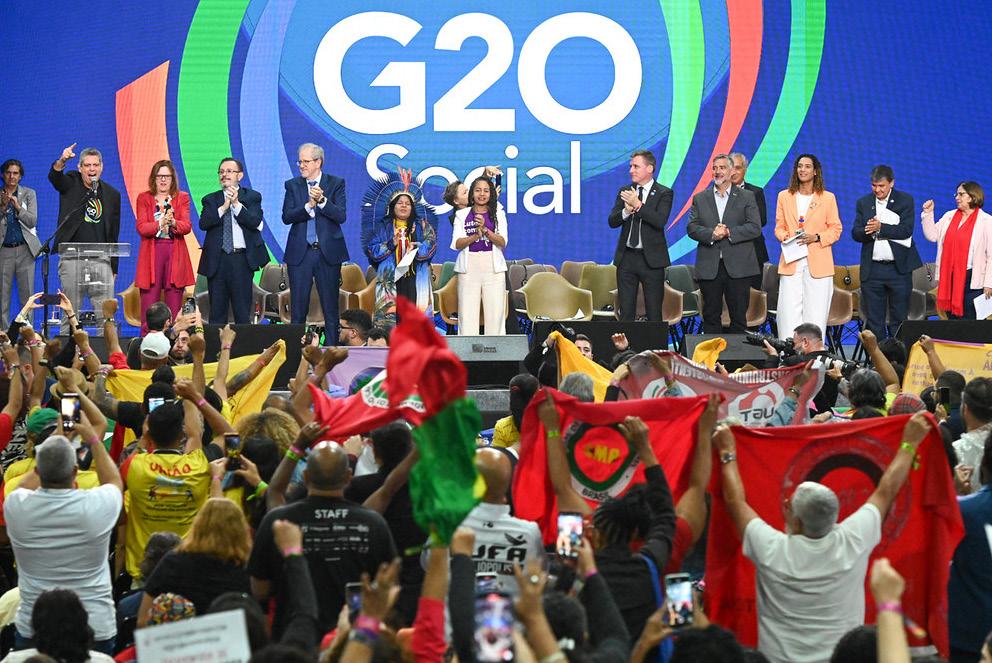
already proven incapable of providing responses to contemporary challenges and maintaining peace.
We emphasize the urgent need to reform international institutions to reflect contemporary geopolitical realities, promoting multilateralism and increasing the participation of governments and peoples from the Global South in decisionmaking forums. In particular, reforming the UN Security Council is essential to ensure the inclusion of diverse global voices and to promote more balanced and effective solutions to today’s challenges.
This reform must prioritize democracy and the active involvement of civil society. Democracy is under threat when far-right forces spread disinformation, authoritarian and totalitarian narratives, and foster human rights violations, lies, hatred, prejudice, xenophobia, ageism, racism, and violence in social and political relations, both within nations and on the international stage. Defending democracy requires upholding the Democratic Rule of Law and ensuring the population’s direct participation in
We emphasize the urgent need to reform international institutions to reflect contemporary geopolitical realities, promoting multilateralism and increasing the participation of governments and peoples from the Global South in decision-making forums.
national and international mechanisms for regulating information. Transparency and plural communication are fundamental to inclusive global governance, granting legitimacy and effectiveness to States and international organizations.
We believe that fiscal justice is a crucial tool for achieving sustainable development.
Therefore, we advocate for the progressive taxation of the super-rich, ensuring that the resources collected are allocated to national and international funds dedicated to financing social, environmental, and cultural policies. These, along with all other funds requested here, must be governed by principles of transparency, accountability, and civil society participation.
Leaders of the G20, it is time for us to take on the responsibility of driving a truly profound and lasting transformation. Ambitious commitments are crucial to strengthening international institutions, eradicating hunger and inequality, mitigating the impacts of climate change, and protecting our ecosystems. Now is the time to act with determination and solidarity. With political will and the institutionalization of bodies like the G20 Social Summit, we can build a collective agenda that upholds our commitment to social justice and global peace. ■
Thalyta Ferraz1, João Carlos Cochlar2
The Urban 20 is the engagement group which consists of a high-level forum for mayoral advocacy within the G20 structure. Since 2017, convened by C40 Cities and UCLG (United Cities and Local Governments), the U20 gathers local authorities from the member states and their invitees to bridge urban perspectives to the G20 agenda. Its goals are based on the premise that cities play a crucial political role in geopolitics since they comprise the closest level of government to the communities they serve3. As stated by Straface and Cammisa, cities “are major actors with popular legitimacy that can influence the quality of life of their residents by playing on the global stage.”4
Cities’ relevance shall intensify.
Today, 56% of the world population live in cities. It will rise to 70% by 2050.5 Understanding the reason for this raise requires acknowledging that urban space is more than territorial configuration. As Brazilian geographer Milton Santos perceives, urban territories bring together activities with the most diverse socioeconomic natures, according to the varied technical, capital and organizational levels of all sorts. This is, in fact, their wealth.6
But these dynamics are a feedback process, which stimulates, often irrationally, urban spaces to grow vertically and horizontally. And the parameters for such growth have been historically setting aside the wellbeing of innumerous communities
and the planet’s climate equilibrium. Over 70% of carbon emissions come from cities. They concentrate 60% of the GDP and also 60% of global resources.7 Those percentages are an expressive portion of the unsustainable level of global warming, inequality and scarcity of resources. It is a platitude to say that a completely uncontrolled human intervention in space became a threat to its own existence. And this crisis revealed a tension between a status quo and the need to adapt our space dynamics.8 The space in which we live is where we daily experience rising temperatures, floods, fires and storms. In our surroundings we see rising inequality, from shifts in the labor markets to hunger, housing issues, exodus and several forms of privation,

worsened by the climate crisis, became part of our worldview. In the midst of this need for action, local administrations are its frontline to tackle those issues through multi and diverse partnerships and access to funds.
Thus, the U20 became a valuable forum for political propelling on urban issues in the international arena, in a context in which the G20 emerged as the multilateral forum capable of enhancing the changes in financial and major global governance issues. Proceeding to its seventh summit held in Rio de Janeiro, U20 became the cities’ voice to the world, igniting the local perspective on the complex path towards COP30 in Brazil. Beyond an international cities’ forum itself, the 2024 co-chairs cities, Rio de Janeiro and São Paulo, had the responsibility to deliver not only an ambitious Communiqué capable of influencing impactful actions towards citizens, but also a summit which could stage the fulfilment of the highest levels of discussion, project sustainable development and propitious interaction between governmental authorities, academia and private sector.
The next part of this essay aims to
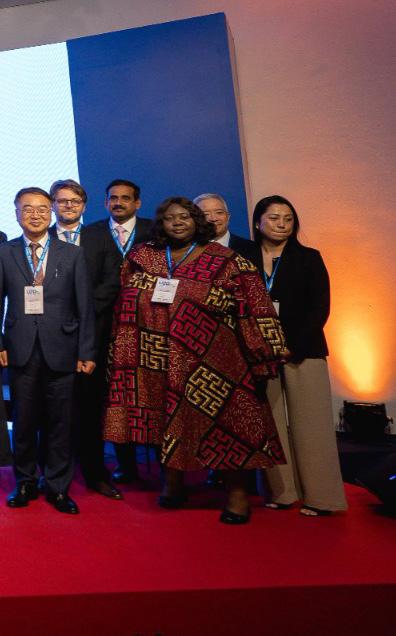
tell a bit about the process of seeking this ambition at the U20 Summit in Rio de Janeiro.
The conceptualization process of the U20 2024 cycle, particularly the U20 Rio Summit, was envisioned to mirror the Brazilian G20 presidential guidelines. They are three: (i) combating hunger, poverty and inequalities; (ii) tackling climate change and fostering energy transition through effective sustainable actions; and (iii) addressing the reform of multilateralism. For Rio de Janeiro’s International Relations Department, it was a crucial step to build such an advocacy event anchored in the priorities of the Brazilian Presidency, emphasizing urban sustainable finance, addressing its barriers, challenges and gaps while advocating for a people-centered agenda, combining a complementary approach to the North and South respective issues and claims about adaptation and mitigation climate finance. In this matter, currently, developed countries have secured 44% of climate action financing, whereas emerging markets and developing economies (EMDEs) receive only 14%, and leastdeveloped countries (LDCs) just 2% of global climate funds. Consequently, EMDEs and LDCs are lagging in the shift toward low-carbon, resilient economies while facing escalating climate change impacts.9
The G20’s 2024 edition was surrounded by severe geopolitical challenges. Despite strategies focused on the financial architecture and preventing global economic and health crisis (also a COVID-19 pandemic reflex), it is well acknowledged that international fora such as the G20 and G7 have faced unity issues since the breakout of military campaigns, the conflicts in Ukraine, Palestine, among others. The Brazilian G20 presidency proposal was meant overcome this recent challenges, encompassing urgent global matters, such as hunger, launching two main task forces - the Global Alliance Against Hunger and Global Mobilization Against Climate Change - while addressing the loss of credibility and efficiency of the global governance system itself, under the ongoing multicrises and the tension of two impactful geopolitical conflicts.
Under this background, the U20 2024 cycle was structured under three main gatherings: a virtual Sherpa Meeting, held virtually in March, when the cycle’s agenda and main priorities, Chairs and Conveners approach to them were presented, followed by a hearing session of city members’ contributions; a mid-term Summit hosted by the City of São Paulo in June; and the final U20 Summit and Official Communiqué handover, held on the eve of the G20 Leaders Summit in November, in Rio.
The space in which we live is where we daily experience rising temperatures, floods, fires and storms. In our surroundings we see rising inequality, from shifts in the labor markets to hunger, housing issues, exodus and several forms of privation, worsened by the climate crisis, became part of our worldview. In the midst of this need for action, local administrations are its frontline to tackle those issues through multi and diverse partnerships and access to funds.
To the final summit, Rio de Janeiro promoted, for the first time in U20’s history, a four-day Summit on the eve of the G20 leaders meeting. The first three days the panels gathered and mixed debates and keynotes of Mayors, government and scientific authorities, civil society and private sector representatives. In addition to a center stage, three other stages were dedicated to discussions surrounding topics of climate mitigation/adaptation, social inequality and governance reform. This four-day event blended public sessions with a Mayoral Closed Door Meeting on the last day, fostering meaningful dialogue on innovative solutions for inclusive urban development.
The Communiqué’s development followed the same structure as the cycle’s goals, prioritizing the fight against hunger and inequality as its primary objective. On climate and energy transition, negotiations centered on terminology and target deadlines. The key points and claims on finance issues can be summarized: →

• Recognition of Local Governments: Urging the G20 to formally acknowledge the distinct role of local governments as integral public actors in addressing global challenges.
• Financial Support for Cities: Emphasizing the need for financial backing to help cities contribute effectively to the G20’s three key priorities.
• Support for CHAMP & Climate Action: Endorsing CHAMP as a key initiative for implementing the Paris Agreement and calling for cities to be included in intergovernmental negotiations on climate governance.
• Improved Access to Capital: Demanding a renewed global financial system that grants cities faster, more inclusive access to funding for essential services, sustainability, and resilience.
• Call for $800 Billion in Urban Climate Investment: Recognizing Brazil’s leadership in reforming multilateral banks and requesting G20 governments to commit at least $800 billion annually by 2030 for urban mitigation and adaptation, unlocking private sector investments.
• Guarantee Funds for Cities: Requesting the creation and support for operationalization of financial guarantee mechanisms to help cities secure direct or indirect loans under better conditions from public and private financial institutions.
As its collaborative development and review process evolved among U20 cities, the points of tension expected to be seen in the national levels reflected among local governments positions as well. For that, it is worth mentioning that mid-term in person meetings in São Paulo not only revealed those sensitive points as well as offered an outstanding opportunity for discussing them. Under an outstanding mediation of the U20 conveners chairs, the core issues were heard, elaborated and a majority consensus on the chapeau text was possible to achieve, an
Exploring the city of Rio’s as a looked for and worth travelling space, the City has initiated its known yet ambitious practice of the IR department of gathering a diverse range of partners— including city networks, global experts, and academic institutions — the U20 Rio Summit was seen as a collaborative platform to reimagine urban governance.
exercise itself represents the strength and value of international spaces for negotiation, building trust and common ground.
Many relevant consensus were delivered and reiterated in the U20 Communiqué on sensitive topics such as digital future, labor market, social inclusion, infrastructure, health, access to healthy eating, housing and water security. Above all, there was a strong effort to align with the G20’s mandate, maintaining a forward-looking tone on accelerating the cities’ financial access and their role in the multilateral organisations. In the end, a remarkable number of cities signed the document, which was delivered directly to Brazil’s and G20 President, Lula da Silva who, together with the President of Chile, Gabriel Boric, attended the Mayoral Plenary and the official handover of the U20 Communiqué.
Rio’s IR Department had also another concern: the economic and symbolic relevance to the U20 Summit to be held in Rio de Janeiro, as a prominent city to Brazil and to the Global South10. Rio de Janeiro has a natural talent for hosting major events, making it a fitting choice for high-level political meetings, as history shows. As Brazil’s most iconic city, its streets tell the nation’s unique background, and it is home to key cultural and historical landmarks. Strategically located, Rio is a hub for oil and gas, investments, media, and telecommunications, with strong port and airport infrastructure connecting it globally. As noted by Rio’s U20 Sherpa and G20 Committee President, the city’s selection highlights its organizational capacity and urban stability, reinforcing its reputation as a secure and efficient event destination.11
Exploring the city of Rio’s as a looked for and worth travelling space, the City has initiated its known yet ambitious practice of the IR department of gathering a diverse range of partners—including city networks, global experts, and academic institutions — the U20 Rio Summit was seen as a collaborative platform to reimagine urban governance. Through this approach, it aimed to balance economic, environmental, and social imperatives, providing a comprehensive roadmap for cities to advance sustainability, equity, and resilience.
The story we are able to tell about the U20 Rio Summit is of a successful engagement with civil society, benefiting from the innovative Social G20, a platform launched by the Brazilian presidency aiming
to strengthen the 13 engagement groups. The U20 Rio Summit featured a record participation of 55 partner institutions, 76 public and closed sessions, and 91 hours of activities. The summit attracted an audience of nearly 5,000 people, with representatives from over 80 cities. This summit also held tens of bilateral meetings with high-level local authorities with private agents and scholars. There has never been a previous edition of the U20 with such large engagement.
The U20 Rio Summit on the eve of the G20 Leaders Summit represented a once in a lifetime opportunity for leaders from all government levels to be in the same city, debate and showcase their urge for impactful partnerships. An opportunity also for local leaders to urge for access funding for cities to tackle their emergent issues and deliver faster, fairer climate action. It sets a reference for the future, and our expectation is of progressive achievements in the international gatherings to come.
The timeline for achieving development goals remains critically delayed, demanding urgent and coordinated action. The presence of President Lula and his eight government ministers at the U20 Rio Summit reflected a growing awareness of the G20 presidency on the vital role of cities in shaping global agendas. At the same time cities are more sensitive to the immediate demands of their citizens, they lack resources as compared to regional or national governments. The demand to reduce and change the negative externalities of the way we have been interacting with the space we live in throughout the last decades requires massive investment.
In acknowledgement of efforts by the Brazilian presidency in advancing the reform of multilateral development banks, Mayor Paes called on the G20 governments to commit an investment to unlocking funding and improving local governments’ access to essential resources. Finally, stated an appeal on behalf of the Global South:
“an agenda for reducing inequalities must not only ensure equity among citizens but also among cities. Today, the stark disparity in access to capital between the Global South and the Global North must be addressed—especially considering the historical processes that have shaped this imbalance. Bridging this gap is imperative for true global progress. The development of cities in less developed and developing nations is the only path to real and lasting equality among nations.”12
As Brazil prepares to host COP30, it does so in the wake of unresolved challenges from COP29, including insufficient climate financing and weak accountability from developed nations. While developing countries called for a $1.3 trillion annual fund13, only $300 billion was proposed, with no clear responsibility for wealthier nations or guarantees of public funding. The reliance on loans risks worsening debt burdens. COP29 also failed to advance emissions reduction goals, prioritizing carbon markets instead.
Against this backdrop, strengthening initiatives like CHAMP is crucial to increasing climate ambition and Brazil’s leadership at COP30 will be crucial. The country has the opportunity—and the responsibility—to restore confidence in international climate negotiations and cooperation, while advocating for more equitable financial mechanisms that do not disproportionately burden the Global South. Cities, once again, can play a pivotal role in shaping solutions. As key actors in climate action, urban centers must be fully integrated into the global climate agenda, ensuring that local governments have the resources and influence necessary to drive meaningful change.
Finally, the lessons taken by the U20 Summit in Rio could be summarized as the following sentence: strengthening and coordinating local authorities towards a pathway of urban sustainable development is the key to climate justice and prosperity. It is a message of local communities to world
leaders that multilevel cooperation and governance is possible and effective to face the environmental challenges imposed on humankind in the 21st century.
Action must be through the cities to the world. Urbi et orbi, as would say Pope Francis and his predecessors throughout the centuries. It is pertinent to mention the Pope’s encyclical Laudato Si, one of the most visionary papal manifestations in history. It deals with the idea of a social ecology, as former Irish President Mary Robinson tackles the idea of climate justice.
As Pope Francis states:
“Social ecology is necessarily institutional, and gradually extends to the whole of society, from the primary social group, the family, to the wider local, national and international communities. Within each social stratum, and between them, institutions develop to regulate human relationships. Anything which weakens those institutions has negative consequences, such as injustice, violence and loss of freedom.”
A lack of multilevel partnership and obstructing the full potential of local governments to promote urban sustainable development is, at last consequence, an action that strengthens injustice, violence and loss of freedom. The legacy of Rio and São Paulo’s edition of the U20 is to strengthen the forum’s capacities to its full potential, so it may create concrete action towards livable and prosperous cities, irradiating further achievements for future editions to come. ■
1. Internationalist, holds a MA in International Relations from Pontifical Catholic University of Rio de Janeiro. Local Diplomacy Advisor at Rio de Janeiro City Hall, Focal Point for U20 2024 Cycle until December, 2024.
2. International Relations Advisor at Rio de Janeiro City Hall. LL.M. Candidate at the Pontifical Catholic University of Rio de Janeiro.
3. 2024 U20 Communiqué.
4. STRAFACE, Fernando; CAMMISA, Mariana. Urban 20: Six Editions of City Diplomacy at the Highest Level. In: VORMITTAG, Pedro; ALBUQUERQUE, Marianna; BIRCH, Eugénie (org.). Urban Sustainable Development: governance, finance and politics. Rio de Janeiro: CEBRI, 2024, p. 103
5. Idem.
6. SANTOS, Milton. A natureza do espaço, Técnica e Tempo, Razão e Emoção / [The nature of space: Technique and Time, Reason and Emotion], São Paulo: Ed. USP, 2006, p. 209.
7. CRIPPA, Monica et. al. Global anthropogenic emissions in urban areas: patterns, trends, and challenges, Environ. Res. Lett. 16 (2021) 074033.
8. COCHLAR, João Carlos. For a city network jurisdiction. In: VORMITTAG, Pedro et. al.. Op. cit., p. 126-131.
9. Accelerating Sustainable Finance for Emerging Markets and Developing Economies: Independent Review of the Vertical Climate and Environmental Funds. G20 Independent High-Level Expert Group (G20 IHLEG, 2024). The report is vailable on the website of the G20 at www.g20.org/en/ and on the website of the G20 SFWG at www.g20sfwg.org.
10. MARIANO, Antônio; PADILHA, Lucas. Rio Capital do G20: Desafios da cidade-sede [Rio Capital of G20: Challenges of the host city]. In: Cadernos Adenauer, Edição Especial 2: G20 no Brasil, Ano XXV, 2024, p. 143.
11. Idem, p. 146.
12. U20 Rio Summit’s Mayoral Plenary on Feb. 17th, 2024. Ceremony at the Official Handover of the Communiqué. Speech delivered by Mayor Eduardo Paes, of Rio de Janeiro.
13. Accelerating Sustainable Finance for Emerging Markets and Developing Economies. Op. cit., 2024
14. Pope Francis. (2015). Laudato Si’ [On Care for Our Common Home] [Encyclical letter], item 142.
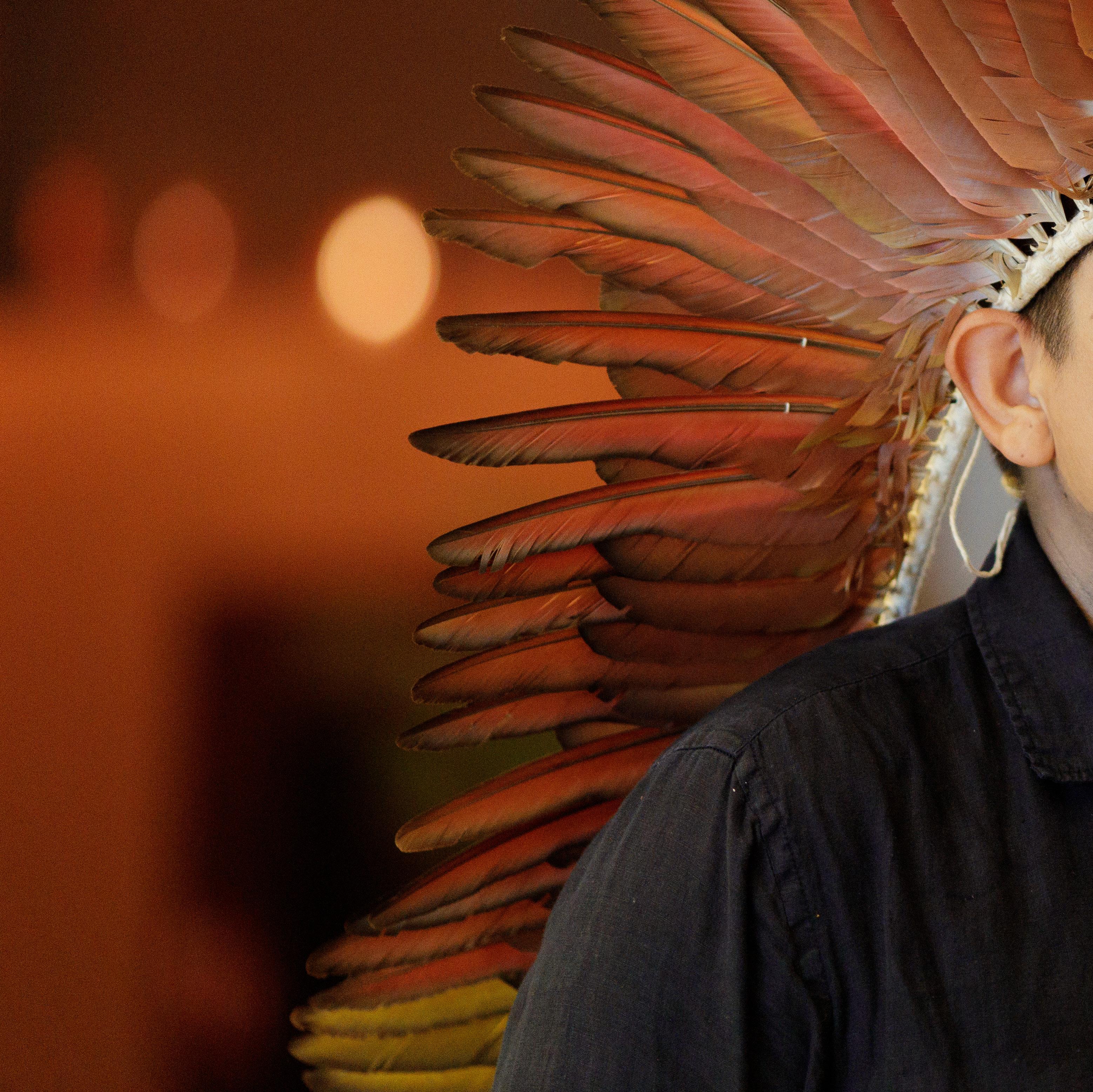
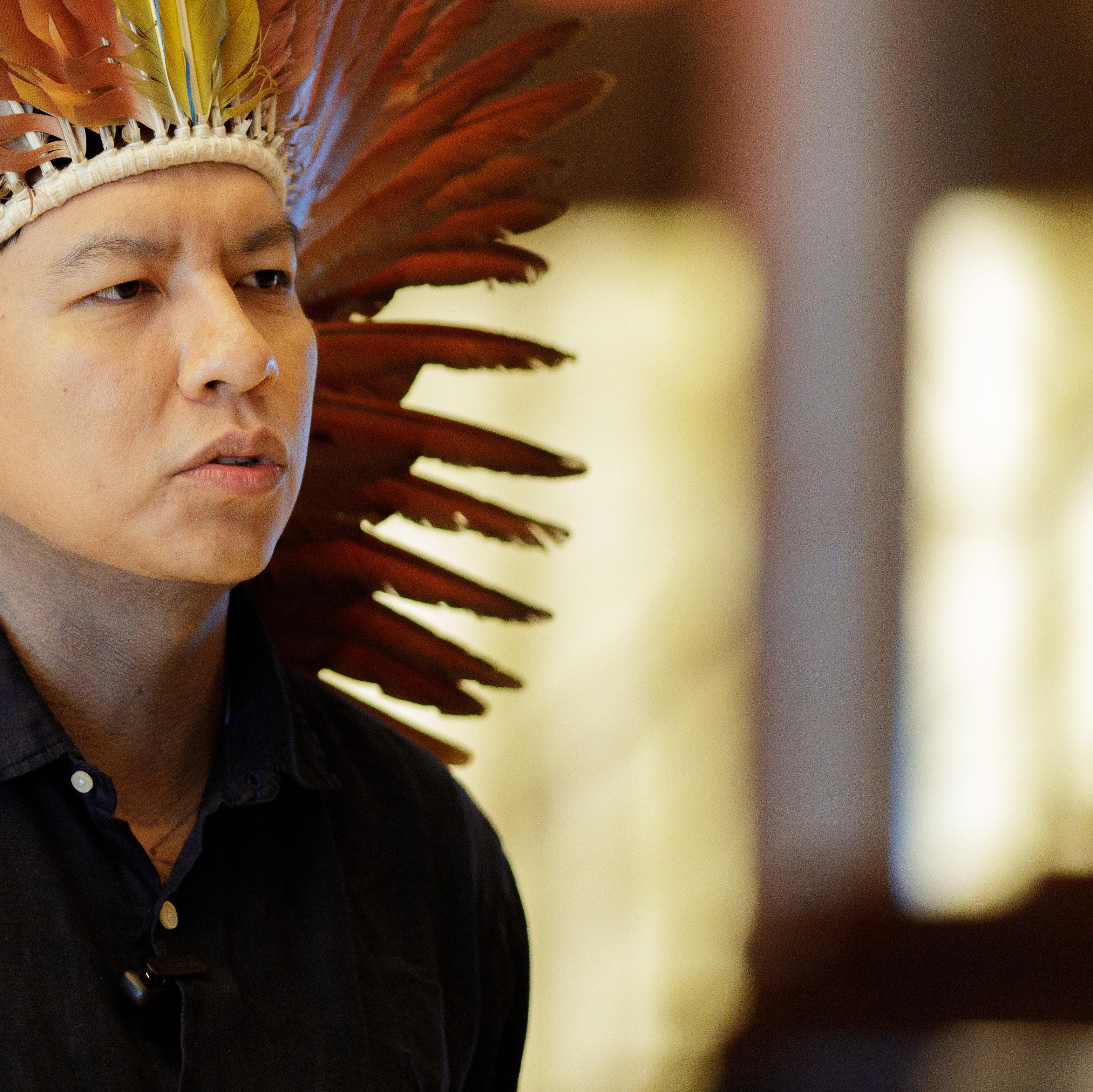
Dear friends,
I greet the Secretary-General of the United Nations, António Guterres, and all my fellow heads of state and government who accepted our invitation to this Summit.
Our meeting takes place at a particularly sad time, due to the death of Pope Francisco.
I am sure that his teachings on the need for an ‘integral ecology’, which sees nature and humanity as a whole, will serve as an inspiration for us.
With less than seven months until COP30, which Brazil will host in Belém do Pará, the planet seems to be entering uncharted territory for science.
Global warming is taking place at a faster rate than predicted.
In 2024, the Earth’s average temperature surpassed for the first time the critical threshold of one and a half degrees above pre-industrial levels.
Many ecosystems, such as forests, glaciers, and seas, are at risk of reaching a point of no return.
The Amazon has recorded the worst drought in its history and the extreme heat has caused massive coral bleaching in the ocean.
Denying the climate crisis will not make it disappear.
We must ensure that multilateralism and international cooperation remain the cornerstone of the global response to climate change.
Despite the attacks on the Paris Agreement, it is thanks to it that we have reversed the most pessimistic projections of temperature rise, which predicted an increase of four degrees by the end of the century.
In Brazil, when we want to mobilize efforts toward a common goal, we use an indigenous word called “mutirão.”
We want to make COP30 a great “mutirão” in favor of the implementation of climate commitments.
Wars, arms races, and interruptions in development aid and climate financing are pushing us backward.
The planet is already tired of unfulfilled
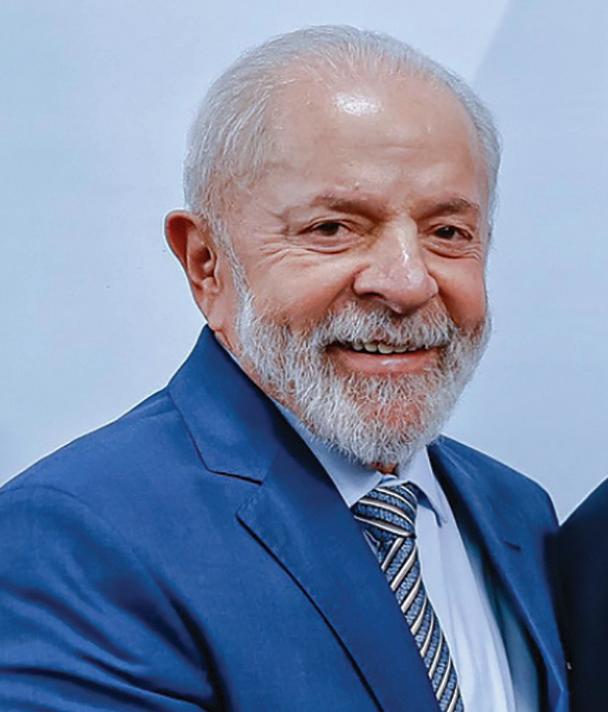
promises. This year, all countries must present their new Nationally Determined Contributions (NDCs), with carbon emissions reduction targets by 2035.
Brazil presented its NDC at the Baku COP. We aim for a reduction of 59 to 67% in emissions, covering all greenhouse gases and all sectors of the economy.
Internally, we are developing a Climate Plan that will include strategies for mitigation, adaptation, and climate justice.
We cannot talk about a just transition without incorporating the perspectives of historically marginalized groups—such as women, Black people, and Indigenous peoples—and without taking into account the specific circumstances of the Global South.
The architecture for preparing the NDCs is flexible enough to combine ambitious goals with the development needs of each state.
Wealthy countries – which have been the biggest beneficiaries of a carbon-based economy – must live up to their responsibilities.
It is in their hands to bring forward climate neutrality targets and increase financing to the goal of one trillion and three hundred billion dollars.
I make a special call for support to four initiatives that should pave our way to Belém in the coming months.
The first of these is an effort we call the Global Ethical Balance. Brazil and the UN will bring together youth and religious leaders, artists, indigenous peoples, scientists, and decision-makers around a new pact with the planet.
The second is the Global Alliance against Hunger and Poverty. Together with FAO, we have developed a guide for the inclusion of social policies and food systems transformation in the NDCs.
In 2024, the Earth’s average temperature surpassed for the first time the critical threshold of one and a half degrees above pre-industrial levels. Many ecosystems, such as forests, glaciers, and seas, are at risk of reaching a point of no return.
The third is the Global Initiative for the Integrity of Climate Change Information, in partnership with United Nations Educational, Scientific and Cultural Organization (UNESCO), which aims to value science and combat disinformation.
Finally, we have the Tropical Forests Forever Fund, to be launched at COP30, which will reward developing countries that preserve their forests.
This summit represents the beginning of a broad movement towards COP 30.
In the year we celebrate the 80th anniversary of the United Nations, I invite everyone to an open, frank, and genuine dialogue about what needs to be done to advance the fight against climate change. Thank you very much. ■
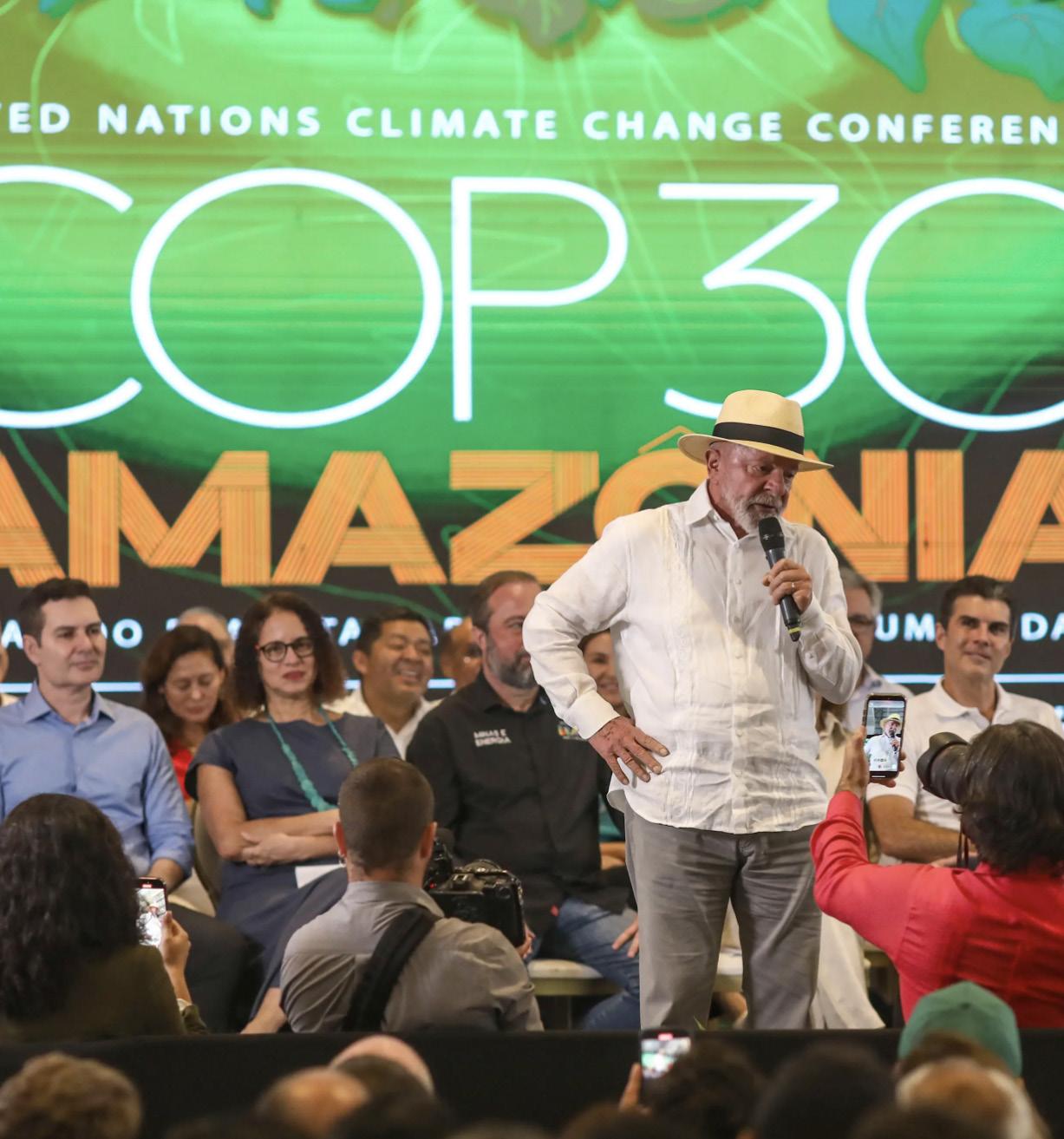
Dear friends,
This is my first formal address as incoming COP30 President. The choice of the General Assembly as my first official trip outside of Brazil is not a coincidence, but a clear sign that the defense of multilateralism will be at the very core of the Brazilian presidency of the COP.
Respect for science will be another pillar of our presidency. In 1988, we, the United Nations, identified climate change as a “common concern for humankind” and created the Intergovernmental Panel on Climate Change, the IPCC. Our leaders listened to scientific alerts and came together four years later in around the ultimate objective of preventing dangerous anthropogenic interference with the climate system. At the 1992 United Nations Conference on Environment and Development, the Rio ‘Earth Summit,’ world leaders signed the United Nations Framework Convention on Climate Change, the UNFCCC, defining principles and the five building-blocks for the multilateral response to climate change: mitigation, adaptation, finance, technology, and capacity-building.
Similarly to the UNFCCC’s role in inaugurating multilateral climate governance, Brazil’s Federal Constitution binds the country to be governed in its international relations by principles that include “cooperation among peoples for the progress of humanity.” This fundamental principle will guide the incoming presidency of COP30, not only because our diplomacy is constitutionally bound by it, but because Brazil has the firm conviction that there is no future progress for humanity without deep, rapid, and sustained cooperation among all countries.
Brazil will host and preside over COP30 in November 2025 against the backdrop of several landmarks: the 80th anniversary of the United Nations, 20 years since the entry into force of the Kyoto Protocol and 10 years of adoption of the Paris Agreement. Much has been learned throughout the three decades of our multilateral regime. Through achievements and shortcomings, the UNFCCC has provided a mirror of humanity’s greatest qualities and limitations. It has shown us how our societies, economies, and politics should work –and how they do in practice.
We now enter 2025 with another

landmark, an unfortunate one: the confirmation that 2024 was the warmest year on record globally, and the first calendar year that the average global temperature exceeded 1.5°C above its pre-industrial level. Now, not only do we hear about climate risks, but we also live the climate urgency. Climate change is no longer contained in science and international law. It has arrived at our doorsteps, reaching our ecosystems, cities, and daily lives.
Facing climate urgency, the complexity of our task ahead is to strengthen climate governance and provide agility, preparedness, and anticipation in both decision-making and implementation.
To achieve this, Brazil hopes COP30 can provide a decisive impulse in three dimensions: (1) to protect and expand the institutional legacy we built together over three decades; (2) to connect to real life the abstraction of negotiations and of COP decisions; (3) to accelerate the implementation of the Paris Agreement through structural solutions and levers beyond the multilateral climate regime, including in global governance and financial architecture.
We need a new era beyond negotiating talks as we continue to reinforce the regime. We must help put into practice what we have agreed. COP30 must represent a decisive transition from the regime’s negotiation phase. The Paris Agreement is working, but we need to move faster. As negotiations emanating from COP21 are now concluded, we must refocus our efforts on action and implementation, while considering approaches and initiatives to “increase the efficiency of the UNFCCC process. We are pursuing this objective nder the Subsidiary Body on Implementation of the UNFCCC, the SBI. Words and text must be translated into actual practice, and transformations on the ground. The credibility and strength of the regime hinge upon it.
We must decisively pull the levers of our regime’s processes, mechanisms, and bodies towards aligning efforts within and outside the UNFCCC with the long-term goals of the Paris Agreement on temperature, resilience, and financial flows. That includes ambitious NDCs that are aligned with Paris long-term goal. National leaders must honor their resolve to pursue efforts to limit the temperature increase to 1.5 °C. Human lives depend on it, future jobs depend on it, healthy environments depend on it.
We need a new era beyond negotiating talks as we continue to reinforce the regime. We must help put into practice what we have agreed. COP30 must represent a decisive transition from the regime’s negotiation phase.
There is a high expectation of taking stock at COP30 of nationally determined contributions, the NDCs. As we all know, NDCs are nationally determined and hence not subject to multilateral negotiations. We will nevertheless stimulate a frank collective reflection on bottlenecks that have been hampering climate ambition and implementation.
Ever since Brazil received the trust of Latin America and the Caribbean as our region’s COP host, the path to COP30 has been successfully paved by the COP28 and COP29 presidencies – our troika partners in the Road Map to Mission 1.5. In 2023, under Emirati leadership in Dubai, we
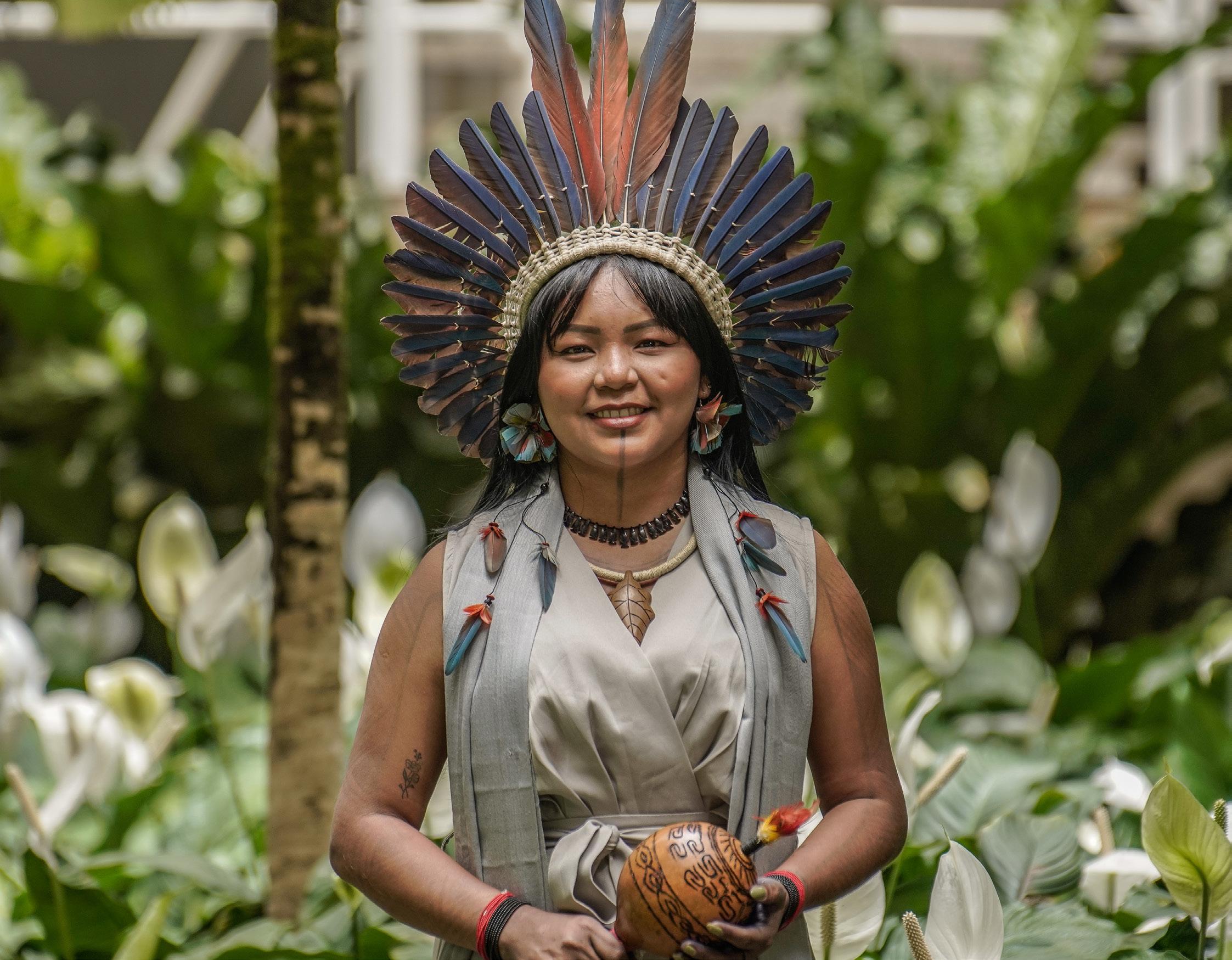
adopted the UAE Consensus, which included a breakthrough on loss and damage, following the Egyptian COP27 leadership. We also concluded the first global stocktake (GST). Unprecedentedly, the GST launched global calls for efforts towards halting and reversing deforestation and forest degradation by 2030. We also accelerate the global energy transition, including by tripling renewable energy capacity globally, by doubling the global average annual rate of energy efficiency improvements, and by transitioning away from fossil fuels in energy systems, in a just, orderly, and equitable manner.
Based on equity and science, the GST is already the unanimous reference that informs international cooperation and Parties in enhancing actions and support. The GST stands as our guide to Mission 1.5, as our collective project to implement the vision of the Convention and the Paris Agreement, the vision of strengthening the
global response to the threat of climate change, in the context of sustainable development and efforts to eradicate poverty.
Having COP28 as a steppingstone and then COP29 under the Azerbaijani leadership, we finally completed in 2024 the Paris “Rulebook” by finalizing the rules under Article 6. We further adopted the “Baku Climate Unity Pact,” which includes the cornerstone decision around the new collective quantified goal on climate finance (NCQG). The incoming COP30 presidency looks forward to working with the COP29 presidency in guiding the “Baku to Belém Roadmap to 1.3T” to scale up climate finance to developing country Parties. Together, we will be producing a report summarizing our work by COP30. The Roadmap must serve as a fulcrum for leveraging finance to low-carbon and climate-resilience pathways in developing countries. If climate goals are to be achieved, both adaptation and mitigation
financing will need to be increased manyfold.
As we step into 2025, we go from COP29 to COP30 not only with a complete Rulebook for the Paris Agreement but also with its policy cycle fully in motion, including in terms of NDCs and the enhanced transparency framework (ETF).
We do have pending issues to solve at COP30, notably the UAE dialogue on implementing the GST outcomes and the just transition work programme (JTWP).
The GST is an invaluable legacy that unites us. We must all continue to subscribe to it as the ultimate benchmark for climate implementation. Just transitions are central for leveraging climate action towards sustainable development and addressing structural inequalities between and within countries, including in terms of gender, race, and ethnicity.
Parties have recognized in Baku we must double-down efforts to support just
transitions across all sectors and thematic areas, and cross-cutting efforts, including transparency, readiness, capacity-building, and technology development and transfer. As countries prepare and communicate their next NDCs and Biennial Transparency Reports (BTRs), we need to build the capacity of developing country Parties to transition from ad hoc reporting approaches to government-led, systematic, and institutionalized processes for preparing and submitting national reports under the ETF.
In 2025, we will continue and strengthen the Sharm el-Sheikh dialogue on the scope of Article 2, paragraph 1(c) of the Paris Agreement. The Paris Committee on Capacity-building (PCCB) will develop a work plan, whilst its focus for the year relies on capacity building for designing holistic investment strategies, bankable projects, and stakeholder engagement to strengthen the implementation of NDCs and National Adaptation Plans (NAPs) in developing countries. The 62nd session of the subsidiary bodies, in Bonn, next June, will also initiate the development of a new gender action plan, taking into account the review of the enhanced Lima work programme. Brazil is honored to build on the legacies of previous Latin American COP presidencies with a view to advancing the agenda on gender and climate.
At COP30 we also have the unique opportunity of amplifying the invaluable legacies from the British COP26 and the Egyptian COP27 leaderships, including under the Sharm el-Sheikh mitigation ambition and implementation work programme (MWP). Instead of suspicion in polarized negotiations, the MWP has the vocation of becoming a platform for breakthroughs and trust-building through action and cooperation when leveraging opportunities, overcoming barriers, and exploring actionable solutions.
As we face and recover from extreme climate events around the world, we must ensure 2025 is equally a landmark for climate adaptation and the delivery of National Adaptation Plans. Adaption is no longer a choice, nor does it compete with mitigation. Building on progress on the global goal on adaptation (GGA) at COP28 and COP29, we must fulfill our legal mandate on indicators under the United Arab Emirates–Belém work programme. Advancing the “Baku Adaptation Road
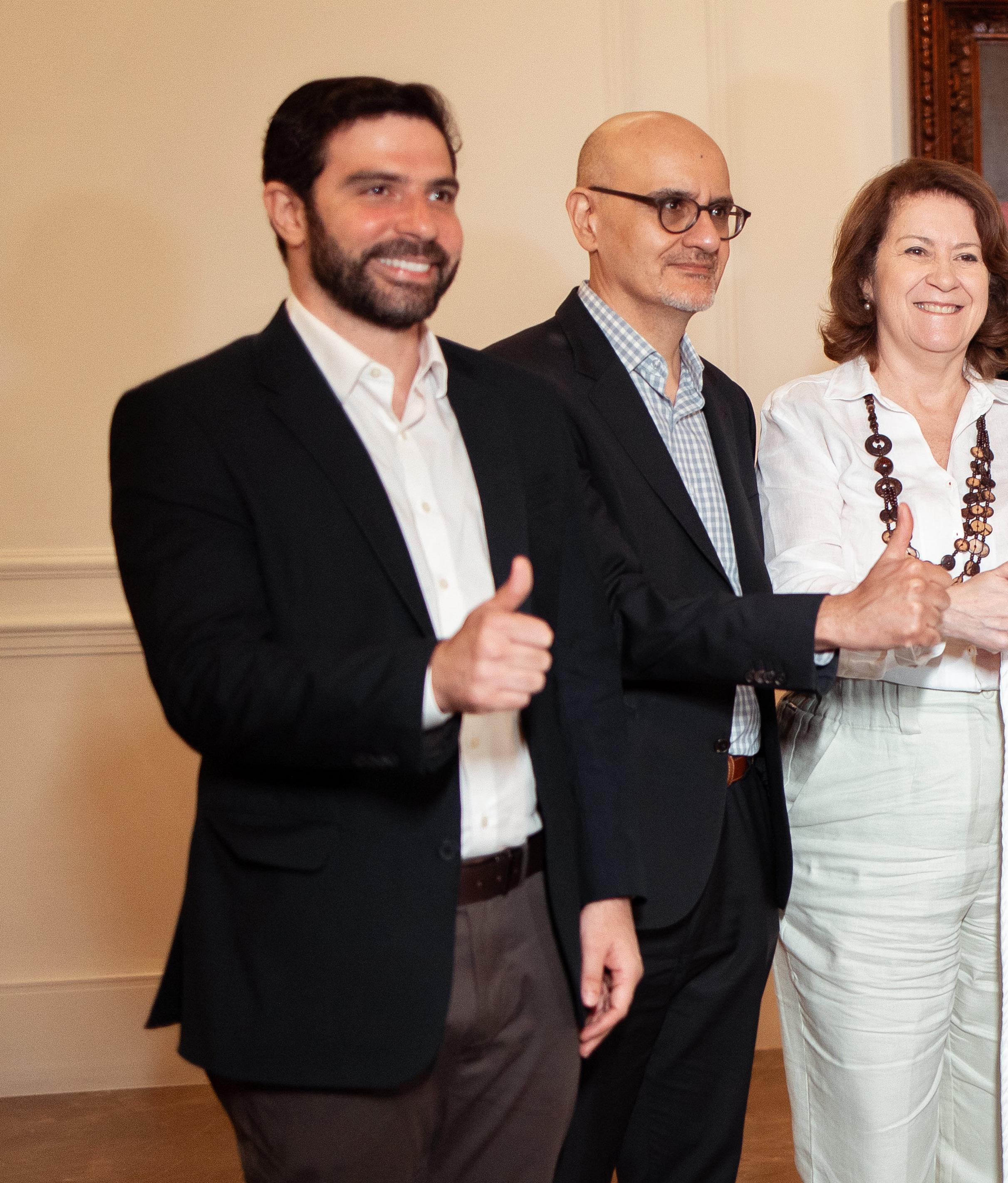
Map” and the Baku high-level dialogue on adaptation will be essential, side by side progress on the work on the Santiago network and the Warsaw International Mechanism.
The more ubiquitous our fight against climate change becomes, the more we need to incorporate synergies between climate, biodiversity, desertification, and our Sustainable Development Goals (SDGs).
The 1992 Earth Summit was the cradle of the Rio Conventions on climate change, biodiversity and desertification, as well as the Rio Declaration and Agenda 21. Back to Brazil, these agendas need to be integrated through strong public participation. It is urgent we address, in a comprehensive and synergetic manner, the interlinked global crises of climate change and biodiversity loss in the broader context of achieving the
SDGs. In doing so, we must continue to acknowledge and expand the role and contributions of Indigenous Peoples and of local communities in nature stewardship and climate leadership, while recognizing the disproportionate effects they suffer from climate change.
The incoming presidency will continue to engage and count with the Mission 1.5 Troika and the UN Secretary-General on raising climate awareness and political momentum around NDCs, including in the context of the partnership between Secretary-General Guterres and President Lula.
Finally, the incoming presidency will seek to bring to the Action Agenda a new dynamic that focuses on key issues for the full implementation of the GST and of NDCs. We will bring together negotiators,

national and subnational governments, civil society, private sector, and other stakeholders to engage in an exercise on how to translate the 10 years of Paris into palpable achievements and incentives to continue to act and strengthen the multilateral regime. Our multilateral institutions can and will deliver results commensurate with the scale of the climate challenge. Climate multilateralism boasts the wisdom and achievements from each of the past twenty-nine COPs. Standing on the shoulders of our predecessors, the incoming presidency of COP30 is humbled by the legacies of COP21 to COP29, legacies that we must preserve, consolidate and build upon.
President Lula’s choice of bringing for the first time to the Amazon the center of global climate decision-making enshrines a
Our multilateral institutions can and will deliver results commensurate with the scale of the climate challenge. Climate multilateralism boasts the wisdom and achievements from each of the past twenty-nine COPs.
vision combining realism and hope. His vision reflects realism because issues that have long been associated as problems in the climate fight can now be turned into powerful solutions. After years of continuous deforestation, the biggest source of Brazil’s emissions, the Amazon, is now fast becoming a major source of climate solutions, from innovation and bioeconomy
to traditional knowledges. The vision of bringing COP30 to the Amazon also reflects hope because the regeneration of the region can spearhead the beginning of a global regeneration towards a future of collective prosperity. Brazil looks forward to welcoming our United Nations to Belem. Let’s build together our common future, let’s embrace our shared destiny. Thank you. ■
The United Nations Framework Convention on Climate Change (UNFCCC) was launched for signature at the United Nations Conference on Environment and Development (Rio-92). It launched the multilateral climate change regime.
The regime includes a commitment by developed countries to lead efforts to reduce emissions and to provide financial, technological, and capacity-building resources for mitigation and adaptation actions in developing countries, following the principle of “common but differentiated responsibilities”.
The regime has five pillars: mitigation, adaptation, finance, technology, and capacity-building. In addition, other issues have gained prominence in the debates, uch as loss and damage, fair transition, gender, indigenous peoples, youth, agriculture, and oceans.
The UNFCCC launched the Conference of the Parties (COP) as the body responsible for decision-making on the implementation of the commitments adopted by countries to tackle climate change. The COP is attended by all countries that have signed and ratified the Convention. Currently, 198 countries participate in the UNFCCC, making it one of the largest multilateral bodies in the United Nations (UN) system.
COP is assisted by a Subsidiary Body for Implementation (SBI) and a Subsidiary Body for Scientific and Technological Advice (SBSTA). The COP also serves as the Conference of the Parties to the Kyoto Protocol (CMP) and the Paris Agreement (CMA).
The COPs are the annual Leaders’ Summits on climate change, usually held in November or December. Besides the COP, the CMP, CMA, SBI, and SBSTA also gather there.
In addition to formal negotiations among Parties, in 2021, the COP launched the “Action Agenda.” This is a voluntary climate action effort that seeks to mobilize different actors, including national and subnational governments, the private sector, and civil society organizations. The goal is to engage in partnerships that seek to implement

effective solutions to tackle climate change.
The Action Agenda itself includes events, declarations, campaigns, voluntary commitments, and sectoral plans (“climate action pathways”) adopted voluntarily by its participants to support the formal negotiations, encourage ambitious decisions, and support their implementation.
In contrast to the formal process, where issues and negotiating tracks are decided multilaterally, the presidency of each Conference of the Parties is responsible for defining its “Action Agenda”.
Adopted in 1997 as part of the UNFCCC, the Kyoto Protocol outlines individual quantitative emission reduction targets for developed countries. The Protocol required these countries to reduce their emissions by 5% in 2008-2012 compared to 1990 levels.
One of the key elements of the Protocol was the implementation of market mechanisms to achieve these commitments. cost-effective. These include the Clean Development Mechanism (CDM), allowing the development of cost-effective projects to reduce greenhouse gas (GHG) emissions, ensuring mitigation benefits, and creating sustainable economic benefits.
The Paris Agreement, adopted in December 2015 at the 21st Conference of the Parties (COP21), highlighted the key role of the Framework Convention (UNFCCC) that it is connected to.
The Agreement stresses the principles of the UNFCCC and introduces three goals:
1. to keep the global temperature increase well below 2 °C, with efforts to limit it to 1.5 °C;
2. to strengthen adaptation and resilience capacities; and
3. to align financial flows with the other goals of the Agreement.
COP is assisted by a Subsidiary Body for Implementation (SBI) and a Subsidiary Body for Scientific and Technological Advice (SBSTA). The COP also serves as the Conference of the Parties to the Kyoto Protocol (CMP) and the Paris Agreement (CMA).
The Paris Agreement also innovated by requiring all countries, both developed and developing, to regularly submit “Nationally Determined Contributions” (NDCs). In the NDCs, each country explains what actions it intends to take to respond to climate change. The implementation of these actions will be accompanied by an enhanced transparency regime.
As NDCs are defined by each country, they respect the national reality and sovereignty of each nation.
The Intergovernmental Panel on Climate Change (IPCC) was created in 1988 by the United Nations Environment Programme
(UNEP) and the World Meteorological Organization (WMO) to provide policymakers with regular scientific assessments of climate change, its impacts and possible future risks, and to suggest options for adaptation and mitigation. IPCC currently has 195 member countries, including Brasil.
The IPCC, in its assessments, sets out the state of knowledge on climate change, identifies issues that are agreed by the scientific community, and areas where more research is needed. The reports resulting from the IPCC’s assessments are key inputs in international negotiations to tackle climate change.
The IPCC’s assessments and special reports are developed by three Working Groups, each looking at a different aspect of climate change science:
• Working Group I (Physical Science Basis)
• Working Group II (Impacts, Adaptation and Vulnerability)
• Working Group III (Mitigation of Climate Change).
The IPCC also has its Task Force on National Greenhouse Gas Inventories, the main objective being the development and refinement of methodologies for the calculation and reporting of national greenhouse gas emissions and removals.
The Working Groups and the Task Force are engaged in the preparation of reports, as well as in the selection and management of the experts who work on them as authors.
All of these activities are assisted by technical support units that guide the production of IPCC assessment reports and other products.
IPCC offers a glossary of technical terms used in its reports and in climate negotiations. Consulting the glossary can help you understand the topics discussed and make it easier to follow the debates.
• IPCC Glossary
The ‘Climate Champions’
The Climate Champion role was created in 2015 –in Paris– at COP21. COP presidencies must appoint a Champion to connect the work of governments with the voluntary and collaborative actions of cities, regions, the private sector, and investors. →
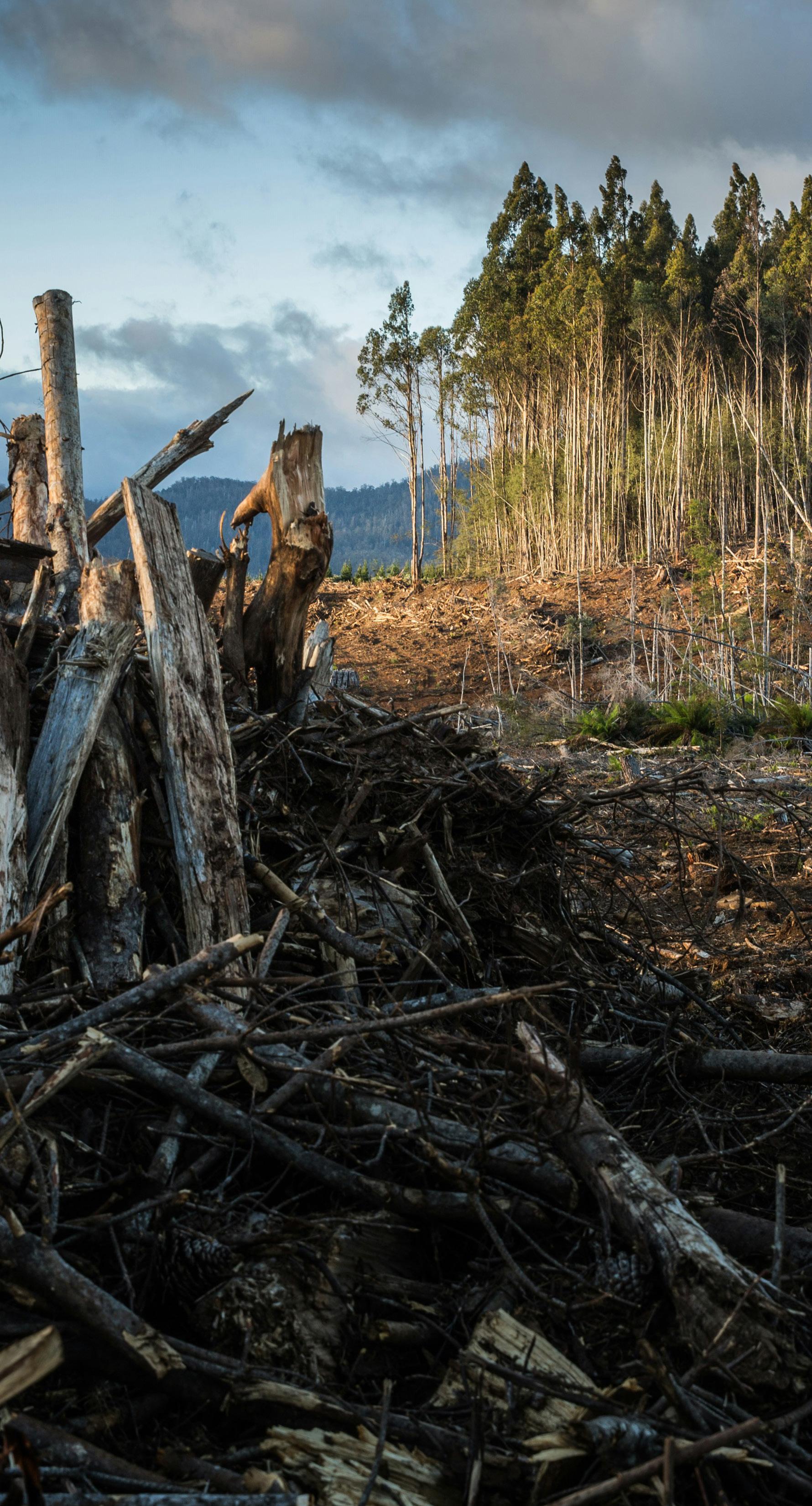

→ The Climate Champion’s mandate is two years. Thus, two Climate Champions are always in effect simultaneously–one appointed by the presidency of the previous COP–and one appointed by the presidency of the current COP. The activities of the Champions focus on two areas:
1. Engagement with Parties and other stakeholders, to connect existing initiatives and coalitions with national action plans - such as NDCs. Efforts are meant to provide additional transparency and credibility to existing climate actions or to support new initiatives in different geographical regions, including by monitoring results.
2. Provide information sources and inputs to support the Executive Secretariat and the COP presidencies (current and next) to prepare technical meetings and high-level events to increase climate action and ambition.
The Climate Champion role was created in 2015 –in Paris–at COP21. COP presidencies must appoint a Champion to connect the work of governments with the voluntary and collaborative actions of cities, regions, the private sector, and investors.
Presidency Youth Climate Champion (PYCC)
In addition to the Champion figure, COP28 established the Presidency Youth Climate Champion (PYCC), a “bridge between the COP Presidency and children and youth”.
The decision included the appointment of a PYCC, between the age of 18-35, to engage the COP presidency to advocate for the “inclusive participation of young people in climate action, including as part of the UNFCCC process”. PYCCs, like Champions, have a two-year mandate.
Activities in both areas are focused on climate action, attracting attention to climate action, and promoting initiatives to the broader public.
The PYCC’s task is to facilitate the participation and voices of children and youth within the UNFCCC process and beyond, in close coordination with the Official Children and Youth Constituency of the UNFCCC (YOUNGO) and hildren and youth from all other non-governmental organizations and constituencies of the UNFCCC. ■
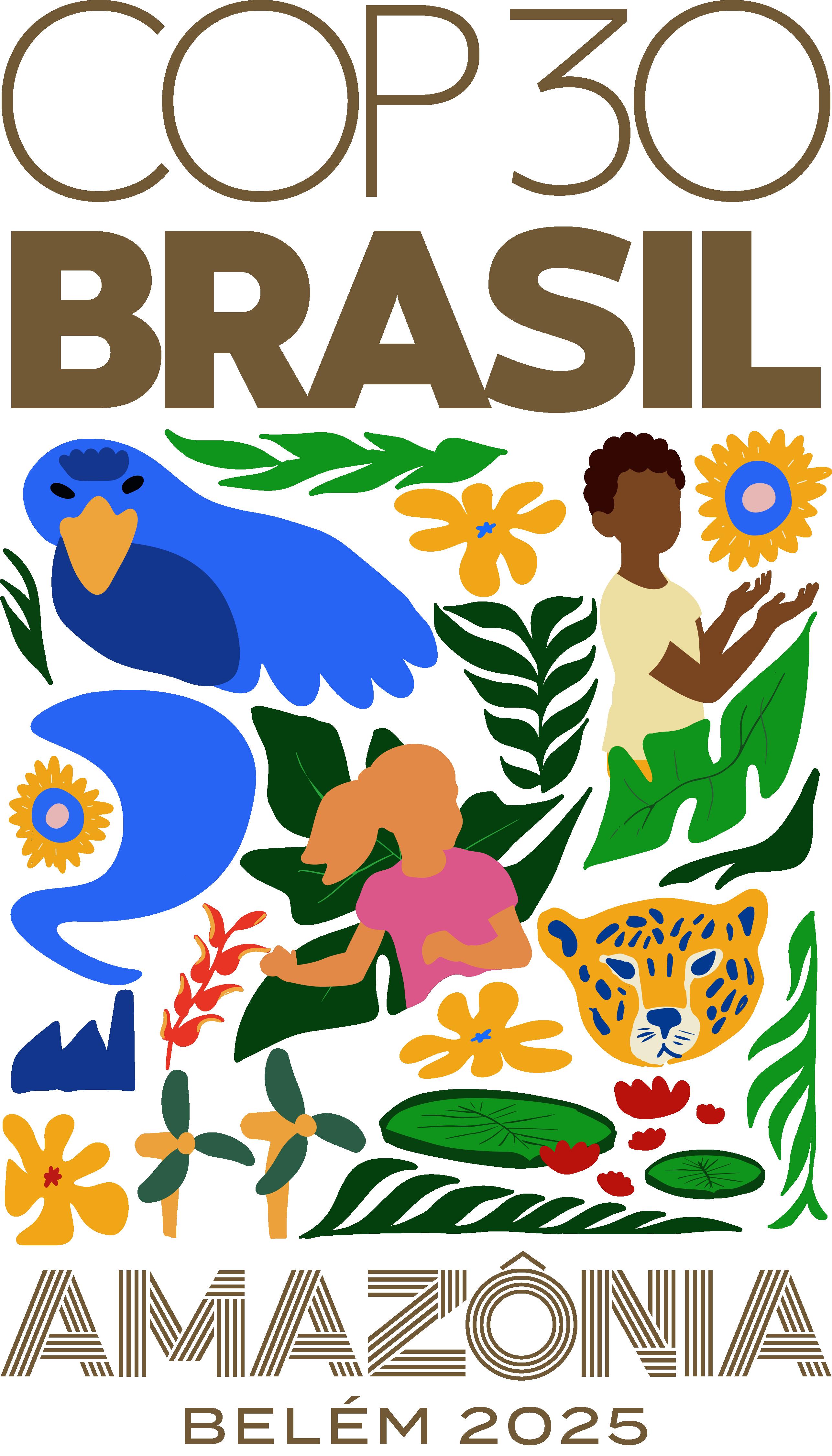
AUTHOR: JENNIFER LATCHMAN-ATKINS
When we think of paradise we often transport ourselves to a tropical island. A book in one hand and a cocktail in the other, while kicking back on a white sandy beach, inhaling the warm salty air and listening to the rhythmic musings of the beautiful blue ocean.
Islands in the Caribbean Sea, the Quintana Roo coastline in Mexico andpopular beaches along the Florida coast historically have earned the title of paradise.
Along with breathtaking beaches, this region boasts some of the most biologically rich marine environments in the North Atlantic Ocean, which includes extensive coral reefs, mangroves, seagrasses and thousands of species of fish and marine mammals. Each year, millions of visitors descend with the dream of enjoying a pristine environment, ripe for rest, relaxation and recreational sports such as sailing, fishing, snorkeling and diving.
However, since 2011 these precious coastal regions have come under threat from a 20 ton sea menace!
First noted by Christopher Columbus in 1492, the Sargasso Sea is the largest region of the North Atlantic Ocean, with an area of about 3.5 million km2. Sargassum, a brown pelagic macroalgae, or seaweed, has historically thrived in healthy quantities in the Sargasso Sea. It has provided critical support for a myriad of commercially viable, endangered and endemic marine species such as whales, sea turtles, frogfish, shrimp, tuna, swordfish and marlin. With a vibrant ecosystem, and an array of flora and fauna, the Sargasso Sea has been referred to as the “Golden Rainforest”. Because of its important biodiversity, the Sargasso Sea is protected by the Hamilton Declaration and overseen by the Sargasso Sea Commission.
To the bewilderment of everyone, in 2011 satellite imagery from NASA showed an explosion of sargassum growth in a new southern geographical location, creating what is widely referred to as, the Great Atlantic Sargassum Belt, or the GASB. Floating more than 5,000 miles from the west coast of Africa through the Caribbean Sea and into the Gulf of Mexico, the GASB is the largest and reportedly the most harmful algal bloom on the planet! Experts predict that during its most fertile months, the GASB contains an average of 20 million tons of toxic matter and it has caused a range of environmental, economic, and social problems, with implications for coastal communities, tourism, and marine ecology.
While the exact culminating factors that spurred the initial development of the GASB remain a subject for discussion, contributing factors that aid in the continued proliferation of sargassum have been identified as:
• Nutrient Influx: Agricultural runoff from the Congo, Amazon, Orinoco and Mississippi rivers.
• Dust from the Saharan Desert.
• Upwelling of nutrient dense water from the deep sea.
• Changes in natural ocean currents and wind patterns have pushed sargassum into areas where it was previously uncommon.
• Climate change provides an abundance of sunshine and warmer ocean temperatures are thought to facilitate the rapid growth of sargassum.
The GASBs magnitude causes migratory interference for native and non-native fish populations. Fisherfolk may find their regular catch is no longer plentiful or
available, while new varieties of fish and marine species may migrate into the area. Dr. Shelly- Ann Cox, Fisheries Officer, Barbados, notes that while there has been a decrease in flying fish and mature dolphin fish in Barbados, they’ve seen an increase in juvenile dolphin fish and small lobsters, which are normally uncommon.
Floating sargassum mats block essential sunlight, which is necessary for the healthy growth and development of coral reefs, seagrass and sea moss beds, and mangrove forests. These reefs, beds and forests not only help to shore up coastlines; they provide habitats for a myriad of marine species and aid in capturing carbon from the atmosphere.
Arriving seemingly overnight and smothering beaches at an accelerated rate, sargassum’s arrival requires a rapid response as decomposition begins within approximately 48 hours of making landfall. As it decays, sargassum changes the pH level of the water at the shoreline. Dr. Brian LaPointe, Research Professor at Florida Atlantic University’s Harbor Branch Oceanographic Institute, has been studying the changes and states that the resulting nitrogen/phosphorus imbalance causes additional stress to coral reefs and can lead to coral bleaching. “Dead zones” where decomposing sargassum sucks oxygen from the water are also common, leaving native plants and marine life struggling to survive. Sadly, it doesn’t stop there. Six of the seven sea turtle species are on the endangered species list and all are found in this region of the North Atlantic Ocean. Nesting sea turtles may have to travel miles to find a clean beach to lay their eggs, and incubating eggs are at risk of being crushed during beach clean-up. The sex of incubating sea turtles also may be altered, as sargassum strandings can change the temperature surrounding the eggs, a determining factor in the sex of the embryo.

Once hatched, the journey out to sea and safety is thwarted. Hatchlings are at increased risk from sun exposure, disorientation and predators, as they inchmeal across mounds of washed up sargassum trying to make it to the ocean and safety.
As the GASB makes its 5,000+ mile journey, it absorbs carbon dioxide from the atmosphere, and toxins and heavy metals such as lead, arsenic and cadmium from the ocean. This is a favorable side effect, but sadly, collected sargassum is then often dumped on land in deep landfills. Further research has to be done, but this common practice raises the question of whether the potential now exists for these toxins and heavy metals to seep into the local groundwater. Dr. Brian LaPointe, Research Professor at Florida Atlantic University’s Harbor Branch Oceanographic Institute, works with several islands across the Caribbean. He shockingly states, “they have literally
taken the beach to the dump”. This is not an exaggeration, heavy machinery, such as bulldozers, used over several years to remove sargassum, have caused extensive beach erosion. The loss of shorelines have lasting impacts to tourism, recreational activities
With a vibrant ecosystem, and an array of flora and fauna, the Sargasso Sea has been referred to as the “Golden Rainforest”. Because of its important biodiversity, the Sargasso Sea is protected by the Hamilton Declaration and overseen by the Sargasso Sea Commission.
and, of course, causes the natural loss of coastal habitats and can lead to flooding. Arriving seemingly overnight and smothering beaches at an accelerated rate, grown men can almost get lost in it. Removal needs to take place rapidly as decomposition begins within approximately 48 hours of sargassum making landfall. As it rots, it releases hydrogen sulfide, which has the unmistakable stench of rotting eggs, ammonia and methane, which cause impacts to human health and adds to greenhouse gas emissions. Tourists and local residents have reported an increase in headaches, nausea, rash, upper respiratory irritation, sneezing and an inability to concentrate. Dr. Dabor Resiere, Intensive Care Unit, University Hospital of Martinique, has been the lead author of several papers citing the potential for even more serious medical conditions such as cardiovascular, ocular and neurocognitive symptoms with prolonged exposure to hydrogen sulfide and ammonia. →
→ Local residents have also complained of mental health stresses, as they are plagued with insomnia and are no longer able to enjoy their natural resources. A family day at the beach is hampered by the fly-infested mass on the beach, brown sludge at the shoreline and the unmistakable stomach turning stench. The corrosion of electrical appliances such as fridges, microwaves, AC units and jewelry have also been reported and are attributed to the off gassing of the decaying sargassum.
In 2015, the government of the Quintana Roo state of Mexico, hired 5,000 day laborers, working in four-hour shifts, to remove seaweed from more than 100 miles of beach. In tourist-haven Cancun, workers raked approximately a half-million cubic feet of seaweed which amounted to more than 1,000 truckloads.
“The greatest single threat to the Caribbean economy I can imagine”, Hilary Beckles, Vice Chancellor, University of the West Indies said on the issue of the sargassum influx.
According to the World Travel and Tourism Council’s 2019 report, the Caribbean is ranked as the most tourismdependent region in the world, with eight out of the ten most tourism-dependent countries located there. In 2022, $37.5 billion was reportedly generated from tourism alone. Tourism is the lifeblood of the Caribbean and with these statistics, it is not difficult to conclude that if tens of millions of visitors can no longer enjoy their vacations, over time the potential exists for a massive loss in tourism revenue with far-reaching, and potentially catastrophic results.
On a local, and much more personal level, fisherfolk will continue to experience a strain on their financial stability with:
• Fewer overall days at sea.
• Changes in available catch.
• Difficulty getting their boats through the sargassum mats.
• Increasing cost of repair to their boats and fishing gear because of sargassum damage.
Research is being conducted by the educational and scientific community, and a few private-sector companies are racing to develop solutions for valorization and

mitigation. Solutions being discussed include:
• Collect sargassum while it’s at sea. A costly endeavor, but one that mitigates beach erosion and several other issues associated with decomposing sargassum after it makes landfall. There are several companies that have developed specific boats, or re-engineered fishing boats, for open-sea sargassum collection.
• Remove sargassum from beaches by hand with rakes and carts, which reduces beach erosion and protects coastal ecosystems. This also provides employment opportunities for local residents.
• Remove harmful nutrients, then sink sargassum deep into the ocean. This sequesters carbon in the deep sea for hundreds, if not thousands of years. However, this also leaves questions about how this practice might impact the deep sea over the long run.
• Develop safe and sustainable onshore methods for storage and disposal.
• Valorize sargassum by repurposing it for industrial or cottage industry use, i.e. biofuel, plastics, fertilizer, paper and construction materials, such as bricks.
• Fund further research into the true root cause of the phenomenon to better understand the threat.
• Engage and hold accountable, specific countries and entities, whose practices aid in the development of the GASB.
• Anchor mesh barriers offshore to prevent sargassum from reaching the beaches, thus allowing safe collection out at sea.
• Implement wide use of SaWS - Sargassum Warning System, a system using data from NASA and developed by one of sargassum’s leading researchers, Dr. Chuanmin Hu, Professor, University of South Florida, to better prepare for major influxes.
Without doubt this is a geo-political issue involving nations on the African and South American continents, the United States, Mexico and independent Caribbean nations, as well as the Caribbean territories of countries of the European Union.
Experts agree that the The Great Atlantic Sargassum Belt isn’t going anywhere for the foreseeable future. Therefore, innovation and financial aid to support sustainable clean up, disposal and repurposing efforts are vital to help preserve the region’s future and to avert further crisis. Of the seventeen SDGs established by the United Nations, the impact of the Great Atlantic Sargassum Belt relates to at least seven, and thankfully the UN is working through the UNEP and UNDP across the region on the issue, but more needs to be done. It is critical that all stakeholders are engaged, these include:
• International governments, including those involved with the G7, G20 and COP
• Regional governments
• Tourism industry
• Scientific and educational communities
• Environmental agencies
• Private sector
• Local residents
Ultimately, we are one interconnected and interdependent global community, and therefore a menace to one, is a menace to all.
The author, Jenny Latchman-Atkins, is of Caribbean descent. She is passionate about exploring the effects of the Great Atlantic Sargassum Belt and has written a featurelength documentary “Sea Menace”, to explore the four pillars of impact: Ecology, Environment, Public Health and the Economy. To meet Jenny and hear more about the topic, watch the Sea Menace Sizzle Reel. ■
To support the making of this film, please contact her directly at jennyla@goodgoblinproductions.com


Brunnbäck is a small Community with about 23,000 inhabitants located in the southeast of Avesta, a Municipality in Dalarna province in Sweden. Brunnbäck is a beautiful place up on the hill with forest and the big Lake Dalälven that stretches 541km.
In Year 1521, there was a historic battle between Sweden and Denmark ( War of Liberation 1521 - 1523 ) where Sweden won over Denmark. This was a massive victory for Sweden and Gustav Vasa. At Brunnbäck there is a big stone as the symbol for the 1521 victory, and the people can go there and read this historical memory on site.
Hence the name of this historic high Quality water from Brunnbäck and here our water is coming from. 16th May 2023 it has been 500 years since the historic battle was in Brunnbäck Sweden, this day 16th May the Swedish army hold a ceremony in Brunnbäck to the memories.
“Today’s Sweden was born at Brunnbäck.” Börje Forslund
The water is approved by the Swedish Livsmedelsverket , a Report issued by the Accredited Laboratory and Eurofins with a pH 7.8 with minimal salt and Flourid in the water. It is a high Quality mineral water one of the best in Sweden documented.
My name is Rickard Nilsson I’m 39 years old and I am the CEO & Founder
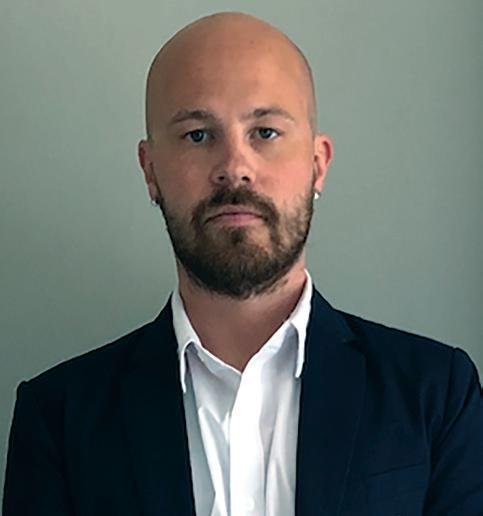
of Brunnbäck Sweden Natural Mineral Water AB. I was born and raised in Avesta and I live there now with my kids & girlfriend.
Future board member Krister Larsson has massive experience of filling machines over 25 years both in Sweden and abroad among very large companies , Me and my past away father Jimmy have know Krister for about 10 years and he is my close friend and my right hand, and he is the technical chief for my company.
I Founded Brunnbäck Sweden February 20th 2022. We are growing slowly but at a good pace. We are marketing a lot and we are been seen in DAZN streaming service with Brunnbäcks collaborations with Muay Thai For Life Gala , among many other collaborations. And we are showing us very much on every social media platform.
My vision is to start selling this Quality water worldwide, and I will also focus on helping vulnerable people who need water by donating at least 1 million

liters of water each year, that shows in the bottle.
Our water Factory will be 100 % powered by solar energy and batteries that I have about 20 years of experience of and working with today besides Brunnbäck. Our water will be transported and distributed to our customer by electric trucks or vehicles, home delivery maybe.
Its more than just a productit`s water with History & Purpose
If you read this article feel and think like me that you want to make a difference in this world, I am looking for the right investment partners to help me start building the Factory and sell this Quality water worldwide. All the permission is short as done. But I need the funds to start bulding this Factory. My work so far is prepere the site , the new 1521 bottle design , permission with the community , fillingmachines and transport , marketing on social media plattforms and live streams on DAZN
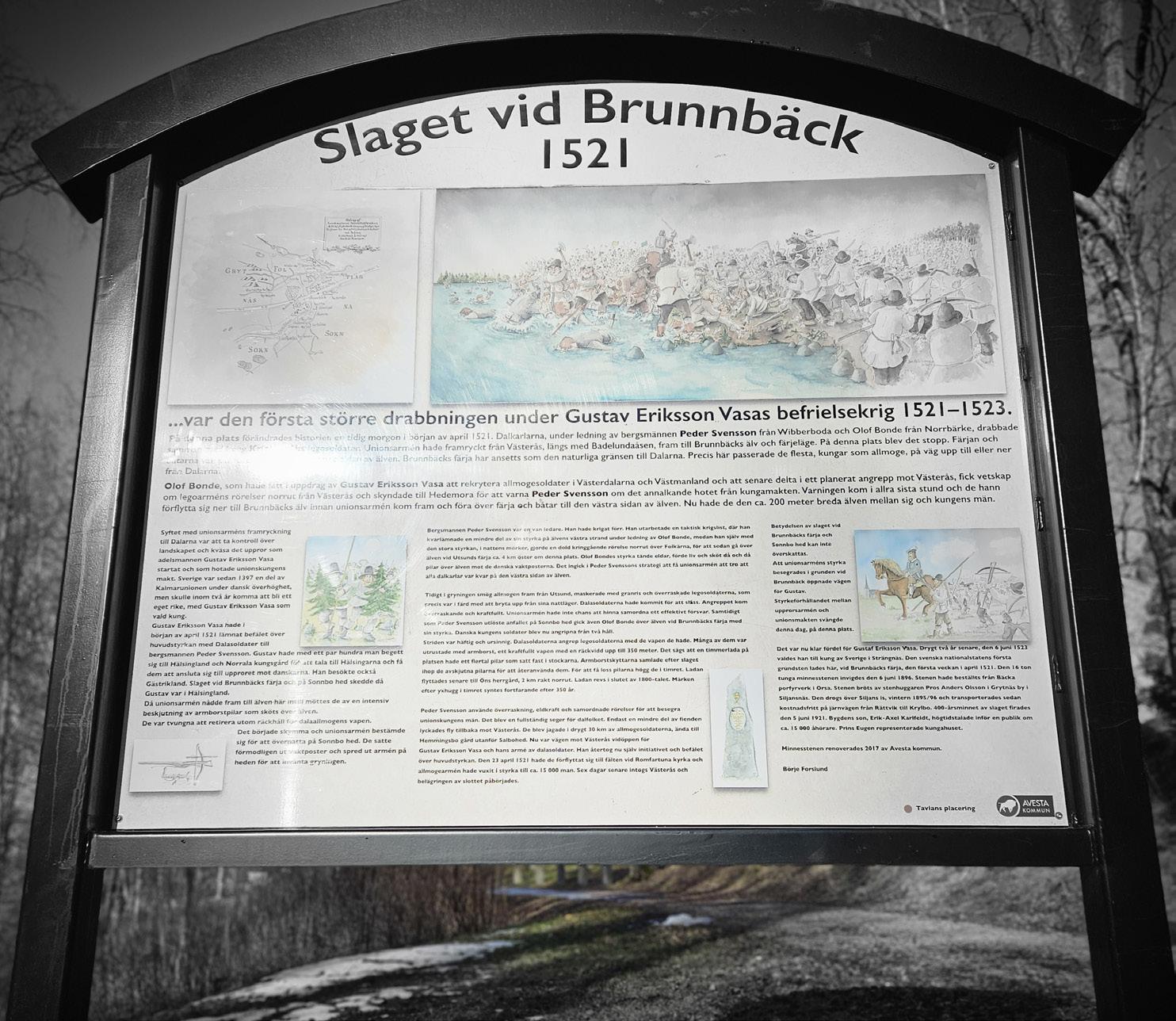

in MMA galor with hugh views. I have so far put in around 68,000 Euro in cost with my own money.
I plan to launch the products to the market in 2027/2028, I want to invite my future investment partner to come to Sweden and Brunnbäck and I will show you the location and the plans. In 2024 I have signed NDA dokuments with 2 future investors that has showed a big interest in this.
So you are most Welcome if you are likeminded to me. I have this vision /plan since 2013 and is the right time to put Brunnbäck Sweden 1521 on the world map and help a better world.
Brunnbäck Sweden 1521 USP
Low of salt & Flourid
High Quality water pH 7,8
Historic water year 1521 - 1523
Water with a donating Purpose ■


We can collectively help accelerate the rate of building renovation

In the European Union and the United States, major policies are defining efforts to reduce greenhouse gas emissions and achieve energy efficiency.
The European Climate Law, for example, establishes a goal of net zero greenhouse gas emissions by 2050 and includes legal requirements for EU countries to set intermediate targets for reducing emissions. In the United States, the Inflation Reduction Act commits to achieving a 40% reduction in economy wide GHG emissions by 2030.
As the momentum for achieving net zero economies increases, building renovation has emerged as a central emphasis due to several factors:
• Building operations, the building construction industry, and building and infrastructure materials generate 40% of annual global GHG emissions
• According to the US Department of Energy, residential and commercial buildings use about 40% of the nation’s energy for lighting, heating, cooling, and appliances while commercial buildings consume 70% of all electricity
• In Europe, the buildings sector consumes 40% of the continent’s energy demand.
• Building materials such as concrete, steel, and aluminum lock carbon emissions in place and contribute 23% of the total global CO2 emissions per year
• Projections indicate that the largest wave of building growth will occur from 2020 through 2050
Building renovation offers an environmental and economic way forward
Several methods exist for increasing energy efficiency and reducing the carbon footprint of commercial buildings. Design optimization based on reducing carbon emissions minimizes the use of materials that embody carbon and transitions to integrating sustainable materials or decarbonized conventional materials into building designs. Using recycled materials reduces the carbon footprint of buildings. Advanced connected and interoperable technologies allow equipment and
systems to communicate with one another and conserve energy while meeting the lighting, security, safety, cooling, and heating needs of residents. For example, Installing LED lighting systems and then connecting those systems to other building control systems reduces energy consumption and costs.
Upgrading buildings for reduced environmental impacts also produces a promising economic outlook for commercial property owners. Renovations focused on green buildings that include replacing outdated lighting fixtures with connected lighting systems, installing energy-efficient HVAC systems, and using low-carbon building materials reduce energy costs. In turn, improving indoor environmental quality and sustainability promotes the health and well-being of employees and residents. Sustainable, human-centric workplaces attract tenants and respond to the expectations of staff returning to the office.

Green building projects produce higher economic returns
Certainly, a building renovation project requires an investment. However, improving the energy efficiency and occupant satisfaction of a property can yield a higher return-on-investment.
Several analyses of new green building and renovation projects compared to standard construction practices show a higher ROI within a shorter time span. Profitability increases through improved energy efficiency and decreases operating costs. The ability to attain healthy/green building certifications demonstrates the commitment to sustainability that tenants, clients, and employees seek.
Sustainable finance options offset |the challenges of acquiring the capital needed for green building and renovation projects. Blended financing allows owners to increase the scale of projects while controlling risk. Building owners may also implement renovation plans through innovative financing methods that include light-as-a-service

AS THE CONSEQUENCES OF CLIMATE CHANGE BECOME MORE APPARENT EACH DAY, THE LEVEL OF URGENCY—AND UNCERTAINTY—INCREASES. MITIGATING THE EFFECTS OF CLIMATE CHANGE REQUIRES COMMITMENT FROM EVERY INDIVIDUAL, CORPORATION, AND GOVERNMENT.
(LaaS), energy-efficiency-as-a-service (EEaaS), and energy services company (ESCO) models. Each addresses market barriers, enables energy efficient technologies through monthly payments rather than large up-front capital costs, and encourages owners to invest in energy efficiency without immediately receiving the benefit.
Mitigating climate change requires an immediate response and long-term planning
As the consequences of climate change become more apparent each day, the level of urgency—and uncertainty— increases. Mitigating the effects of climate change requires commitment from every individual, corporation, and government. While international policies set long-range targets for achieving net zero economies, efforts to reduce carbon emissions and energy consumption must continue and increase. As a result, construction companies must commit to replacing materials that contribute to emissions
sustainable building materials.
Encouraging this commitment begins with increased resolve at the corporate level to reduce emissions through green building renovations and new building designs.
Interoperable, connected technologies offer a solution for reducing greenhouse gas emissions and energy consumption. Within those technologies, LED lighting systems serve as the starting point through flexible design options, low operating costs, and excellent heat dissipation. The capabilities offered through LED lighting systems that connect with other building operations allow design teams to create sustainable office environments that appeal to tenants and occupants. Focusing on such critical solutions at COP28 can help accelerate climate change mitigation. ■
To learn more about how connected technologies align with global energy policies, read our white paper Good connectivity: A key to decarbonizing the building sector.
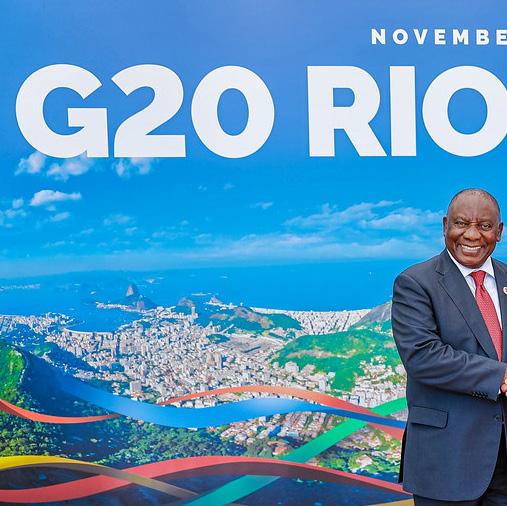
PREVIEW TO G20, B20 & W20
Johannesburg,
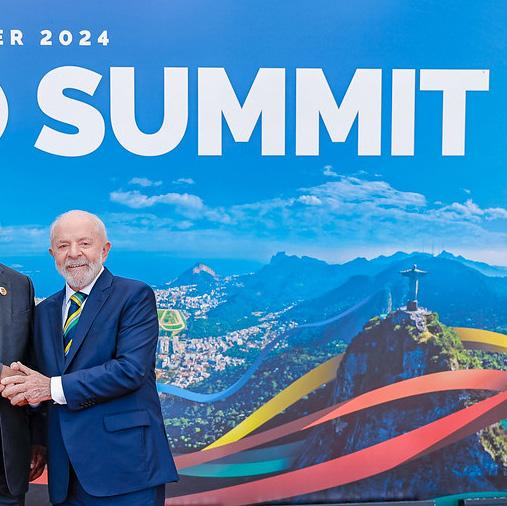



Africa’s G20 Presidency follows on the heels of Brazil’s very successful G20 Presidency last year and takes place ahead of the G20 Presidency of the United States of America in 2026.
As a leading forum for international economic cooperation, the G20 plays an important role in shaping and strengthening global architecture and governance on major international economic issues.
For the first time in its history, the G20 is being hosted on the African continent following the admission of the African Union as a member of the G20.
This is a moment of great significance for South Africa, the African continent and the world in that it was in Africa where humans developed the capacity and the impulse for cooperation.
Cooperation has been one of the key markers of human development touching on many aspects of life, from survival and social organisation to technological and cultural progress, which is what the G20 was established for. To foster cooperation to deal with the challenges the world faces. Cooperation is the bedrock of human civilisation.
Without cooperation and collaboration – between individuals, groups, peoples, nations – humanity cannot progress.
As we confront the challenges of the 21st century – from climate change to pandemics, from poverty to terrorism, from migration to artificial intelligence –we are again called upon to harness that most powerful, and that most enduring, of human attributes: mutually beneficial cooperation and collaboration.
This is a time of rising geopolitical tensions, unilateralism, nationalism, protectionism, isolationism, rising debt levels affecting poor countries in the world and a declining sense of common purpose.
Yet, this is a moment when we should be standing together as a global community to resolve the problems that confront humanity by ending the wars and conflicts that are causing such hardship and misery to many people around the world.
We are called upon by the exigency of the moment to act together with greater urgency to halt the destruction of our planet. This is a moment when we should harness the abundant resources we collectively possess and the remarkable technologies that human ingenuity has produced to overcome poverty and inequality,

World Economic Forum on South Africa’s G20 priorities
Davos-Klosters, Switzerland, 21 January 2025
unemployment, especially youth unemployment, and the abuse of women, once and for all.
Thirty-three years ago, the founding president of democratic South Africa, Nelson Rolihlahla Mandela, spoke here at Davos.
He said:
“Our interdependence, bringing us together into a common global home, across the oceans and the continents, demands that we all combine to launch a global offensive for development, prosperity and human survival.”
In pursuit of this objective – and in giving effect to the mission of the G20 –South Africa will focus its G20 Presidency on three themes: solidarity, equality and sustainable development.
It is South Africa’s firm view that these themes can best be taken forward through the collective actions of institutions like the G20 and various multilateral institutions of the world, especially the United Nations, the WTO and global financial institutions which should be reformed and be more representative and responsive to the needs of the citizens of the world.
We will seek to get the G20 to focus more on how we can enhance solidarity through collective efforts to ensure that in the pursuit of progress for all, no person and no country is left behind.
The rights and freedoms of one people cannot be separated from the rights and freedoms of all peoples.
This is the foundation on which solidarity is built.
One of the greatest impediments to growth, development and stability is the persistence of inequality within and between countries.
The pursuit of the UN Sustainable Development Goal on reducing inequality is as much of an economic imperative as it is a social imperative.
As the G20 we need deliberate and coordinated efforts to focus on inclusive growth based on responsive trade and investment to grow the incomes of poor nations and the poorest in society and to ensure equal access to opportunities especially for women and young people.
For nations to flourish, equality and prosperity must be available to everyone – regardless of gender, race, religious beliefs or economic status.
Cooperation has been one of the key markers of human development touching on many aspects of life, from survival and social organisation to technological and cultural progress.
In addition to huge gaps in economic capabilities and levels of human development, countries of the Global South face a lack of predictable financing for development and climate change, high levels of debt and vulnerability to pandemics.
Debt sustainability for low-income countries is one of the four priorities of South Africa’s G20 Presidency.
In the world we inhabit today, the pursuit of equality and the practice of solidarity cannot be separated from sustainable development.
We need to meet the needs of the present without compromising the ability of
future generations to meet their own needs. It is therefore in the interests of all countries to act with greater urgency to reduce global emissions – and for industrialised countries to support the climate actions that poorer countries must necessarily take in line with and support of decisions of UN climate change summits.
Another of South Africa’s priorities for its G20 Presidency is therefore to mobilise finance for a just energy transition.
We will seek agreement on increasing the quality and quantity of climate finance flows to developing economies as agreed at various UN climate change summits.
We will continue to call on global financial institutions on the redirection of Special Drawing Rights, which are left unused.
It is simply not fair that over 60 percent of Special Drawing Rights go to a handful of wealthy countries.
These drawing rights should be redirected to enable countries in Africa and other parts of the Global South to realise their developmental aspirations – to enable them to invest in infrastructure, in industrial development, in education and training, and in health care.
We need to leverage private capital and use innovative forms of finance and taxation to raise additional resources for sustainable development.
Global finance institutions should derisk and support more financing for emerging and developing economies.
We need to support country initiatives aimed at addressing climate change, such as the Just Energy Transition Partnership that South Africa has entered into with a number of countries of the Global North.
As we accelerate the transition to lowcarbon economies in a manner that is just and inclusive, we must recognise the damage that climate change has already wrought. And will continue to wreak.
In light of this, South Africa has therefore made the strengthening of disaster resilience as another of the priorities of its G20 Presidency.
The increasing rate of climate-induced natural disasters is affecting countries that can least afford the costs of recovery and rebuilding.
In order to address this, special financing and insurance mechanisms must be made available to scale up funding for postdisaster reconstruction.
Since the dawn of the industrial age,
the benefits to humanity of economic growth have been achieved at the cost of environmental destruction.
If we are to survive and thrive as humanity, we must change this.
We must pursue development pathways that reconcile growth with urgent climate action.
Another of South Africa’s priorities for its G20 Presidency is to harness critical minerals for inclusive growth and development.
We need a G20 framework on green industrialisation and investments to ensure progress towards a grand bargain that promotes value addition to critical minerals close to the source of extraction.
We also need the development of low carbon manufacturing value chains which can support decarbonisation and industrial development.
There is a need to promote beneficiation and local value addition of resources at source resulting in an additive rather than an extractive relationship.
As minerals extraction accelerates to match the needs of the energy transition, the countries and local communities endowed with these resources must be the ones to benefit the most.
We will use this G20 to champion the use of critical minerals – through a programme of green industrialisation – as an engine for growth and development in Africa and the rest of the Global South.
As this will be the first G20 summit held in Africa, it is a valuable platform to demonstrate Africa’s promise.
Many agree that Africa is the next frontier of global growth and productivity.
The African continent has an unrivalled natural resource endowment, with the youngest population of all continents.
Africa continues to be an expanding market for goods and services.
The African Continental Free Trade Area has the potential to change the economic and social fortunes of the continent.
We will seek G20 support for the AfCFTA Adjustment Fund that will enhance inclusive growth, sustainability and regional integration.
We will look to consolidate various G20 initiatives related to Africa into a flagship agreement for cooperation focused on implementation of investments in productive sectors in Africa in areas such as infrastructure.
An infrastructure revolution is propelling Africa’s growth.
We seek investments in the development of skills for Africa’s youth and the economic empowerment of its women.
In the health sector we would want the G20 to support the production of pharmaceutical products such as therapeutics and vaccines to deal with pandemics.
The digitisation of the continent to enhance trade and development is a ey enabler.
Through its G20 Presidency, South Africa is well-positioned to advance global cooperation and build partnerships for growth and development.
South Africa has a rich history of nclusive dialogue and common action.
Over the last few years, the South African government has been working closely with social partners in business and in labour to address key national challenges and drive inclusive growth.
This cooperative culture and approach were taken to a higher level with the establishment of the Government of National Unity following the elections we held in May last year.
The Government of National Unity, made up of ten political parties, has been vital to stability and inclusive governance, and has contributed to greater interest among investors in South Africa’s economic prospects.
The seeds of human progress were sown in Africa.
In Africa, the earliest forms of cooperation were forged and developed.
As the leaders of the G20 return to Africa, we make a call that we all harness these essential capabilities that will make us take action to build a better and fairer world.
We intend that the G20 in Johannesburg this year should be a forum where cooperation and collaboration amongst the leading economies in the world will be taken to a higher level.
Acting together, we should build an inclusive, just and equal world in which all may prosper, leaving no one and no country behind.
I look forward to welcoming you to the G20 in Johannesburg later this year.
Even if you do not participate in any of the 130 G20-related meetings, I invite you to come and see South Africa for yourself, the most beautiful country in the world.■

Cas Coovadia
Since B20 Brazil handed the baton to B20 South Africa, the past few months have been dynamic and productive. We deeply appreciate the seamless handover process and the collaborative efforts of the B20 Brazil Sherpa, Ms. Constanza Negri and her team. Like our counterparts in Brazil, we remain focused on our mission: to develop actionable, business-driven policy recommendations for the G20.
Strong progress on our mandate
In April, we finalised the appointment of eight Task Forces where a diverse and skilled coalition of global business leaders, including CEOs of multinational corporations, entrepreneurs, academics, and business association representatives will collaborate to advance inclusive growth. Their collective expertise and commitment will steer policy proposals that reflect both global imperatives and the African continent’s unique priorities.
We are on track to deliver robust, businessled policy proposals to the G20. The depth of engagement, expertise and collaboration we have already seen is inspiring. This is where meaningful change begins.
The B20 South Africa Task Forces are co-led by a group of business leaders across Africa, Asia, Europe, the Americas and the Middle East. Their diverse perspectives reflect the B20’s commitment to regional inclusivity, sectoral relevance and gender balance. Notably, for the first time in the B20’s history, 50% of Task Force Chairs are women, a milestone that underscores South Africa’s leadership in promoting inclusive and representative global dialogue. Additionally, our Local Business Advisory Council (LBAC) and International Business Advisory Caucus (IBAC) are injecting diverse perspectives into our work.
Path to the B20 Summit: Delivering policy recommendations by September The Task Forces will now accelerate their work to finalise policy recommendations for submission to the G20 by September 2025.
Key stages include:
1. Expert Consultations: Engaging with industry leaders, academia and government stakeholders.
2. Draft Review: Refining proposals based on multilateral feedback.
3. Stakeholder Dialogues: Sharing insights through regional dialogues and partnerships.
A groundswell of support
We are engaged with government representatives and G20 South Africa working groups, ensuring our strategies resonate at the highest levels. Through discussions and stakeholder sessions, both locally and internationally, the response has been overwhelmingly positive, reinforcing the private sector’s critical role in advising global policy-making. ■
The B20 South Africa mission is clear: Inclusive Growth and Prosperity through Global Cooperation. This is more than a theme. It is the benchmark of our collective impact. Join us in Johannesburg, South Africa from 18-20 November 2025
We are on track to deliver robust, business-led policy proposals to the G20. The depth of engagement, expertise and collaboration we have already seen is inspiring. This is where meaningful change begins.




Narnia Bohler-Muller head of delegation of W20SA and divisional executive at the Human Sciences Research Council

The Group of 20 (G20) is a forum of the largest economies in the world that meet regularly to discuss the most pressing issues facing the global economy. Together, the G20 accounts for more than 80% of world GDP, 75% of global trade and 60% of the population of the planet. In 2023 the African Union (AU) joined the G20.
Brazil handed the Presidency over the South Africa in December 2024 and South Africa holds the G20 presidency ntil November 30, 2025, when we pass the baton to the United States of America.
Women 20, better known by the acronym W20, is one of the G20’s official engagement groups in the social track focused on promoting gender equity and women’s economic empowerment. Engagement groups are independent collectives in the Sherpa track led by individuals and organisations (civil society, academia, business) from the host country, who work with other organisations from G20 countries to develop and formally submit policy recommendations to G20 leaders for consideration. W20 South Africa works closely with the Women’s Empowerment Working Group in the Ministerial Track as well as G20 EMPOWER.
Women 20 was established during Australia’s presidency in 2014 and had its first meeting in Turkiye in 2015 and, like all other engagement groups, aims to recommend policies and commitments to the leadership of G20 countries.
The W20 Brazilian Presidency (2024) focused on five thematic areas: women’s entrepreneurship, women in STEM, the care economy, ending violence against women, and climate justice, with a
transversal focus on race and ethnicity intersectionality. Amongst others, Brazil enhanced W20’s data management capabilities by implementing an innovative digital platform which the South Africa is taking forward.
W20 South Africa aims to continue the legacies of Brazil and all past Presidencies as we celebrate the 10th anniversary of W20.
G20 theme for the South African Presidency: Solidarity, Equality, and Sustainability. These themes where shared at the United Nations by President Cyril Ramaphosa in his address on 24 Sept 2024. “Through solidarity we seek to advance a unified effort and mutual support among member nations. By advancing equality we seek to ensure fair treatment, opportunities and advancement for all individuals and nations… irrespective of their economic status, gender, race, geographic location or other characteristics. Sustainable development is about meeting the needs of the present without compromising the ability of future generations to meet their needs.”
Under this umbrella the W20 theme for the South African Presidency is Women n Solidarity towards Sustainable SocioEconomic Development because the moral and economic case for gender equity is clear as illustrated by Christine Lagarde, Managing Director, International Monetary Fund (March 2017): “As countries around the world seek to grow their economies and reduce inequality, tapping into the huge potential of women can be a game changer.” W20 continues to reaffirm its commitment to achieving the UN Sustainable Development Goals (SDGs) particularly SDG 5 to advance women’s economic empowerment as a catalyst for sustainable development. →
The W20 Brazilian Presidency (2024) focused on five thematic areas: women’s entrepreneurship, women in STEM, the care economy, ending violence against women, and climate justice, with a transversal focus on race and ethnicity intersectionality. Amongst others, Brazil enhanced W20’s data management capabilities by implementing an innovative digital platform which the South Africa is taking forward.
The key objectives are to:
• Guarantee the inclusion of W20 recommendations in the Leaders Declaration
• Honour ten years of W20
• Build on initiatives to ensure the sustainability of W20
• Promote people centric advocacy through effective outreach and knowledge sharing
• Strengthen the voices of Africa and the
• Global South whilst remaining faithful to the global agenda.
The seven themes encapsulate a decade of effort, infused with a unique African and Global South perspective. With disability as a cross-cutting focus, the South African value of Ubuntu — “I am what I am because of who we all are” — will guide our work in solidarity toward women’s sustainable socio-economic empowerment.
The South African Presidency has established seven thematic areas: Entrepreneurship and Financial Inclusion; The Care Economy; Climate Justice and the Environment; Gender-Based Violence and Femicide; Health Equity for Women and Girls; Women, Land, and Agriculture; and Education, STEM, and the Digital Divide.
South Africa’s ascension to the leadership of the Women20 (W20) engagement group heralds a transformative chapter in our relentless pursuit of gender equality and women’s empowerment. This moment represents more than a symbolic milestone; it is a profound affirmation of our nation’s commitment to advancing the rights and opportunities of women and girls in all their diversity, alongside the most vulnerable groups globally.
With its breathtaking landscapes, warm hospitality, and a steadfast dedication to the rule of law, South Africa has proudly stood as a beacon of resilience and potential since the advent of democracy in 1994. Anchored by a constitution revered for its commitment to justice, democracy, and human dignity, our identity as a nation is encapsulated in the Preamble, which declares our intention to:
• Recognize past injustices and honor those who fought for justice and freedom.
• Build a united society founded on democratic values, social justice, and fundamental human rights.
• Heal divisions and improve the quality of life for all citizens.
This foundational ethos mirrors South Africa’s role on the global stage
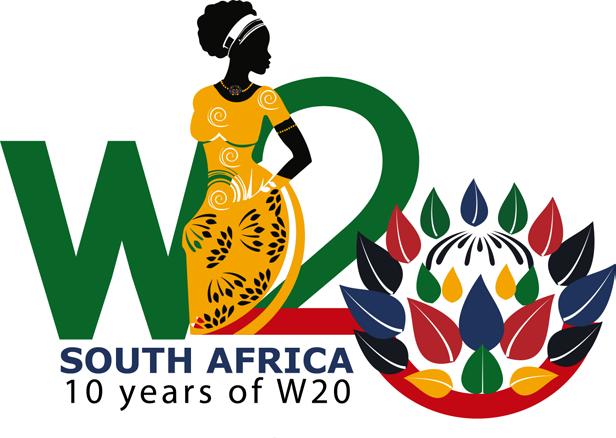
Investing in women’s financial inclusion is not simply a moral imperative; it is an economic necessity. Empirical studies consistently demonstrate that empowering women fosters community-wide benefits, generating sustainable development, stability, nd prosperity.
Beyond systemic barriers, South Africa’s leadership in the W20 paves the way to confront global challenges like genderbased violence and femicide (GBVF), climate change, food and water security, and financial and digital inclusion. It is vital that women’s perspectives and innovative solutions are at the forefront of policy discussions and decision-making processes. Collaboration with allies across sectors enables the creation of gender-responsive policies that champion equity, resilience, and progress for future generations.
As South Africa’s first democratic president Nelson Mandela profoundly stated, “Freedom cannot be achieved unless women have been emancipated from all forms of oppression.” Guided by this vision, South Africa stands firm in the belief that breaking down barriers and fostering pathways for women to lead will build institutions that are more inclusive and representative, and ultimately more productive.
This historic moment would not be possible without the unwavering commitment of our partners and supporters:
— a nation inspired by unity and intent on uplifting others.
As the first African nation and the fourth from the Global South following Indonesia, India and Brazil to hold this esteemed position as president of the G20. South Africa steps into the international spotlight with a unique opportunity to amplify the voices of women and girls from diverse communities. The W20’s core mission to promote gender-inclusive economic growth aligns seamlessly with our national values.
Under South Africa’s leadership, the goal is to champion policies that empower women economically, socially, and politically, addressing long-standing systemic barriers such as:
• Gender pay disparities.
• Limited access to education, healthcare, and resources.
• The disproportionate burden of unpaid care work.
Investing in women’s financial inclusion is not simply a moral imperative; it is an economic necessity. Empirical studies consistently demonstrate that empowering women fosters community-wide benefits, generating sustainable development, stability, and prosperity.
• Co-chair Ms. Sibulele Poswayo and grassroots activists amplify the voices of marginalized women and girls.
• Volunteer delegates from business, civil society, and academia graciously contribute their time and expertise.
• Funders such as GIZ and IDRC recognize the value of our work and invest in its impact.
• Knowledge partners commit to advancing research and collaboration to ensure the W20’s success.
Special gratitude is extended to iSAW for providing an online platform that enhances continuity across presidencies, and to the Human Sciences Research Council (HSRC) under the leadership of CEO Prof. Sarah Mosoetsa, whose support fortifies our efforts.
As we embark on this dynamic journey leading the W20, South Africa commits to fostering meaningful change and elevating voices that have too often gone unheard. We are ready to seize this unparalleled opportunity to construct a world rooted in justice, equity, and dignity for all.
We look forward to welcoming you to our Inception Meeting in May and the Summit in October as we pave the way forward, together in the spirit of solidarity and ubuntu. ■


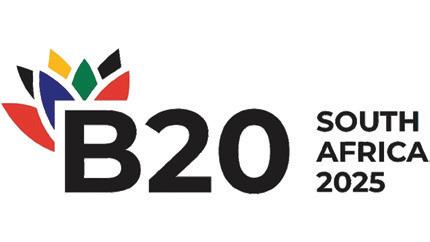

Amitabh Kant
In 2023, under the leadership of Prime Minister Narendra Modi, India hosted the G20 Summit, marking a pivotal moment in the diplomatic history of our nation – while also laying the groundwork for a transformative period in international dynamics. As India’s G20 Sherpa, I witnessed firsthand how this presidency became a defining force in reshaping the ways in which we perceive and prioritise our global developmental goals. The G20 Summit in India – which was second in a quartet of presidencies held by emerging economies – signalled the emergence of a multipolar world that was fast moving away from traditional Western-centric modalities of thought and governance. Championed by nations like India – which is both the largest democracy and a key player in the global economy – this transition culminated in the passing of the New Delhi Leader’s Declaration on September 9, 2023.
The New Delhi G20 Leaders’ Summit brought together leaders from the world’s major economies—accounting for 85% of global GDP and 75% of world trade. It showcased India’s commitment to emerging as a global champion of strategic dialogue and innovation. The theme “One Earth, One Family, One Future,” rooted in India’s cultural ethos of “Vasudhaiva Kutumbakam,” emphasised inclusivity and sustainable growth, setting the stage for an ambitious agenda that placed the interests of the Global South at the forefront.
The G20, as one of the most influential economic forums, proved critical in an era marked by economic uncertainties, especially with the ongoing impacts of the COVID-19 pandemic and geopolitical tensions. By expanding the forum to include the African Union as a permanent member, India’s presidency amplified the voices of
diverse nations, making good on our commitment to inclusive representation and governance that reflects contemporary realities of the day. It was a profound statement of intent towards equitable growth and collaboration.
The backdrop to our G20 Presidency was a shifting global landscape, where emerging economies increasingly shape the economic order. Recent forecasts by global financial institutions like the World Bank and IMF highlight that the Global South will drive three-fourths of global growth in the upcoming decades. With Asia at the forefront, India’s role as a market leader, producer, and peacekeeper becomes key. Historically, the Global South has faced governance challenges, but today these nations act as bridges between development and sustainability, learning from past crises and cultivating innovative economic approaches for the future.
The United Nations, once the bedrock of multilateral diplomacy, now finds itself confronted with challenges that have hindered its effectiveness and relevance. The sheer size and complexity of the UN system often leads to inefficiency, and its decision-making processes are hampered by outdated mechanisms. The structure of the United Nations Security Council exacerbates this stagnation. The presence of veto powers held by a select few nations has frequently resulted in paralysis, preventing timely action on pressing global issues that affect the rest of the world.
In this context, the G20 emerges as a critical platform for global cooperation. India recognized this role, while also understanding that it would inevitably be caught in the complexities of the RussiaUkraine issue, where achieving consensus would be challenging. However, as a country of considerable influence, India knew that it was essential to re-focus the
G20 on its original mandate. By emphasising collaboration and consensus-building on pressing global challenges, India aimed to reinvigorate the dialogue within the G20, steering the agenda towards themes such as economic resilience, climate action, and sustainable development that resonate deeply with all member states, especially those from the Global South. This strategic redirection sought to mitigate divisions, while also creating a spirit of unity and shared purpose among nations – so that the G20 remains as an effective and agile forum for international governance.
The New Delhi Leaders’ Declaration is a document that embodies India’s commitment to inclusivity, sustainability, and shared responsibility. The 83-paragraph Declaration, noted for its clarity and consensus, champions collective action on major global issues such as climate change, digital transformation, and social inequalities.
Central to this was the Green Development Pact (GDP), a key initiative that reflects a heightened global sensitivity to the intersection between environmental protection and development.
The Green Development Pact outlines ambitious climate goals by redefining how nations approach sustainability collectively. The GDP was built on several crucial pillars, including a commitment to curbing greenhouse gas emissions, enhancing renewable energy capacity, and promoting sustainable lifestyles. Recognising that climate change is a ubiquitous threat requiring coordinated action, the GDP sets clear targets: specifically, G20 members agreed to rapidly scale up their renewable energy capacities to triple global production by 2030. This commitment is expected to

avoid billions of tonnes of carbon emissions.
On climate financing, G20 leaders finally acknowledged the urgent need to increase climate finance from billions to trillions of dollars, highlighting that the developed world must fulfil its financial commitments to support developing nations in pursuing sustainable development goals, and that much more was needed than had been promised.
This addressed the stark reality that developing countries, often the most affected by climate change, require substantial investments to adapt and mitigate the impacts of global warming. To this end, discussions centred around establishing a New Collective Quantified Goal (NCQG) for climate financing aimed at enhancing predictability and accountability in financial commitments, ensuring that financial flows match the needs of vulnerable nations.
In addition, the GDP emphasised the significance of integrating financial institutions into climate action, championing the establishment and reform of Multilateral Development Banks. The leaders recognised that these entities must be better, bigger, more effective and representative to mobilise the necessary resources for climate initiatives, ensuring that investments reach the grassroots level where they are critically needed.
Recognising that climate change is a ubiquitous threat requiring coordinated action, the GDP sets clear targets: specifically, G20 members agreed to rapidly scale up their renewable energy capacities to triple global production by 2030.
individual actions with global climate strategies, emphasizing that sustainability is not just a governmental responsibility but a shared duty among individuals and communities.
Technological Transformation and Digital Public Infrastructure
The ambitious G20 2023 Action Plan on Accelerating Progress on the SDGs adopted by all G20 member countries strategically focuses on transformative areas such as digital transformation, gender equality, and sustainable transitions to accelerate the realisation of SDGs worldwide.
India also pushed for the mainstreaming of the concept of “LiFE” or Lifestyle for the Sustainable Development, which encourages sustainable consumption and production patterns that reduce carbon footprints. This initiative seeks to align
Further, India’s presidency spearheaded significant discussions on “Data for Development” (D4D) and Digital Public Infrastructure (DPI), recognising their role in fostering equitable growth. By defining DPI for the first time at a global level, India will be able to share its valuable experiences and best practices in building resilient, inclusive digital ecosystems. This pioneering approach sets a framework for developing countries to enhance their own digital infrastructures, tailored to their unique socio-economic contexts and needs.
India’s proposal for a global coalitionto support the deployment and scaling of DPI in low- and middle-income countries will activate this shared development. This coalition seeks to provide technical support, knowledge exchange, and co-investment opportunities to help nations build robust digital frameworks that can support various sectors, from healthcare to education and beyond. →
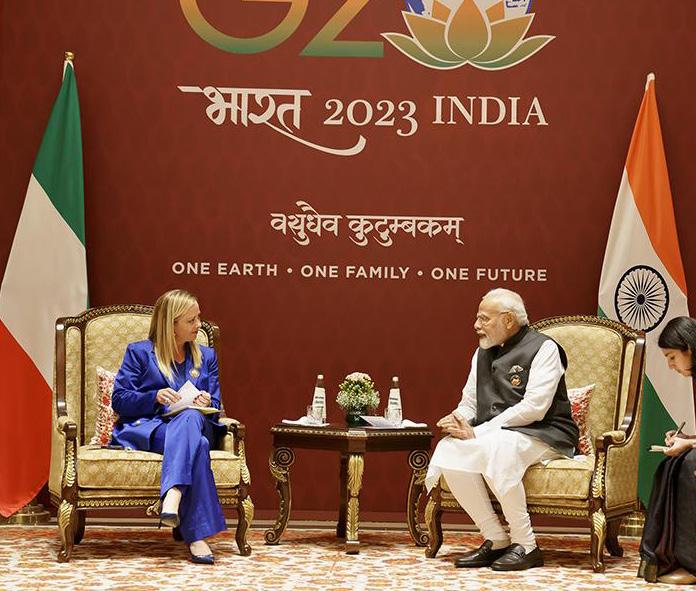
Voice of the Global South
The Summit also gave voice to historically underrepresented perspectives through the “Voice of the Global South Summit,” reaching out to 125 nations. This unprecedented gathering emphasized ‘Unity of Voice, Unity of Purpose,’ illustrating India’s commitment to inclusive dialogue and collective decision-making.
Even within the G20, India actively worked to amplify the voices of African nations, extending invitations to countries like Mauritius, Egypt, and Nigeria to participate in the forum’s dialogues. This effort resulted in unprecedented representation from African nations in G20 meetings, enabling a better understanding of their specific challenges and integrating their viewpoints into global discussions.
The most profound impact of our presidency extended beyond economic and environmental paradigms; it was in how we engaged the global community culturally and socially. India’s G20 was a
‘People’s Presidency,’ featuring 220 meetings across 60 cities, ensuring every corner of our diverse homeland rejoiced in the global communique. This vibrant engagement showcased our cultural heritage to the world, and underscored the democratic essence of our presidency.
From millet-based cuisines shared with delegates to over 7,000 artists participating in cultural showcases, the G20 in India was about fostering cross-cultural understanding. Initiatives such as the G20 University Connect series, Model G20 sessions in schools, and marathons had widespread public engagement, touching over 7 crore people through “Jan Bhagidari” efforts. This collective involvement not only resonated with our theme of “One Earth, One Family, One Future” but also rooted high-level discussions in the lives of everyday citizens.
The G20 Engagement Groups, including Business 20, Youth20, Science20, Labour20 and the Startup20 initiated by India, played a crucial role in integrating diverse perspectives into decision-making. They ensured the G20 agenda reflected the
aspirations of various sectors, with Business 20 offering essential insights and innovative solutions from the private sector. Together, these groups enriched discussions and ensured that civil society’s expertise effectively shaped the agenda.
A standout feature of our presidency was the institutionalisation of gender equality in global discussions. The formation of a dedicated Women’s Working Group represented a significant stride towards integrating women’s voices across all policy dialogues, aiming to dismantle systemic barriers to their participation in economic, social, and political realms. This exemplified the paradigm shift that India brought about towards women-led development underlining it as a cornerstone for sustainable growth.
India also used its presidency to pioneer global health initiatives, endorsing the Global Initiative on Digital Health for Universal Health Coverage. Recognising the role of technological innovation in improving health outcomes, we positioned India as a leader in global health advocacy, stressing the importance of traditional medicine as evidenced byestablishing WHO’s Centre in Jamnagar.
India’s G20 presidency successfully navigated intricate geopolitical challenges, including the Russia-Ukraine conflict, prioritizing peace and dialogue. By advocating that “Today’s era must not be |of war,” India fostered consensus on critical global issues yielding significant initiatives like the Millet Research Initiative for food security and advancing affordable digital services.
As India aims for a $35 trillion economy by 2040, it emphasizes sustainable innovation, tech leadership, and environmental responsibility. India has crafted a legacy of inclusivity and cooperation, positioning itself as a cornerstone of a more equitable and sustainable global order, inspiring future multilateral engagements as it handed over the presidency to Brazil. ■
The author is India’s G20 Sherpa and a former CEO of NITI Aayog. Views expressed are personal.
Today’s leaders and organizations are grappling with greater divisions and contradictions that present barriers to change and lasting impact. By bringing diverse stakeholders and ideas together, inspiring confidence, and working beyond traditional boundaries, APCO builds the un/common ground upon which progress is made.
What are you grappling with? Contact us and see how we can help your team at: apcoworldwide.com

India and its biodiversity have welcomed travelers and settlers as early as one can gleam through recorded history. India, the 7th largest country in the World, occupies 2.4% of World’s area and is also home to 17.7% of World’s population. Nature has bequeathed India with a rich biodiversity. Uttar Pradesh (UP), most populous State in India, is in the Northern Plains, and has been a cradle of cultural exchanges for centuries and birth place of many religions. UP occupies a major portion of the vast Indo-Gangetic plains and lies on the foothills of Himalayas. Primarily the climate is warm with three clearly distinct seasons – summer, winter and monsoon (rainy season). Archaeological finds indicate that Stone Age Homo Sapiens were residing in this area for the 85,000 years ago. Being such an old civilization, region saw a unique development of culture, languages, religions, architecture, literature, dance, drama and music.
UP has been bestowed with distinctive physiographic zones viz. Bhabhar1, Terai2, Indo-Gangetic Plain3 Vindhayan Region and Bundelkhand Region. Bhabhar region is dry and the water table is very deep while in Terai it is very moist, as the water table is near the surface and is covered by dense vegetation and supports a diversity of flora and fauna. Bhabhar and Terai tracts are interspersed by rivers, streams and rivulets all of which originate in the Himalayas and flow down in north-south direction. Snow fed rivers have water round the year while rest are seasonal. Gangetic Plains make up the largest part, has fertile soil and supports booming agrarian economy. Depressions on the surface make lakes and wetlands that are spread all over UP. Vindhyan Region is rocky with hilly terrain and plateau and have diverse scrub forests and some sal (Shorea robusta) forests. Agriculture is low yielding. Though water availability in this region is low but there are few
dramatic waterfalls. Bundelkhand Region is also made up of rocky rugged terrain and has diverse mixed deciduous forests4
Recorded forest area5 in UP is 14,818 sq. km. which is 6.15% of the total geographical area. Forests are mostly in Bhabhar and Terai regions in the North, and in Vindhyan and Bundelkhand Region in the South. Indo-Gangetic Region has fairly degraded forests and plantations which also harbor fair amount of diverse wildlife. Wetlands support variety of aquatic animals and birds, both native and migratory. There are on record about 2,900 species of plants (6.34% of numbers in India) of which 10 species are endemic to UP and 53 species are listed as rare and threatened. UP has about 15% of the flowering plants found in India. Similarly, there are 2,540 species (2.94 % of numbers in India) in UP. Co-existence of such diversity with a large human and livestock population is possible due to deep rooted environment

and biodiversity consciousness amongst people who live here. UP and for that matter India’s approach is to manage and conserve biodiversity in their natural habitat. UP has one National Park6 i.e. Dudhwa National Park which is also a Tiger Reserve7. Three other Tiger Reserves are Pilibhit, Amangarh and Ranipur. There are 26 Wildlife Sanctuaries8 and one Conservation Reserve9. Ten wetlands, part of Wildlife Sanctuaries, rich in native and migratory birds have been declared Ramsar Sites10 UP offers memorable ecotourism experiences coupled with cultural exploration and nature relaxation. Identifiable themes of ecotourism an be grouped in 4 categories.
1. Terai Arc Landscape11 in North UP, encompassing Bhabhar and Terai landscapes, is dotted with dense forests, grasslands, and water bodies. This eco-circuit zone is a natural habitat for a wide variety of forest denizens
including the Tharu tribe. Tharus occupying the buffer zone around the forests, their traditional homes are made of sustainable materials like mud, straw, and manure bestowing a cooling effect during summers. In this matriarchal society, women wear colorful attire, and heavy jewelry, and expertly weave dhurrie12 and baskets from local grass. While their main occupation is farming, they are skilled in the art of engaging with wild elephants (Elephas maximus indicus), making them the best mahouts13. Their folk music and dance traditions are also remarkable. Living at the forest margins has accorded them with knowledge of herbs and shrubs that have healing properties. Interestingly, due to living close to the swamps, Tharus are immune to mosquito-borne diseases like malaria. Their ethnomedicine tradition is a subject of medical research. Inquisitive travelers and health enthusiasts can gain an entry into the world of Tharu holistic nature-based healing at Tharu Van Nidhi, Forest Healing Shop located near Dudhwa National Park. The shop has extensive sustainably sourced lifestyle goods ranging from furniture, farm-to-table produce, handicrafts, and much more. One should try Tharu cuisine as it has distinctive earthy flavors. Tharu way of life is marked by an intimate relationship with the jungle, nudging the community to protect, conserve, and respect their local ecosystem.
Dudhwa National Park, Amangarh & Pilibhit Tiger Reserves; and Sohelwa, Katarniaghat & Sohagibarwa Wildlife Sanctuaries are natural habitats of tiger (Panthera tigris), elephant (Elephas maximus indicus), rhino (Rhinoceros unicornis), sloth bear (Melursus ursinus), swamp deer (Rucervus duvaucelii), hog deer (Axis porcinus), gharials / gavials (Gavialis gangeticus), magar (Crocodylus palustris), alongside a very large and varied avifauna that includes highly endangered Bengal Florican (Houbaropsis bengalensis). Dudhwa National Park is the only place in the world where 5 species of deer abound. The largest grasslands of northern India are also in this National Park, and are the places where One-horned Indian

BHABHAR REGION IS DRY AND THE WATER TABLE IS VERY DEEP WHILE IN TERAI IT IS VERY MOIST, AS THE WATER TABLE IS NEAR THE SURFACE AND IS COVERED BY DENSE VEGETATION AND SUPPORTS A DIVERSITY OF FLORA AND FAUNA.
Rhinoceros (Rhinoceros unicornis) lives. These ancient animals were reintroduced in their erstwhile habitat in mid-seventies of the last century. The seed population of seven animals has now grown to more than forty. The grasslands of the National Park and Kishanpur Wildlife Sanctuary are home to highly endangered swamp deer (Rucervus duvaucelii), also known as barasingha or twelve-horned deer. Herds of these animals often exceeding 200 in numbers can be seen in the wetlands. One can encounter pythons, rat snakes, vine snakes, kraits monitor lizards and chameleons sun bathing themselves in winter. Sitting in the visitor accommodation or in the Forest Rest Houses, visitors can acquaint themselves with the sounds of the jungle that include the barking of the barking deer, roar of the tiger, hooting of owls, chirping of vast varieties of birds and alarm calls of monkeys making denizen of the jungle aware for the presence of a tiger. →
→ Pilibhit Tiger Reserve has almost assured tiger sighting in some stretches of the forest roads along with frequent sighting of sloth bear (Melursus ursinus) and herds of spotted deer. White pristine sandy beaches of the Chuka area remind one of the beaches of the vast coastline of India and global presence of white sand sea beaches.
Sandbars of Girwa river in Katarniaghat Wildlife Sanctuary offer wondrous sight of extremely large gharials / gavials (Gavialis gangeticus) and magars (Crocodylus palustris) basking in the warm sunlight during winter months. Interspersed with these basking giants are a variety of turtles and colorful birds. Ganges River Dolphin (Platanista gangetica), designated as India’s National Aquatic Animal, symbolizes the purity of the River in the area, as it can only survive in clean fresh water.
If one seeks to explore the Buddhist landmarks in Terai and Eastern UP then nearby Suhelwa Wildlife Sanctuary and Sohagibarwa Wildlife Sanctuary should not be missed. These are excellent bird-watching spots which along with natural walk trails make these wildlife areas relaxing places for weary travelers and devotees.
2. Indo-Gangetic Plain is dotted with water bodies and is all the year home to native birds and winter abode to migratory birds. About 1,300 species of birds have been recorded in the Indian subcontinent, out of these about 550 are found in UP. The multitude of wetlands that may or may not be designated as Bird Sanctuaries are wonderful places to view the multitude of migratory birds that come here in winter from the northern latitudes of Europe and Asia. Being part of the Central Asian Flyway, migratory birds visit the wetlands on their way to warmer climes during their migration from the northern latitudes with the onset of winter and again on the return journey to their breeding grounds in northern Europe and Siberia. Sarus Crane (Grus antigone), the tallest flying bird in the world with a height of about 1.50 meter and wing span of about 2.40 meter, is a resident
of UP. It is seen in wetland almost across the length and breadth of UP and is accompanied by other resident birds that include open billed storks (Anastomus oscitans), cormorants (Phalacrocoracidae), spot-billed ducks (Anas poecilorhyncha), babblers, black, grey and swamp partridges (Francolinus gularis), egrets (Ardea alba), parakeets (Psittacula eupatria) etc. Beautiful birds like the Paradise Flycatcher (Terpsiphone), Verditer Flycatcher (Eumyias thalassinus), Jacobins Cuckoo (Clamator jacobinus), Indian Pitta (Pitta brachyura), Emerald Dove (Chalcophaps indica) etc. are summer visitors that can be seen in the woodlands and some wetlands. As a matter of fact, throughout the year birders can see some or the other wonders of the avian world in the woodlands and wetland across UP. Bird watching clubbed with butterfly watching is an excellent experience for a nature lover. There are close to 175 species on record including exceedingly small grass blues to the large Mormons, lime swallowtails and vividly colored Jezebels (Delias eucharis), Glassy Tiger (Parantica aglea), Black Rajah (Charaxes solon), Silverline (Spindasis vulcanus), Jays (Graphium agamemnon), Pierrots (Castalius rosimon) and Commander (Moduza procris). Soor Sarovar Bird Sanctuary (Agra), Haiderpur Bird Sanctuary (Muzaffarnagar) and Okhla Bird Sanctuary (Noida) are ideal places for bird watching. Soor Sarovar Bird Sanctuary has a well-equipped beer rescue facility which is home to bear rescued from captivity. This makes it a definite visit for those who are visiting Agra and / or Mathura.
National Chambal Sanctuary is a must visit destination for those who want to see gharials / gavials (Gavialis gangeticus) and magars (Crocodylus palustris), Gangetic dolphins (Platanista gangetica), a wide variety of turtles and flocks of Indian Skimmers (Rynchops albicollis) all in one place.
Indo-Gangetic Plain is the cradle of Indian Civilization having influenced by Hinduism, Buddhism, Jainism, Islam and Christianity. History and culture dates back to ancient times, beliefs are carried forward from one generation
ABOUT 1,300 SPECIES OF BIRDS HAVE BEEN RECORDED IN THE INDIAN SUBCONTINENT, OUT OF THESE ABOUT 550 ARE FOUND IN UP. THE MULTITUDE OF WETLANDS THAT MAY OR MAY NOT BE DESIGNATED AS BIRD SANCTUARIES ARE WONDERFUL PLACES TO VIEW THE MULTITUDE OF MIGRATORY BIRDS THAT COME HERE IN WINTER FROM THE NORTHERN LATITUDES OF EUROPE AND ASIA.
to another with changes adopted to meet requirements of present times. Landscape is dotted with historical buildings, forts and palaces, religious places, monuments and shrines. Depiction of plants and animals on these structures, ancient to present ones, can be seen everywhere.
Other wildlife areas of interest are Hastinapur Wildlife Sanctuary (Meerut) which runs captivity breeding of gharials / gavials (Gavialis gangeticus) and tortoises (Testudinidae) for their release in rivers. Etawah Lion Safari should not be missed, it houses Lion Breeding Centre which is an essential component of ex-situ conservation program for lions in India. Other Bird Sanctuaries in this region are Parvati Arga (Gonda), Sandi (Hardoi), Lakh-Bahosi (Kannauj), Nawabganj (Unnao), Bakhira (Sant Kabir Nagar), Surha Taal (Ballia), etc.
3. Vindhayan Region is dotted with low hills, mesmerizing waterfalls, sal forests and mixed deciduous forests. Sonbhadra district nestled between Kaimur and Vindhya hills is said to be the Switzerland of the East. Caves abounding river valleys were occupied by prehistoric humans with some sites having cave paintings. Salkhan has fossils dating back to 1.4 billion years representing Ectasian period which was part of the Mesoproterozoic era.

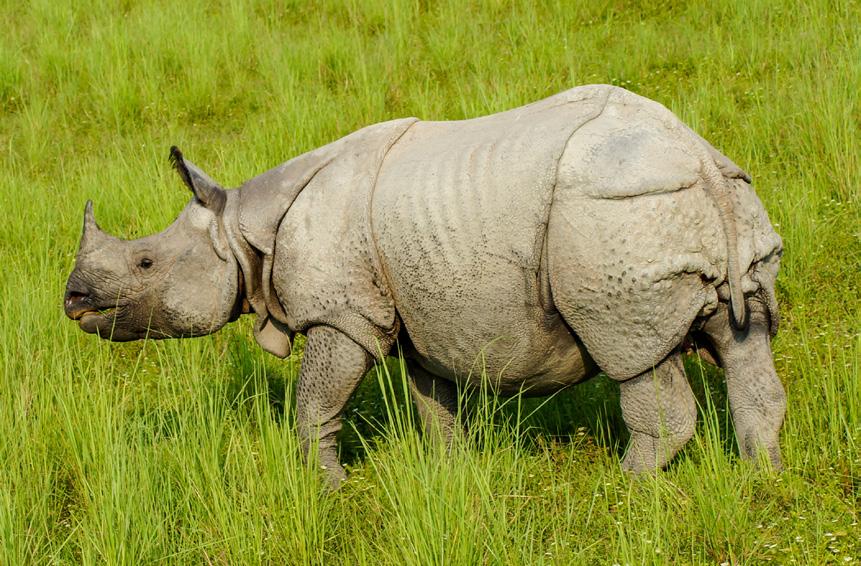
Fossils are spread over an area of 25 hectares. This area is being pitched by the State of UP for inclusion in the list of UNESCO World Heritage Sites.
Rocky landscape of Chandraprabha Wildlife Sanctuary harbors many unique plants that have immense medicinal value. One can experience blackbucks (Antilope cervicapra), Chital (Axis axis), Sambar (Rusa unicolor), nilgai (Boselaphus tragocamelus), wild boar (Sus scrofa), bear (Melursus ursinus), and many other animals in their natural habitat. Evidences of presence of prehistoric humans can be seen in primitive paintings on cave walls. One can also witness the culture of indigenous tribes like Baiga, Gond, and Chero who live within these forests. Numerous waterfalls embellish the landscape. Rajdari and Devdari waterfalls are located inside Chandraprabha Wildlife Sanctuary. Other beautiful waterfalls are Siddhnath Dari, Lakhaniya Dari, Chuna Dari, Mukha Falls, Kushiyara Falls, Tanda Falls, Wyndham Falls and Sirsi Falls. Rajdari

and Devdari are at their best during monsoon months (July to September).
Kaimur Wildlife Sanctuary spreading over parts of Mirzapur and Sonbhadra offers a completely different canvas. Open forests and rocky expanses interspersed with clumps of xerophytic plants and grasses is home to Black Buck (Antilope cervicapra). Herds of these majestic creatures can be seen grazing or crossing the landscapes with their unique gait which is a mesmerizing mix of leaps and trots. The sight of clashing males during their mating ritual is a unique experience. This area is famous for rock paintings of the upper Paleolithic Period or Old Stone Age (from approximately 3.3 million years to 11,700 BC.). Landscapes of Mirzapur, Chandauli and Sonbhadra lying in the Vindhyan Region take on a unique shade of reddish-orange in the months of March and April when dhak (Butea monosperma), also known as “flame of the forest” comes to bloom. Chand Khamaria Black Buck
Conservation Reserve in Prayagraj is a unique example of community driven conservation efforts and should be visited those who intend to visit Prayagraj as tourists or pilgrims.
4. Bundelkhand Region is marked by rocky mineral-rich hills interspersed by tributaries of Yamuna. Vijay Sagar Bird Sanctuary (Mahoba) surrounds the lake built during medieval times. One can enjoy bird watching, nature gazing, and water sports within its vicinity. At Mahavir Swami Wildlife Sanctuary (Lalitpur) wildlife enthusiasts can spectate animals like leopards (Panthera pardus fusca), nilgai (Boselaphus tragocamelus), wild boar (Sus scrofa), sambar (Rusa unicolor), black buck (Antilope cervicapra), endangered vultures and much more. Mauranipur in Jhansi has a vulture colony in caves and cavities in low hills. Ranipur Tiger Reserve (Chitrakoot) is contiguous with the forest of Panna Tiger Reserve and tigers can be s ighted in this Tiger Reserve. →

→ Bundelkhand region is revered among Hindus and Jains and have numerous temples. This area is rich in culture and an important place in India’s history right from medieval times to present day. It is believed that Lord Ram and Sita spent their exile in the forests of Chitrakoot with the important sites being conserved and revered by devotees. Dashavatara Temple in Deogarh (Lalitpur) is the oldest Nagara style temple. Deogarh also boasts of an expansive Jain temple complex consisting of numerous stylistically adorned temples built during the medieval period. Remnants of Chandela and Maratha regional supremacy can be experienced in the forts that abound with green scenes. Kalinjar Fort (Banda) has a long history of political occupancy from ancient times to colonial period. Situated atop the Vindhyan hills, overlooking the Bundelkhand plains this picturesque fort encloses temples and caves. The flagbearer of Bundelkhand’s valor is Rani Laxmi Bai, queen of Jhansi who was martyred at the age of 22 in order to save her kingdom and people from foreign rule.
IN PURSUING
ECOTOURISM AS THE PREFERRED TOURISM MODEL, GOVERNMENT OF UTTAR PRADESH IS COMMITTED TO TAKE ITS DEVELOPMENT TO NEW HEIGHTS AND BALANCE THE TRIPLE BOTTOM LINE VIZ. PEOPLE, PLANET, AND PROSPERITY. UP STATE ECOTOURISM DEVELOPMENT BOARD (UPETDB) IS ENTRUSTED WITH THE MANDATE TO PROMOTE ECOTOURISM IN THE STATE AND TO PROVIDE UNIQUE ECO-EXPERIENCES TO VISITORS.
India has a robust policy and regulatory framework for protecting natural ecosystems, forests, wildlife and indigenous communities. At the same time both Central and State Governments want to promote ecotourism with the objective
to enhance rural livelihood while preserving natural wealth of the and and ensuring that there should not be any negative impact of tourism on natural resources as well as on host communities.
In pursuing ecotourism as the preferred tourism model, Government of Uttar Pradesh is committed to take its development to new heights and balance the triple bottom line viz. people, planet, and prosperity. UP State Ecotourism Development Board (UPETDB) is entrusted with the mandate to promote ecotourism in the State and to provide unique eco-experiences to visitors.
UP has robust world class highways and motorways. Train and air connectivity is good. There are 11 airports in UP out of which 3 are international airports. Further 8 domestic airports are upcoming. UP is the first State in India to start air connectivity to a National Park. Numerous accommodation options starting from starred hotels, to resorts to homestays are available. Luxury travelers to middle income groups,

travelers on shoestring budget and students can find affordable options for travel, stay and food. Further, UPETDB has started nature guide training program with the objective to train youth from host communities to enhance their livelihood opportunities and to provide enhanced nature and wildlife experience to visitors. Capacity building programs for homestay owners are in place for better boarding and lodging experience to travelers.
UPETDB is committed to – create policies that promote sustainable ecotourism that creates jobs and supports local culture and products (SDG target 8.9); and develop tools to monitor the sustainable development impacts of tourism (SDG target 12.b).
Our entire approach to ecotourism focuses on – creating jobs; supporting sustainable agriculture by providing supplies and production to hotels; promoting inclusiveness and empower women; preserving cultural and natural heritage; and reducing inequalities by engaging local populations and stakeholders in ecotourism related activities. ■
Dr. Rupak De is former Principal Chief Conservator of Forests, Uttar Pradesh India having more than 4 decades of experience in managing forests and wildlife in Uttar Pradesh. He headed Tiger National Park, Wildlife Sanctuaries and Lion Safari in Uttar Pradesh Presently he is helping organizations engaged in conservation and management of wildlife in India.
Dr. Rajiv Kumar Garg is former Principal Chief Conservator of Forests, Uttar Pradesh having more than 4 decades of experience in management of forests and wildlife in Uttar Pradesh. As Managing Director, Uttar Pradesh Forest Corporation he is entrusted with the responsibility of promotion of ecotourism in UP. Presently he is Senior Advisor, Tourism with iDeCK and assisting them in promotion of ecotourism in Uttar Pradesh.
Prakhar Misra is Director, Tourism and Additional Director, UP Eco tourism Development Board in Government of Uttar Pradesh. He is entrusted with the responsibility to oversee promotion of ecotourism all over Uttar Pradesh both in and outside forest and wildlife areas. Currently he is promoting ecotourism in partnership with host communities, private entities and government organizations.
Ananya Rai is a graduate from University of Delhi, India. She is a nature lover and wildlife enthusiast. Presently she is working as an intern with Department of Tourism, Government of Uttar Pradesh.
1. Bhabhar is a narrow belt of land in India that runs parallel to the Shiwalik Hills and is known for coarse materials like pebbles, gravel, and rocks
2. Terai is a belt of marshy land in India at the foot of the Himalayas in Northern India
3. Indo-Gangetic Plains (IGP) are one of the main food-producing regions of India. Encompassing the northern part of the Indian subcontinent, IGP region includes the Indian states of Punjab, Haryana, Uttar Pradesh, Bihar and West Bengal.
4. A deciduous forest is a forest where trees lose their leaves annually. These forests are characterized by broad-leaved trees, four seasons, and a temperate climate
5. Recorded forest area is the total geographical area recorded as forests in government records, regardless of the actual trees growing on the land. There can be some area recorded as forest but it might be a wasteland or wetland, similarly there can be forests on private lands and/or community lands which are not recorded as forests but provide same ecological functions.
6. A national park in India is a designated area of land protected by the government, set aside for the conservation of its natural flora and fauna, where human activities are strictly regulated to maintain the ecosystem in its most natural state, allowing for wildlife preservation and limited recreational activities like wildlife viewing and nature exploration.
7. A tiger reserve in India is a protected area that is designated to conserve the Bengal tiger, India’s national animal. A tiger reserve is a part of Project Tiger, an initiative launched in 1973 by the Government of India.
8. A wildlife sanctuary in India is a protected area that is reserved for the conservation of wildlife and their habitats. The purpose of a wildlife sanctuary is to provide safe environment for animals, especially those that are endangered or threatened. Restriction imposed in a wildlife sanctuary are less stringent as compared to national park.
9. A conservation reserve in India is a protected area that is designated to protect the landscape, seascape, flora, fauna, and their habitats.
10. A Ramsar site is a wetland area designated as being of international importance under the Ramsar Convention, an intergovernmental treaty focused on conserving and sustainably using wetlands. It’s a wetland recognized for its significant ecological value on a global scale, and is added to a list of “Wetlands of International Importance” when designated as a Ramsar site.
11. Terai Arc Landscape (TAL) is a 2.47-million-hectare biodiversity hotspot that spans across the Indian states of Uttarakhand, Uttar Pradesh, and Bihar, as well as the low-lying hills of Nepal. It’s made up of 14 protected areas in India and Nepal, and is home to a variety of flora and fauna. It is also home to more than 7.5 million people, and is critical for both human communities and wildlife. TAL is a globally important ecoregion, the Terai-Duar Savanna and Grasslands, which is characterized by savanna grasslands and evergreen and deciduous forest. TAL is extremely productive due to annual monsoon floods that deposit silt across the grasslands. TAL was recently named a World Restoration Flagship by the UN Decade on Ecosystem Restoration. This recognition is given to the best examples of ongoing, large-scale, and long-term ecosystem restoration.
12. A dhurrie is a traditional, flat-woven rug or carpet, typically handwoven, that is considered a staple in Indian households, often used as a floor covering, but can also serve as bedding or packaging due to its versatility and thin nature; it is known for its intricate designs and vibrant colors, often featuring geometric patterns and stripes, and is considered a symbol of Indian craftsmanship.
13. A mahout is a person who trains, rides, and cares for an elephant, essentially acting as an elephant keeper or handler; they are often from communities with generations of experience working with elephants, maintaining a close bond with their assigned animal throughout its working life.

Blended finance is a pivotal link in the climate transition because it can be the switch that incentivizes the private sector to move forward. Blended finance strategically combines public, philanthropic, and private capital to bridge the significant financing gap needed to achieve sustainability in developing countries.
For emerging and developing economies, including the Archipelagic States, the need for sustainable investment is immense— spanning climate mitigation, energy transition, infrastructure, health, and food systems. Yet, public budgets alone cannot meet this demand. A supportive policy ecosystem is needed to encourage private capital flows at scale. The need for a global institution to address the $4.2 trillion annual funding gap toward meeting the financing needs was recognized by the G20 in their 2022 Bali Leader’s Communique. The new international organization, the G20 Bali Global Blended Finance Alliance (GBFA) seeks to fill the funding gap and to implement the G20 Blended Finance Principles. It looks to deploy shared learning, policy innovation, and partnerships, to help developing countries implement practical, country-led solutions for climate and development financing. Within the framework of climate actions, the G20 Bali GBFA is committed to facilitate collaboration of climate -related projects on nature, such as water management, rehabilitation and conservation, sustainable agriculture, and blue carbon initiatives. By utilizing blended finance mechanisms that combine public, private, and philanthropic funding, the G20 Bali GBFA promotes to reduce investment risks in large-scale projects while ensuring local stakeholders acquire the skills needed for long-term sustainability. This dual approach strengthens institutional capacity and delivers tangible climate action.
The facilitation of country-led platforms
Too few developing countries have platforms that integrate development and climate strategies to guide public-private investment. The G20 Bali GBFA helps countries create these platforms, enabling them to identify priority investments, shape coherent policies, and map financing needs and gaps.
capacity building for climate
No single actor can drive systemic change alone. Governments, civil society, private investors, and philanthropic actors must collaborate. The G20 Bali GBFA invests in capacity-building to help institutions design, manage, and deliver complex finance solutions in line with climate and development targets.
The formation of partnerships.
The G20 Bali GBFA will scale and replicate proven blended finance tools, reduce transaction costs, and unlock finance for net-zero transitions, nature-positive solutions, and blue economy initiatives. It will also foster knowledge-sharing among governments, private partners, and philanthropic institutions to accelerate learning and innovation.
The G20 Bali GBFA places South-South cooperation at the heart of its mission recognizing the unique challenges faced by developing countries and Archipelagic Island States. By fostering collaboration among developing countries, it aims to co-create and scale locally owned, culturally aligned solutions to global problems.
In 2024, Kenya and Fiji formalized their commitment by signing the G20 Bali GBFA Articles of Agreement with host country Indonesia.
Country members and knowledge partnerships are key to the G20 Bali Global Blended Finance Alliance initiatives to scale blended finance transactions for climate action
and the SDGs at country-level. Knowledge partners —including the United In Diversity Tri Hita Karana Forum, OECD, UNDP, AVPN, and Tony Blair Institute — play a crucial role in the G20 Bali GBFA ecosystem by providing outreach, expertise, research, and technical assistance.
The G20 Bali GBFA is poised to become a transformative global force—delivering scalable, replicable models of blended finance while deepening multilateral cooperation. As global economic uncertainty and geopolitical tensions rise, the new organization embodies a hopeful path forward: one where countries unite around shared goals as well as practical and innovative solutions.
Join the Movement.
The G20 Bali Global Blended Finance Alliance invites governments, development institutions, investors, and civil society organizations to join its mission to co-create a sustainable and inclusive future. ■
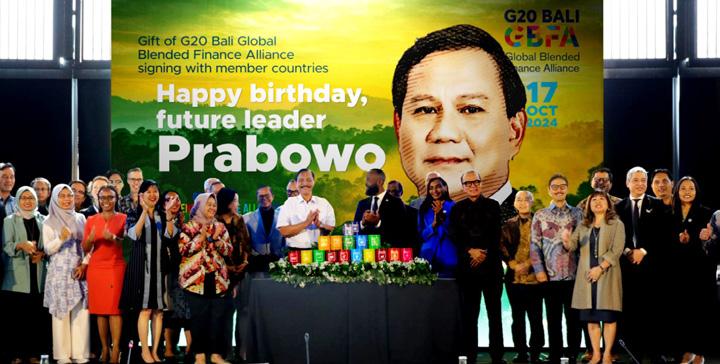
To explore opportunities for engagement with the G20 Bali Global Blended Finance Alliance, please contact info@g20baligbfa.org


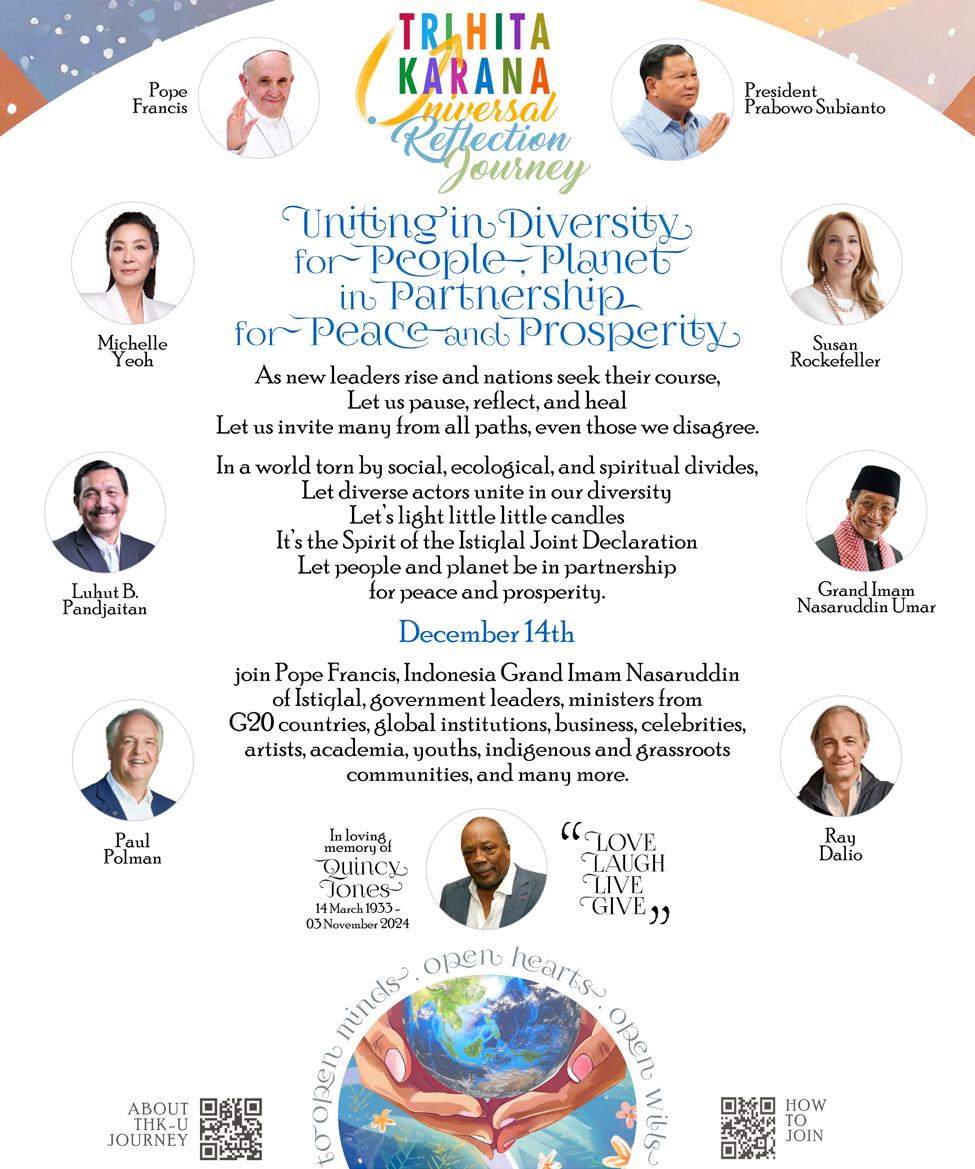
On December 14, 2024 – a sacred day in the Balinese Calendar on the shore of Kura Kura Bali Special Economic Zone – tens of thousands of diverse people around the world – governments, global institutions, business, celebrities, artists, academia, youths, indigenous and grassroots communities – joined the Tri Hita Karana Universal Reflection Journey (THK U) to unite in diversity for world peace and prosperity.
Born out of the late Pope Francis’s visit to Indonesia and the region earlier in the year, and the joint Istiqlal Declaration with Indonesia’s Grand Imam Nasaruddin for a Universal day of reflection for world’s peace and prosperity, the THK U global ‘un-movement’ invited many from all paths to pause, reflect, and heal, and to seek harmonies for people, planet in partnership for peace and prosperity in a world that is torn by social, ecological and spiritual divide.
Co-hosted with the government of Indonesia and Tri Hita Karana Forum global partners, the global initiative saw Academy Award winner Michelle Yeoh, Megawati Sukarnoputri former President of Indonesia, World Bank President Ajay Banga, IMF Managing Director Kristalina Georgieva, Bridgewater Associate Founder Ray Dalio, New Age Guru Deepak Chopra, Paul Polman, Susan Rockefeller and many others from across the trisectors to light the candles of hope and unity towards the UN Sustainable Development Goals (SDGs) and the Balinese Tri Hita Karana’s three ways to happiness with the harmonies of people with people, nature and the divine.

As thousands of candles were lit, the Balinese Dance of Peace unveiled a 17x35-meter cloth emblazoned with SDG 16 for “Peace, Justice, and Strong Institutions” to reinforce the call for peace and harmony.

Nasaruddin Umar Presidential Special Envoy International Trade and Multilateral Cooperation, H.E. Mari E. Pangestu et al to the little candles lighting upthe hope for peace and harmony

President
initiative.
Ajay Banga, President of the World Bank Group, and Kristalina Georgieva, Managing Director of the International Monetary Fund conveyed words of shared purpose. Their emphasis is on global cooperation and collaboration to achieve lasting solutions to build a world that is both sustainable as well as fair and inclusive for all. Participants were invited to transform from ego-centric thinking
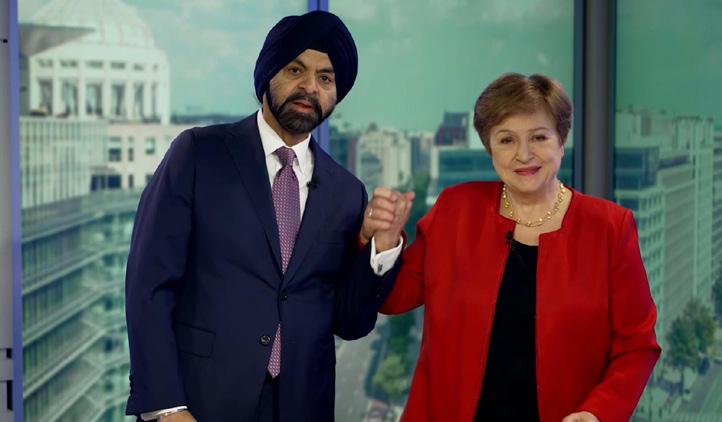

to eco-centric solutions, foster cross-sector collaborations to address critical issues such as climate change, social inequality, and global peace, as well as setting the intention with open minds, open hearts and open wills to advance the SDGs and the new global institution the G20 Bali Global Blended Finance Alliance. The G20 Bali Global Blended Finance Alliance is acknowledged in the G20 Bali Leaders Declaration as a global alliance needed to solve the funding gap for the climate and other SDGs for the developing countries. The gathering served as a call for the new global organization to harness the collective will and resources of nations to combat poverty, heal our planet, and ensure prosperity for all. ■
For more information on Tri Hita Karana Universal Reflection Journey, please login https://sdgpyramid.org/thku-2024/
Pope Francis’ final international visit to Indonesia, Singapore and Oceania and global engagements carried profound significance. A region embodying unity in diversity. Beyond the visible, a deeper synchronicity emerges between his foundation, Scholas Occurrentes, and “United in Diversity” movement in Asia Pacific - a divine alignment bridging faiths, cultures, and generations.
THE GLOBAL HAPPINESS
PYRAMID AND TRI HITA KARANA
A lifelong advocate of the 17 Sustainable Development Goals (SDGs), Pope Francis found resonance in Bali’s Tri Hita Karana Philosophy - Three Ways to Happiness: Harmony among People; Harmony of us with nature; and Harmony with the Divine.

This ancient Balinese wisdom is aligned with the Laudato Si encyclical as well as teachings across Islam, Hinduism, Chinese, Greek and Christianity. The miracle? A perfect chronological alignment of these values into a Happiness Pyramid, uniting humanities shared aspirations

In recent years, Pope Francis dispatched his trusted envoys—Bishop Auriel, Jose Maria del Corral, Father Marcin, and Scholas youth leaders—to Indonesia, supporting initiatives like the G20, Tri Hita Karana Forum, and World Water Forum.
The Dove of Pentecost: On the eve of Pentecost Sunday, coinciding with Tumpek Kandeng (Balinese sacred day for animals) and preceding Waisak Day (most sacred day in Buddhism), a dove descended upon a lady during the 10th World Water Forum Blessing Ceremony in Bali—graced by thousands. The following days, the G20 Bali Global Blended Finance Alliance was signed, marking a historic step toward SDG financing.

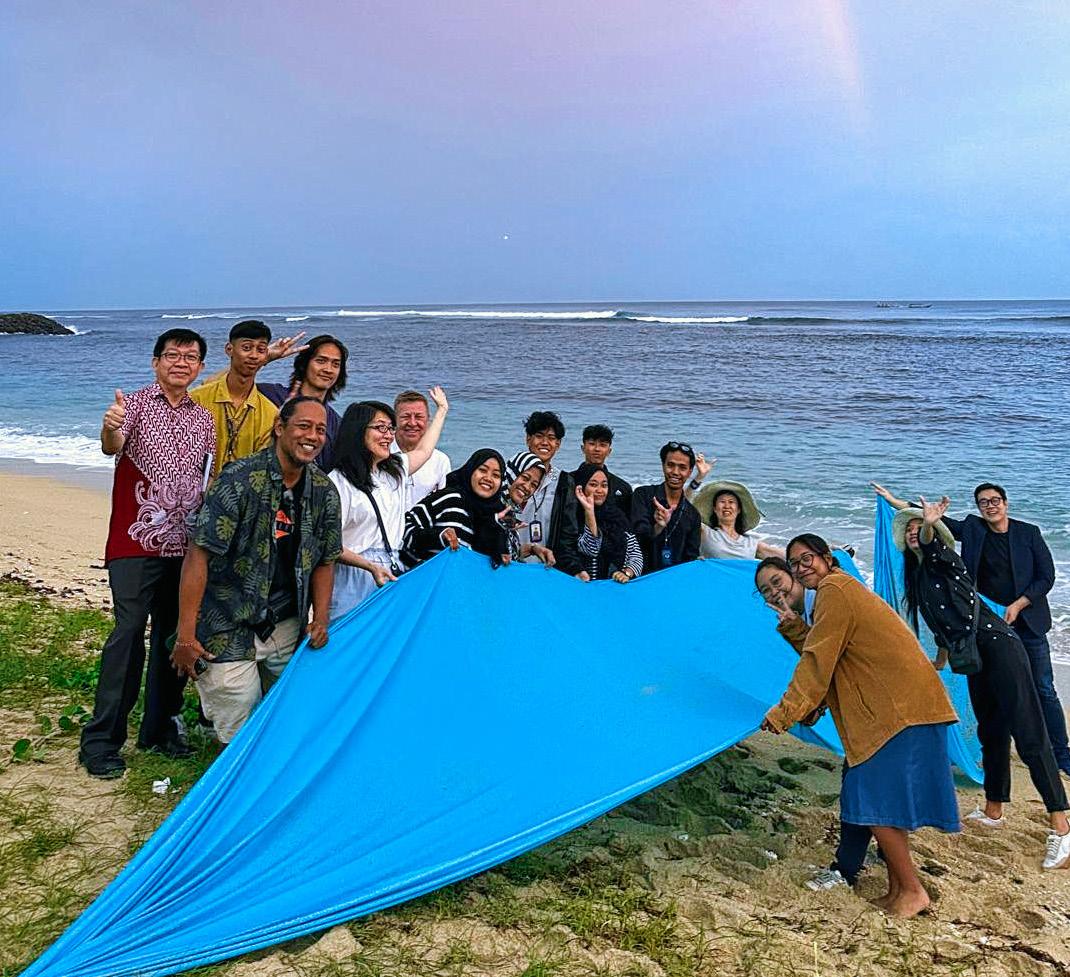
of Peace” dance

Papal Mangroves: For the first time, mangrove saplings blessed by the Pope for the 2024 Indonesia Sustainability Forum were planted across Indonesia, symbolizing his love for peace and nature. These saplings now thrive near the UAE-Indonesia International Mangrove Research Center, a testament to interfaith ecological unity.
THE TUNNEL OF FRIENDSHIP AND THE “INVISIBLE ROOTS” OF FAITH
In Jakarta, Pope Francis traversed the Tunnel of Friendship opened by Indonesia President Prabowo Subianto, linking the Istiqlal Mosque (largest in Southeast Asia) and the Jakarta Cathedral. There, with Grand Imam Nassarudin, they signed the Istiqlal Declaration, rejecting religious violence and environmental indifference.

Francis kisses the hand of the Grand Imam of the Istiqlal Mosque, Minister of Religious Affairs of Indonesia, Nasaruddin Umar, during a visit to the Istiqlal Mosque, Thursday, September 5, 2024.


“Hati Indonesia”—an art installation cocreated by Scholas, youths and marginalized communities. Inside, a tapestry of 1000 dreams, prayers, and children’s drawings weaves a vision of unity. Pope Francis drew a heart inscribing: “Fraternity: Amity, Tenderness, Service.”Hati now sits inside the Three Mountains Pavilion—the world’s tallest bamboo structure—at the Kura Kura Bali Special Economic Zone, honoring Bali’s sacred peaks and signifying Open Mind, Open Heart, Open Will.

Here, miracles unfolded: Pink Halos and Circular Rainbows appeared before the Bali Kerthi Roadmap Launch. A recycled copper cross, blessed by the Pope and engraved with *Laudato Si’, was gifted to bridge social, ecological and spiritual divides.


THE RAINBOW OVER GEMILI HOSPITAL: A SIGN OF HOPE
On February 24, 2025, as Indonesia joined many to pray for the Pope’s health, a rainbow similar to THK U encircled Gemili Hospital.
On Good Friday, Scholas youths gathered at Hati Indonesia, echoing his mission on inner path to search for greater joy nurturing the social field. This is aligned with the United in Diversity campus work with Otto Scharmer and Peter Senge.
Pope Francis waited for a day of Easter’s renewal, after Eid al-Fitr (most significant Islamic celebration), on Kartini’s women day of courage, on the cusp of Bali Galungan’s balance, and Waisak that converge for a shared humanity and peace.
At Hati Indonesia on Sunday following the funeral in Rome, doves landing on Hati and hundreds of swallows swarmed the Three Mountains Pavilion nearby his blessed mangrove, to the gasp and wonder of attendees at the interfaith memorial for Pope Francis.
The miracle lives on—Hear our hearts, beating gently, your tender prayers for us, Heart to Heart (Hati to Hati), ah yes you are with God. ■
His words moved millions: “.. what lies ‘underneath’, what runs underground, like this ‘tunnel of friendship’ is the one root common to all religious sensitivities .. the thirst of the infinite that the Almighty has put in our hearts, the search for a greater joy and a life stronger than any kind of death .. step out of ourselves to encounter God”.
Pope Francis at Tunnel of Friendship



CLIMATE CHANGE STANDS AS ONE OF THE MOST PRESSING CHALLENGES HUMANITY FACES TODAY. THE YEAR 2023 AND THE FIRST HALF OF 2024 SAW NUMEROUS RECORD-BREAKING TEMPERATURES AND EXTREME WEATHER EVENTS WORLDWIDE. JANUARY 2024 MARKED THE HOTTEST JANUARY ON RECORD, WITH AN AVERAGE SEA SURFACE TEMPERATURE OF 20.97°C, SURPASSING THE PREVIOUS RECORD SET IN 2016.
These disruptions to nature directly impact our environment, ecosystems, human lives, and production processes, etc., ultimately affecting global development and security. Addressing climate change has thus become an urgent imperative for every nation and its people. and dedication, AkzoNobel team has relentlessly pushed boundaries to create new, high-quality, aesthetically pleasing, safe, and more sustainable surface solutions. In 2023, AkzoNobel embarked on comprehensive improvements and
innovations driven by a shared ambition: to paint the future and collaboratively build a vibrant, colorful, and more sustainable world for future generations.
As a reputable global provider of surface products and solutions, AkzoNobel’s product range spans various economic sectors, including industry, production, services, and residential use. AkzoNobel’s innovations significantly influence industry
transformations and the lives of customers, as demonstrated by the following achievements:
In the Beverage Industry: AkzoNobel introduced Aqualure G1 50 and Accelstyle, the new generation of coatings technology compliant with FDA and EU regulations, enabling beverage can manufacturers to offer products with surfaces free from bisphenols, styrene, and PFAS. The new products allow manufacturers to switch to coatings that do not contain harmful substances, while maintaining commercial viability.
Additionally, AkzoNobel’s bisphenolfree products reduce carbon emissions by up to 26% compared to previous epoxy-based products. It means, with Accelstyle, AkzoNobel achieves the dual goals of protecting users and minimizing environmental impact.
In the Transportation Sector: In aviation, AkzoNobel developed new paint for Brazilian manufacturer Embraer’s Profit Hunter E195-E2 aircraft, called Tech Eagle, unveiled at the 2023 Dubai Airshow. AkzoNobel’s color experts provided the ideal paint palette aligned with Embraer’s vision. The skilled team at MAAS then completed the aircraft painting in 15 days, turning the idea into reality.
On the ground, AkzoNobel became the first supplier of bio-based interior coatings for KIA Motors. The interior paint for EV9 the new electric SUV, using bio-rosin (rosin is a solid form of resin) one extracted from rapeseed and the other from pine rosin, meets all color and functional requirements, including UV protection, air cooling, temperature regulation, and scratch resistance.
Pursuing a philosophy of perfect surfaces that are not only beautiful but also meet quality, impact, efficiency, and sustainability criteria, AkzoNobel sets high expectations for its R&D team. This team is tasked with delivering digital solutions that streamline processes and increase profitability, helping auto repair shops work smarter and more sustainably. Refinish+ is one of the outcomes of this effort. This is a comprehensive set of solutions from Sikkens Vehicle Refinishes for repairing the entire paint layer on vehicles, from restoring the original color, reducing drying time and volatile organic compounds (VOC) emissions, to lowering carbon emissions on the vehicle body, etc.
In the Powder Coatings Industry: AkzoNobel’s approach to sustainable development is guided by the principle of reducing consumption and increasing durability. AkzoNobel pioneered the introduction of Interpon D1036 Low-E, a product that can cure at temperatures as low as 150°C, 25% faster than conventional powder coatings, thereby reducing energy consumption by 20% during production. Especially, products using Interpon D approved coating techniques can be warranted for up to 30 years for exterior architectural applications, supporting sustainable construction trends, cost savings,

ON THE GROUND, AKZONOBEL BECAME THE FIRST SUPPLIER OF BIO-BASED INTERIOR COATINGS FOR KIA MOTORS. THE INTERIOR PAINT FOR EV9 THE NEW ELECTRIC SUV, USING BIO-ROSIN (ROSIN IS A SOLID FORM OF RESIN) ONE EXTRACTED FROM RAPESEED AND THE OTHER FROM PINE ROSIN, MEETS ALL COLOR AND FUNCTIONAL REQUIREMENTS, INCLUDING UV PROTECTION, AIR COOLING, TEMPERATURE REGULATION, AND SCRATCH RESISTANCE.
and resource conservation.
Similarly, in the Decorative Paint Sector, real-world tests have shown that AkzoNobel’s Dulux Professional Weathershield Express improves application productivity by 30% compared to traditional three-coat systems, saves 20% of time, and reduces material consumption by 15%. In this sector closely linked to daily life, AkzoNobel has successfully applied bio-based PureAir technology to improve indoor air quality and KeepCool Technology™ to reduce building surface temperatures by up to 5°C.
Hearts turned to the community
Beyond my passion for creating surface solutions and adding color to life, thousands of AkzoNobel employees worldwide share a big dream: to join
hands in building a better world.
For nearly a decade, AkzoNobel has partnered with SOS Children’s Villages in numerous social programs. The “Let’s Colour” initiative aims to reduce youth unemployment through soft skills education, vocational training, and innovation, and has been successfully implemented in countries like Argentina, Belgium, China, Brazil, Nigeria, South Africa, Pakistan, and Indonesia, so on. Besides job and entrepreneurship training, the program focuses on character and capability development. For example, in Banda Aceh and Meulaboh, Aceh Province, Indonesia, young people are trained to make furniture from wood and iron or learn about constructing nursery structures. YouthCan! Initiative, another SOS Children’s Village activity in which AkzoNobel participates, reaches out →

→ to orphans, providing them with the best language skills to communicate with the world, opening up new job opportunities.
In India alone, over 3,500 underprivileged youth have been trained at AkzoNobel India’s Paint Academy, and this number continues to grow as training activities expand worldwide. Notably, these community contributions, regardless of time or place, always receive enthusiastic support from passionate hearts. I am deeply moved by the images of Indian AkzoNobel employees painting community halls and family homes at SOS Children’s Village Greenfield in Faridabad. Similarly, in Indonesia, AkzoNobel employees joined hands to renovate foster homes and kindergartens at SOS Children’s Village in Jakarta. These foster homes received vibrant, inspiring murals, creating a friendly space for children to grow and create. Dulux EasyClean Anti-Virus was used to ensure the projects were more sustainable and provided a safe, healthy environment for the children. Once again, a dual goal achieved by AkzoNobel!
Renovating community projects has become a hallmark of AkzoNobel’s social efforts. In Vietnam, repainting historically significant local lighthouses like Dai Lanh, Vung Tau, and Cu Lao Xanh, has been well-received by local residents and the young Vietnamese community. The short film ‘Eyes of the Sea,’ integrating the refurbishment of Dai Lanh Lighthouse into a heartwarming family story, garnered over 13 million views, linking Dulux Weathershield with the image of lighthouse guardians in this tropical country. The message of joining hands to protect lighthouses was also spread to young Vietnamese.
As mentioned, responding to global climate change is an urgent priority, compelling AkzoNobel and other businesses to take resolute action. In alignment with the Paris Agreement, AkzoNobel is actively striving toward sustainable value indicators, which include: reducing carbon emissions by 50% in its operations, cutting carbon emissions by 50% across the entire
value chain, and achieving 100% circular material usage in operations through reduction, reuse, and recycling. AkzoNobel also aims for 50% of its revenue to come from more sustainable solutions.
AkzoNobel continues to develop radical solutions to combat climate change. One such innovation is KeepCool Technology, which uses special pigments to reflect infrared heat, keeping exterior walls up to 5°C cooler in the Dulux Weathershield product line. To reduce solvent emissions, AkzoNobel is converting specialty wood coatings and decorative paints to water-based technology, targeting over half of its production. Additionally, in the furniture sector, AkzoNobel is implementing circular solutions by increasing the use of renewable materials in inishing products.
It’s important to note that climate change and sustainable development must be collective efforts, not the responsibility of a single business or country. This common goal requires strong collaboration among businesses, organizations, and governments.
AKZONOBEL CONTINUES TO DEVELOP RADICAL SOLUTIONS TO COMBAT CLIMATE CHANGE. ONE SUCH INNOVATION IS KEEPCOOL TECHNOLOGY, WHICH USES SPECIAL PIGMENTS TO REFLECT INFRARED HEAT, KEEPING EXTERIOR WALLS UP TO 5°C COOLER IN THE DULUX WEATHERSHIELD PRODUCT LINE.
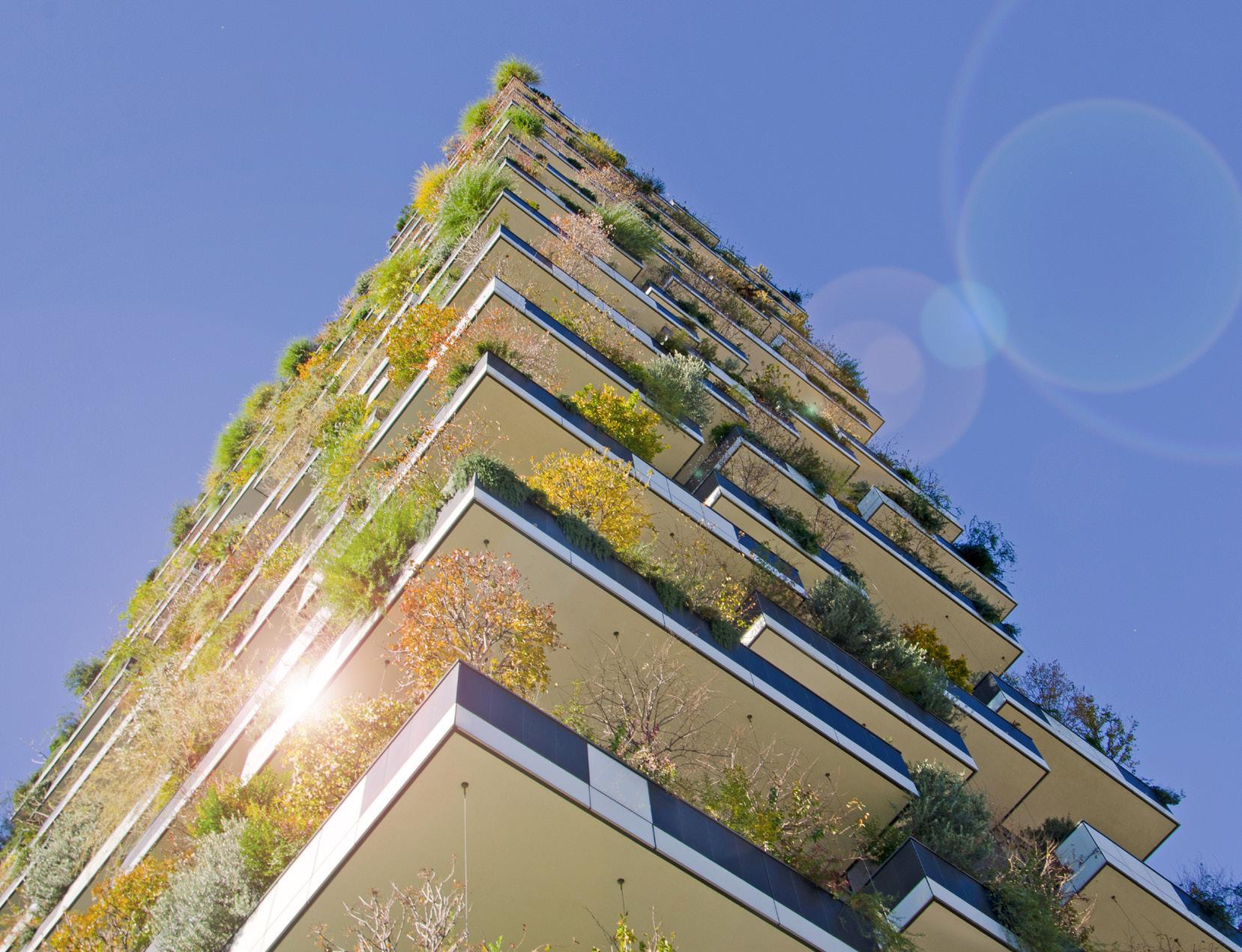
Focusing on green transformation, carbon reduction, innovation, and cooperation, AkzoNobel gathers resources from partners across the value chain to address main challenges. AkzoNobel continues to work with ecosystem partners on research and transformation activities.
Thanks to these combined efforts, AkzoNobel has achieved impressive results. By 2023, compared to 2018, AkzoNobel’s absolute energy consumption in operations decreased by 4%, and relative energy consumption decreased by 7%. Furthermore, all production sites in North America, Europe, and Latin America now operate with 100% renewable electricity, marking a significant milestone following a 48% reduction in waste to landfill versus the 2018 baseline. These achievements are not the final destination. Responding to climate change is only part of the overall sustainable development goal. The circular economy presents more opportunities, despite significant challenges. By adopting this economic model early, AkzoNobel has achieved
notable circular solutions, such as a unique two-layer coating method that reduces material usage and improves labor productivity while maintaining superior performance similar to the conventional three-layer coating method. This material reduction goal is further supported by Sprayvision, a data technology that adjusts materials according to surface needs. This data-driven coating technology helps customers save time, ensure perfect coverage, and reduce waste.
AkzoNobel is also using renewable materials as bio-based binders in decorative paints and producing recycled paints from waste materials. These circular paint lines have been launched in some European countries under the Sikkens and Dulux brands. Despite certain cost challenges, AkzoNobel’s circular, more sustainable solutions genuinely enhance user health and happiness. The bio-based paint line protects walls from harmful pollutants, providing cleaner indoor air and fresher homes. AkzoNobel’s wood coating line ensures that high moisture MDF wood interiors and exteriors eliminate
harmful volatile compounds.
Since its foundation in 1792, AkzoNobel has positioned itself as a brand that brings color to spaces, protecting vital values in life: family bonds, creativity, social development, and community cohesion, so on. AkzoNobel’s mark can be found in projects deep underground, in homes, cities, transportation means, and even spacecraft. Each layer of paint tells a story, just as each person is a marvel of creation. AkzoNobel believes that opening up a world full of potential is built on the most basic foundation everyone has access to: the colors of life. As Zen masters often advise us living mindfully, recognizing, capturing, and cherishing the most beautiful moments around us in the present is the key to opening up a bright future.
AkzoNobel’s future path will be guided by the purpose “Paint the Future”.
“Paint the Future” is not only the purpose for AkzoNobel but also a call to action. The world is striving to accelerate the transition to a better economy. In a constantly moving world, sustainable development requires →
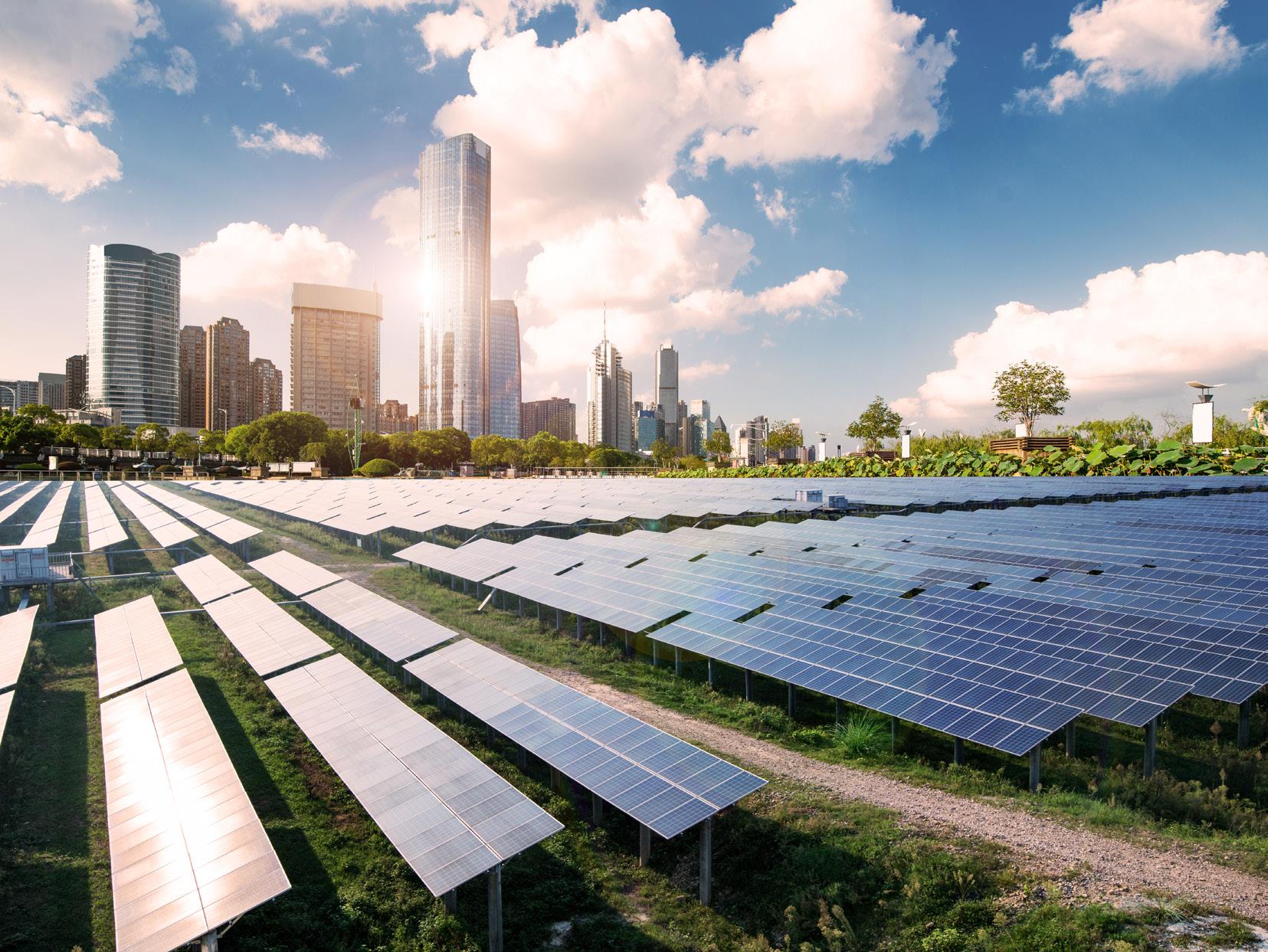
→ building an innovation ecosystem. Collaboration, connection, and positive inspiration to explore new limits are the springboards that elevate human imagination and skill to new heights.

About Akzonobel
I believe this connection, not just between businesses but also at local, national, and regional levels, is essential. Only then can we collectively achieve climate goals and meet basic human needs—all for the benefit of tomorrow’s world.
“Paint the Future” will be the foundation and motivation for AkzoNobel to surpass all limits. AkzoNobel’s innovative activities will be built on three main pillars, also the identity it has established over time: Innovation, Sustainability, and People. Imagine a day where you greet the morning not with plans to complete routine tasks, but with dreams of a better world where each of us is a colorful piece in the mosaic of that bright future. Your day would be much more wonderful, wouldn’t it? ■
We supply the sustainable and innovative paints and coatings that our customers, communities –and the environment – are increasingly relying on. That’s why everything we do starts with People. Planet. Paint. Our world class portfolio of brands – including Dulux, International, Sikkens and Interpon – is trusted by customers around the globe. We are active in more than 150 countries and have set our sights on becoming the global industry leader. It’s what you’d expect from a pioneering paints company that’s committed to science-based targets and is taking genuine action to address globally relevant challenges and protect future generations.
For more information, please visit www.akzonobel.com

Global Product Management Director AkzoNobel
President & Technical Chairperson, Singapore Paint Industry Association
Chairperson, National Technical Committee for Surface Coating, Chemical Standards Council of Singapore
Pamela Phua is the Global Product Management Director for AkzoNobel, covering both Paints and Coating businesses. Prior to the current appointment, Pamela was the Commercial Managing Director for Vietnam and cluster of key emerging markets including Singapore Cambodia, Laos & Myanmar.
In her stint of career with AkzoNobel, Pamela was also the R&D Director for Asia Pacific & Global Director of Exterior Wall Paint research group who has led and pioneered breakthrough paint innovations & product inventions across well-known household & trade brands including Dulux Weathershield / Powerflexx, Dulux Pentalite, Dulux Wash & Wear / EasyClean, Dulux Inspire/ Catylac by Dulux, Aquatech and many others.
Pamela is currently the President and Technical Chairperson for the Singapore Paint Industry Association and Vice President for Asia Coating & Ink Federation. Pamela also heads National Techncial Committee for Surface Coating, under the Chemical Standards Council of Singapore which contributed to the development of various well-known and trusted Singapore Standards for the paint & coating industry:
• SS678 (Specification for Solar Reflective Waterbased Coating)
• SS685 (Specification for Wtaerbased Primer for Wood & Metal)
• SS686 (Specification for Waterbased Enamel Paint)
• SS345 (Specification for emulsion paints for decorative paints)
• SS500 (Specification for elastomeric wall coatings)
• SS150 (Specification for Emulsion Paints for Decorative purposes)
• SS 579 (Specification for water- based sealer for interior and exterior uses) and many others
Pamela is also an author for the G7&G20 summit publication advocating green developments and a keynote speaker in United Nation Climate Change Conference. Furthermore, latest being the COP29 in Baku Azerbaijan during November 2024.
Email: Pamela.phua@akzonobel.com Mobile: +65 90279663
Address: AkzoNobel House, 3 Changi Business Park Vista, #05-01 SDingapore 486051
Whether you’re seeking quality time with loved ones, or simply craving that feeling of the sand beneath your feet, our team are waiting to welcome you to our island homes. With five luxury resorts in Maldives and a beautiful beach retreat on the east coast of Sri Lanka, we’ll make sure that your dream vacation is well worth the wait.
sunsiyam.com

Sun Siyam Iru Fushi Maldives
Sun Siyam Olhuveli Maldives
Sun Siyam Vilu Reef Maldives
Sun Siyam Iru Veli Maldives
Sun Siyam Pasikudah Sri Lanka
Siyam World, Maldives
AUTHOR: Simon Tribelhorn CEO, Liechtenstein Bankers Association (LBA)

The word ‘sustainability’ may be overused or have become a buzzword and climate change may have disappeared from the headlines. In the long term, the WEF Global Risk Report rightly sees climate change as one of the greatest challenges facing humanity. Events such as the flood of the century in Valencia or the devastating bushfires in Los Angeles cannot, with the best will in the world, be dismissed as mere weather phenomena. Experts have long warned against underestimating such extreme events. Significantly more investment is needed in the short-term prevention of such disasters. At the same time, we must not leave the path towards ‘net zero’. This is the only way to ensure that such events no longer occur so frequently in the distant future. In both cases, the solution requires increased international cooperation. However, the current trend towards fragmentation of the global community is making this path more difficult. Multilateral institutions are being weakened and national, short-term interests are taking centre stage.
The fight against climate change is a monumental challenge that affects everyone, and finding solutions is essential. Yet, there is no consensus on the right approach. On one side, there are staunch defenders of market forces, while on the other, advocates for strict regulations dominate the debate. The reality is that no single measure will be sufficient; what’s needed is a multifaceted approach. The goal is clear: we must transform the global economy in a way that is efficient, swift, and inclusive.
Developing countries—those with historically weaker political systems and less diversified economies—are in particular need of support to foster sustainable development. These nations must be part of the transformation towards greater energy efficiency and climate resilience if we are to seriously tackle climate change. However, they often lack the necessary financial resources to initiate this transformation. This is where blended finance can play a pivotal role. By combining public and private funds, blended finance creates
a path to fund sustainable development projects. There are three key reasons why this approach is both necessary and effective.
Developing countries often contribute the least to global carbon emissions but suffer the most from the devastating consequences of climate change. Rising sea levels, extreme weather events, and resource scarcity are hitting these regions the hardest. Blended finance offers a way to help those most affected by climate change, ensuring that financial support is directed where it is most needed. It is a matter of global justice that the countries bearing the brunt of climate impacts should receive help in building climate resilience and adapting their economies.
One of the major advantages of blended finance is its ability to mobilise private capital by using public funds as a catalyst. Public sector involvement can help mitigate risks, making
investments that were previously deemed too risky attractive to private investors. This risk-sharing mechanism allows for the development of projects in regions where investment opportunities were previously limited, unlocking critical funds for sustainable initiatives. At the same time, public institutions gain a greater leverage effect, increasing their overall impact.
Many developing countries face significant challenges in accessing international capital markets. Limited creditworthiness and unstable political environments often prevent them from securing the funding necessary for large-scale infrastructure or development projects. Blended finance offers a solution by bridging the gap between these nations and the capital they need. By pooling public and private resources, projects in these regions become financially viable, paving the way for transformative change.
The question we must ask ourselves is: Can we afford not to invest in the Global South? The consequences of neglecting this vital region of the world could be disastrous—not only for those living in these countries but for the entire global economy and the planet as a whole. If developing countries are left behind in the transition to a lowcarbon, climate-resilient economy, the repercussions will ripple far beyond their borders.
The Global South is home to some of the world’s fastest-growing populations and most vulnerable ecosystems. Without adequate investment in sustainable development, these regions risk falling further into poverty, suffering from more frequent and severe climate disasters, and contributing to global instability. Failing to act could lead to a vicious cycle of environmental degradation, mass displacement, and economic hardship, which could destabilise both local and international markets. In a globally interconnected world, the impacts of climate change and underdevelopment

WITHOUT ADEQUATE INVESTMENT IN SUSTAINABLE DEVELOPMENT, THESE REGIONS RISK FALLING FURTHER INTO POVERTY, SUFFERING FROM MORE FREQUENT AND SEVERE CLIMATE DISASTERS, AND CONTRIBUTING TO GLOBAL INSTABILITY.
in one region will inevitably affect others, including wealthier nations. From a purely economic perspective, the costs of inaction could far outweigh the costs of investing in sustainable solutions now. As climate risks increase, so too will the financial burden of responding to disasters, rebuilding infrastructure, and addressing the social and economic fallout. By proactively investing in the Global South today, we can prevent these future crises, create new market opportunities, and foster global stability.
Despite its advantages, scaling blended finance comes with its own set of challenges. Lack of expertise in structuring such projects and fears in some developing countries that traditional development aid will be reduced are common concerns. The biggest obstacle, however, is the shortage of well-prepared projects.
So, what can be done? A shift in project planning is needed—one that strikes a better balance between investors’ desire for scalability and returns, and the realities on the ground. Execution risks must be managed carefully, and the focus should be on pragmatic solutions rather than theoretical perfection. In other words, done is better than perfect. For this to happen, we must break away from the siloed thinking that often dominates the investment landscape. Greater collaboration between different investor groups, project developers, and local authorities is crucial. →

→ This is not just about climate change—it applies to financing all 17 of the UN’s Sustainable Development Goals (SDGs). Whether it is clean water, poverty alleviation, or education, blended finance has the potential to create meaningful impact across a wide range of sectors.
The Role of Liechtenstein
Liechtenstein, as international financial centre with a strong track record in development aid and expertise in philanthropic finance, are uniquely positioned to lead the way in blended finance. Both countries have the infrastructure and know-how to significantly contribute to the funding of sustainable development projects, particularly in developing countries. Its role in blended finance allows to make an outsized impact, all while offering competitive, market-based returns for investors and clients.
Blended finance represents a powerful tool in the global fight against climate change and in achieving the broader SDGs. By combining the strengths of public and private sectors, it enables
the kind of large-scale investments needed to build a sustainable future.
Liechtenstein is well-placed to drive this effort, ensuring that the global transition to a low-carbon, resilient economy is not only possible but inclusive, equitable, and just.
In conclusion, the need for innovative financial solutions like blended finance has never been more urgent. The complex nature of climate change demands multifaceted responses, and blended finance provides a pathway that addresses the challenge of financing
sustainable projects in regions that need it the most. It is a critical tool in the broader strategy to combat climate change and support the achievement of the Sustainable Development Goals, offering a fairer, more effective way to allocate resources and share risks. Now is the time for financial institutions, governments, and private investors to come together and make this a reality. The future depends on it. The question is not whether we can afford to invest in the Global South, but whether we can afford not to. ■
About Liechtenstein Bankers Association (LBA)
The Liechtenstein Bankers Association (LBA) was founded in 1969 and represents the voice of Liechtenstein banks both nationally and internationally. As one of the most significant associations in the country, it plays a crucial role in the ongoing development of the financial centre. The LBA is an active participant in European legislative processes, being a member of important organisations such as the European Banking Federation (EBF), the European Payments Council (EPC), and the European Parliamentary Financial Services Forum (EPFSF). Since 2017, the LBA has also been part of the Public Affairs Council (PAC) with offices in Washington and Brussels, and since 2018, it has been a member of the international network “Financial Centres for Sustainability” (FC4S).
With the Roadmap2025, the LBA has placed even greater emphasis on two critical areas: sustainability and digitalisation. Sustainability remains a key pillar of the strategy, with digitalisation acting as a major enabler of this transformation. Reflecting this focus, in 2021, the LBA became an official supporter of the UN Principles for Responsible Banking and the Net-Zero Banking Alliance, further demonstrating its commitment to sustainable and responsible banking.





































BY

Chris Atkins: Sepideh, as we gather here on the eve of yet another global climate summit, the air is thick with declarations and pledges. But let me begin with a simple question: why are we still talking about the credibility crisis in carbon markets?
Sepideh Widmer: Because Chris, credibility is the currency of transformation, and right now, it’s undervalued. We’ve built a $2 billion voluntary carbon market on good intentions but flimsy data. Article 6 of the Paris Agreement—if implemented with integrity—offers a historic chance to realign capital with climate outcomes. But we need trust, traceability, and technology. That’s where platforms like the Spera Impact ecosystem come in.
CA: Spera Impact, you say. Let’s unpack that. What makes this ecosystem more than just another sustainability app with pretty satellite maps?
SW: Spera Impact is not an app; it’s an infrastructure, a full ecosystem if you want. It’s a full-stack platform that integrates blockchain, AI-driven monitoring, on-ground sensors, and community governance through a Decentralized Autonomous Organization, or DAO. It tracks the journey of a carbon credit from seed to retirement. More importantly, it bakes equity, biodiversity, and resilience into the DNA of each project. It creates a digital audit trail that aligns with the UN’s Enhanced Transparency Framework (ETF), making it compatible for both voluntary and compliance carbon markets. It’s the only way forward for climate finance.
CA: Let’s bring this into the realpolitik of Article 6.2 and 6.4—those elusive clauses about cooperative mechanisms and international transfers. How does Spera Impact fit in?
SW: Precisely by design. Spera Impact’s architecture is aligned with the Enhanced Transparency Framework of the UNFCCC. It enables host countries to generate ITMOs—Internationally Transferred Mitigation Outcomes— that are credible, traceable, and fully auditable. Countries like Norway, Switzerland, Singapore, Saudi Arabia, UAE and Japan are actively looking for ITMOs that aren’t just emissions on paper but transformations on the ground. Spera Impact enables them to back projects with robust cobenefits and verified impacts.
CA: Bold words. But how do you translate that into investment-grade confidence?
SW: Through the ERPA—the Emission Reduction Purchase Agreement. The World Bank’s ERPA framework isn’t theoretical. It’s already integrating legally binding contracts that cover pre-agreed volumes, pricing, third-
party verification, and transparent revenue-sharing. Investors don’t just get credits—they get impact. Jobs created. Biodiversity restored. Women and Young people empowered. Spera Impac’s digital registry ensures that every stakeholder, from ministries to financiers to local communities, sees the same data in real time. With full KYC/KYB/AML we offer actually a investment banking compliant asset to the global market.
CA: Give me a tangible example. SW: Mangroves in Panama, Kenya, Madagascar, Sri Lanka etc. We’re talking about hundreds of thousands of hectares, integrating with seaweed cultivation and seagrass meadows. That’s hundred of million tons of CO2e sequestered over 40 years, backed by satellite imaging and drone LiDAR. But also: fisheries revitalized, coastal communities stabilized, and climate migration reduced. The carbon is just the headline. The real story is resilience, biodiversity, and jobs.
CA: That’s quite the portfolio. Are there others?
SW: Absolutely. In Africa, we are planning regenerative coffee farming through the Coffee for Forests initiative. It links each cup of coffee to fractional carbon credits—backed by the Spera Impact Token. That means even a 100g offset from a coffee is traceable, verifiable, and fractionalized. In Kenya and Uganda, mahogany, moringa and bamboo agroforestry projects will couple carbon sequestration with superfood supply chains and local enterprise development. In Northern Europe, urban cooling projects are using green roofs and climate-smart parks to reduce heat islands in vulnerable city zones.
CA: That brings us to governance. You mentioned a DAO. Doesn’t that sound a bit utopian for bilateral agreements between sovereigns?
SW: Not if you understand what’s at stake. DAO governance is not an ideology—it’s infrastructure for trust. With blockchain-based voting, grievance mechanisms, and participatory MRV, we ensure that Indigenous Peoples, local communities,
COUNTRIES GET CLIMATE-ALIGNED INVESTMENT WITHOUT SURRENDERING SOVEREIGNTY. EVERY SIS-CERTIFIED PROJECT IS ANCHORED IN NATIONAL PRIORITIES—BE IT REFORESTATION, BLUE ECONOMY, REGENERATIVE AGRICULTURE, OR URBAN RESILIENCE. OUR PLATFORMS OFFER FULL COMPATIBILITY WITH NATIONAL ADAPTATION PLANS (NAPS), NATIONALLY DETERMINED CONTRIBUTIONS (NDCS), AND THE UNFCCC’S REPORTING PROTOCOLS. COUNTRIES CAN REPORT ON PROGRESS IN REAL TIME, IMPROVING THEIR NEGOTIATING POSITION IN GLOBAL FORUMS.

and private investors have visibility and voice. It eliminates the opacity that has plagued climate finance for decades. And we’ve shown that governments are more willing to co-invest when governance is transparent and disputes can be resolved algorithmically, not politically. With Savimbo Kapital we actually deliver even 3rd party certification of all payments.
CA: Let’s talk compliance. How does Spera Impact ensure alignment with major international standards?
SW: We align with the Paris Agreement’s Article 6.2 and 6.4 guidelines, of course. But more than that, we’ve built the Spera Impact Standard (SIS) on top of frameworks like the UNEA Nature-Based Solutions definition, the UNDRR’s CRM Toolkit, and the CBD’s Kunming-Montreal Biodiversity Framework. SIS includes plant-level verification, stakeholder engagement protocols, AI-driven adaptive MRV, and criteria for cobenefit assessment. In short, it meets or exceeds the requirements of Redd+, OxCarbon, VCMI, ICVCM and SBTi.
CA: And what’s in it for donor countries?
SW: Norway can e.g. get ITMOs aligned with its NDC. Switzerland could meet its 2030 targets without fearing double counting. And both can report cobenefits across most of the SDGs,
especially 5, 13 and 15. But beyond compliance, they gain something more elusive—climate diplomacy with credibility. Through ERPAs with SIScertified projects, they not only meet mitigation targets but also fulfill development and biodiversity mandates. Imagine an ERPA that sequesters carbon, restores ecosystems, and supports women’s cooperatives— all backed by AI and blockchain.
CA: This is about more than just nature-based solutions then?
SW: It’s about nature-based economies. That’s the true frontier. Spera Impact makes nature investable—but not extractive. Our approach includes DAO-based cooperative governance, circular finance via tokens, and climate-linked bonds. We are e.g. enabling nations in the Global South to leapfrog into a new era of verified green growth.
CA: You mentioned SPIT—the Spera Impact Token. Is this a cryptocurrency?
SW: It’s a digital instrument—but it’s not speculative like crypto. Each SPIT is backed by a ton of verified CO2e reduction or removal. It can be fractionalized for microtransactions, making climate action accessible to everyone—from corporate buyers to consumers buying a verified “green coffee”. And it’s compatible with both Solana and Ethereum blockchains, ensuring scalability and cost-efficiency. →

CA: How do host countries benefit from these instruments?
SW: Host countries get climate-aligned investment without surrendering sovereignty. Every SIS-certified project is anchored in national priorities—be it reforestation, blue economy, regenerative agriculture, or urban resilience. Our platforms offer full compatibility with National Adaptation Plans (NAPs), Nationally Determined Contributions (NDCs), and the UNFCCC’s reporting protocols. Countries can report on progress in real time, improving their negotiating position in global forums.
CA: What about the future? What does this model look like in five years?
SW: I envision a distributed, DAOcoordinated network of the Spera Impact ecosystem across continents— each offering real-time data on carbon removal, biodiversity health, job creation, and risk reduction. Article 6 markets will mature into trust-based ecosystems, where a mangrove credit from Madagascar is interchangeable in quality and traceability with a forest credit from the Amazon or a coastal buffer in Northern Norway. Governments will invest not just in
I ENVISION A DISTRIBUTED, DAOCOORDINATED NETWORK OF THE SPERA IMPACT ECOSYSTEM ACROSS CONTINENTS—EACH OFFERING REAL-TIME DATA ON CARBON REMOVAL, BIODIVERSITY HEALTH, JOB CREATION, AND RISK REDUCTION.
tonnes but in outcomes: resilience, livelihoods, and peace.
CA: You make it sound almost poetic.
SW: Chris, when climate finance works, it is poetry. It’s the alchemy of carbon, community, and capital. And Spera Impact is the verse that makes it rhyme.
CA: Let me bring us toward a close. What’s your message to G20 leaders, carbon market regulators, and finance ministers reading this?
Widmer: Article 6 is not just a clause. It’s a covenant. But a covenant needs infrastructure to become real. Spera
Impact offers that infrastructure. It’s ready. Scalable. Auditable. Inclusive. My call to action: integrate Spera Impact into your national Article 6 registries. Prioritize SIS-certified ecosystems in your ERPA portfolios. Launch blended finance vehicles that accelerate adoption. Let’s turn pledges into progress, not just for carbon— but for people and the planet.
CA: And for those countries waiting on the sidelines?
SW: I say: the sidelines are sinking. The future belongs to those who regenerate. And we now have the tools to regenerate at scale, with trust, with justice, and with precision.
CA: And with that, we’ll leave our readers with a choice: recycle old frameworks, or regenerate with new ones. Sepideh, thank you.
SW: The pleasure—and responsibility— s ours - we all come from nature and we all return to nature! ■
Editor’s Note: This article is part of the G20 Official Magazine’s Climate Finance Series. For more on Spera Impact and SIS 3.0, visit speraimpact.foundation.

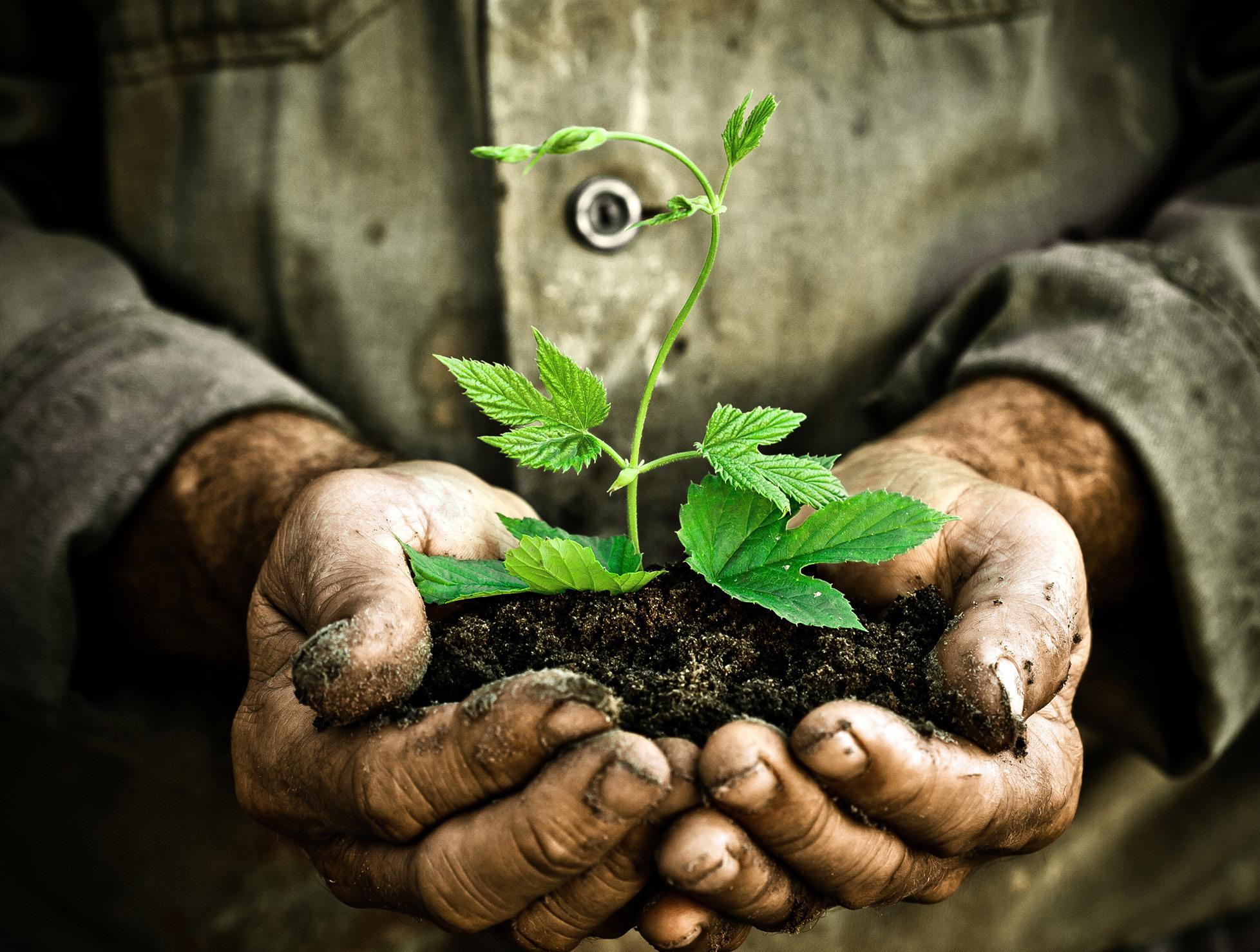
As the world grapples with the urgent need to mitigate climate change and adhere to the 1.5-degree Celsius target outlined in the Paris Agreement, the demand for robust and high-integrity carbon markets has never been more critical. Despite the potential of naturebased solutions (NBS) and carbon credits to drive substantial reductions in greenhouse gas emissions, only a meager 6.4% of existing environmental credits are likely to meet the Core Carbon Principles and guidelines set forth by the Voluntary Carbon Markets Integrity Initiative (VCMI). This glaring shortfall underscores the pressing need for increased investment to enhance capacity, transparency, and traceability in the carbon markets.
Carbon markets offer a powerful mechanism to drive investment into
climate mitigation projects, particularly those based on natural solutions such as reforestation, biochar production, hemp cultivation, and seaweed farming. These initiatives not only sequester carbon but also provide co-benefits such as biodiversity conservation, improved water quality, and enhanced livelihoods for local communities. However, to unlock their full potential, significant investment is required to scale up these projects and ensure their integrity.
The current landscape of carbon credits reveals a stark disparity between supply and demand. The primary challenge lies in the credibility and effectiveness of these credits. According to recent analyses, only a small fraction of issued credits are likely to conform to the stringent criteria necessary for high-integrity carbon
offsets. This issue is compounded by the need for robust Monitoring, Reporting, and Verification (MRV) systems to ensure transparency and accountability.
The Corporate Sustainability Reporting Directive (CSRD) and other emerging standards mandate comprehensive audit trails at the project level, requiring high levels of traceability and data on co-benefits. This necessitates advanced technological solutions and significant capacity-building efforts.
To address these challenges, strategic investment in capacity building is essential. Philanthropic funding, along with support from multilateral development banks (MDBs) and other financial institutions, can play a pivotal role. According to the Voluntary Carbon Markets Integrity
Initiative (VCMI), there are several key areas where investment can make a substantial impact:
1. Policy and Regulatory Frameworks: Strengthening national policies and regulations to create an enabling environment for carbon markets is crucial. This includes aligning with international standards and ensuring consistency across jurisdictions.
2. Institutional Strengthening and Governance: Developing robust institutional frameworks and governance structures to oversee carbon market activities is vital. This includes capacity building for government agencies, establishing inter-ministerial coordination mechanisms, and fostering public-private partnerships.
3. Knowledge and Capacity Building: Investing in training and education for stakeholders across the carbon market value chain is essential. This includes building technical expertise in MRV, enhancing understanding of market dynamics, and fostering innovation in carbon sequestration technologies.
4. Project Implementation and Financing: Providing financial support for the development and implementation of high-quality carbon projects is crucial. This includes de-risking investments through mechanisms such as credit insurance for carbon forwards and creating long-term offtake agreements to ensure market stability.
Enhancing Market Integrity
Ensuring the integrity of carbon markets is paramount to their success. The establishment of Core Carbon Principles (CCPs) and the implementation of guidelines by bodies such as the VCMI and the Integrity Council for the Voluntary Carbon Market (ICVCM) are essential steps in this direction. These principles emphasize transparency, additionality, permanence, and the avoidance of double counting. The role of auditing in sustainability reporting cannot be overstated.
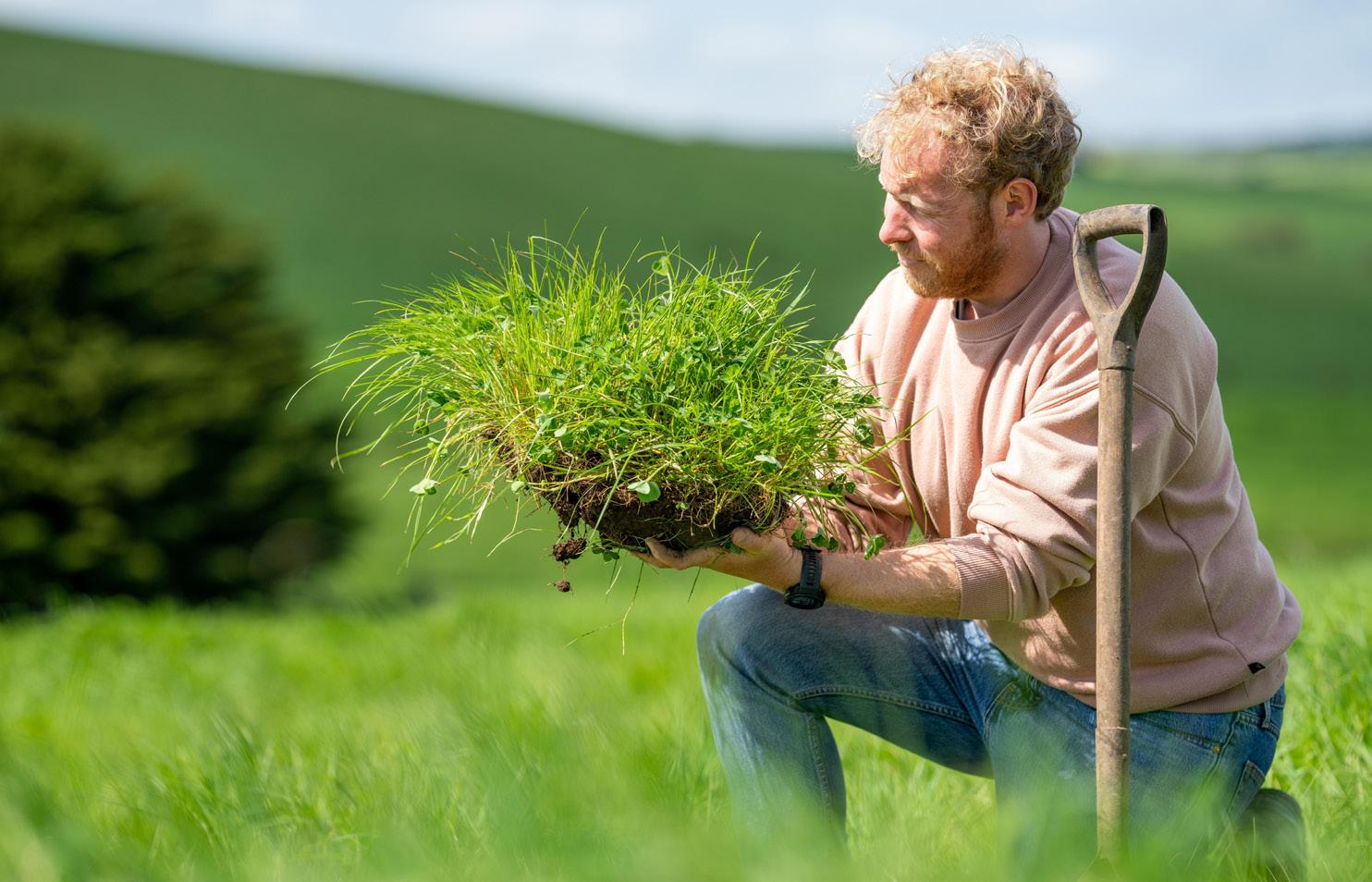
ONE OF THE MOST EFFECTIVE NATUREBASED SOLUTIONS, REFORESTATION, INVOLVES PLANTING TREES ON DEGRADED LAND TO SEQUESTER CARBON AND RESTORE ECOSYSTEMS.
Rigorous audit processes and verification mechanisms are necessary to validate the environmental and social impacts of carbon projects. This includes leveraging advanced technologies such as blockchain for traceability and using remote sensing and AI for monitoring and verification.
Reforestation and egenerative
Reforestation: One of the most effective nature-based solutions, reforestation, involves planting trees on degraded land to sequester carbon and restore ecosystems. Investing in large-scale reforestation projects can significantly enhance carbon stocks while providing biodiversity and socio-economic benefits. Successful examples include the Great Green Wall in Africa and the Trillion Trees Initiative, which aim to restore millions of hectares of degraded land.
Regenerative Agriculture: This approach focuses on farming practices that restore soil health, increase biodiversity, and sequester carbon. Techniques such as cover cropping, no-till farming, and agroforestry not only capture carbon but also improve water retention and crop resilience. Investment in regenerative agriculture can transform food systems, making them more sustainable and climateresilient. If you haven’t seen Kiss the Ground and Commend Ground documentaries - check them out as soon as possible.
Green Bonds: These are financial instruments designed to raise capital for projects with environmental benefits. Green bonds have become a critical tool for financing large-scale NBS projects. They provide a reliable source of funding for initiatives such as renewable energy, energy efficiency, and sustainable agriculture. The green bond market has grown exponentially, with issuances reaching record levels in recent years.
Blue Bonds: Blue bonds specifically finance marine and coastal conservation projects. These bonds support initiatives like coral reef restoration, sustainable fisheries, and marine protected areas. By addressing the health of ocean →
→ ecosystems, blue bonds play a crucial role in mitigating climate change and preserving biodiversity.
Several innovative projects and financial instruments are setting new benchmarks in the carbon markets:
Biochar Production: Biochar, a form of charcoal produced from organic waste, is gaining traction for its ability to sequester carbon while improving soil health. Investments in biochar projects are increasing, driven by their potential for scalability and multiple co-benefits.
Hemp Cultivation: Hemp is emerging as a promising crop for carbon sequestration due to its fast growth rate and high biomass yield. Investment in hemp-based carbon credits is growing, supported by advancements in cultivation techniques and processing technologies.
Seaweed Farming: Seaweed farming is being recognized for its potential to sequester carbon and mitigate ocean acidification. Investments in seaweedbased carbon credits are on the rise, supported by research into its ecological benefits and commercial viability.
Pulsora and EcoAdvis Partnership:
This promising collaboration leverages blockchain technology to enhance sustainability reporting and emissions tracking. Through the EcoSpera platform, detailed audit trails can be maintained down to the individual plant level, providing unprecedented transparency and traceability. Satellite imagery with 1.5-meter resolution further enhances the accuracy and reliability of data collection. You can read more about this at www.futureinsight.green
The Path Forward
To achieve the 1.5-degree Celsius target and ensure the sustainability of our planet, it is imperative to scale up investment in high-integrity carbon markets. This requires a concerted effort from governments, financial institutions,

BY FOSTERING INNOVATION, ENHANCING CAPACITY, AND ENSURING TRANSPARENCY, WE CAN UNLOCK THE FULL POTENTIAL OF NATUREBASED SOLUTIONS AND DRIVE MEANINGFUL CLIMATE ACTION.
philanthropic organizations, and private sector stakeholders. By fostering innovation, enhancing capacity, and ensuring transparency, we can unlock the full potential of nature-based solutions and drive meaningful climate action.
The need for high-quality carbon credits that meet stringent integrity criteria is more pressing than ever. With only a fraction of current credits likely to achieve this standard, significant investment in capacity building and technological innovation is essential. By aligning efforts across the global community and leveraging the unique strengths of each stakeholder, we can create a robust and effective carbon market that supports sustainable development and climate resilience.
VCMI Releases New Framework: The Voluntary Carbon Markets Integrity Initiative has released its latest framework to guide the development
0f high-integrity carbon markets. This framework emphasizes transparency, accountability, and inclusivity, providing a comprehensive set of guidelines for market participants.
for Carbon Projects: The United NationsDevelopment Programme (UNDP) has announced a substantial funding initiative to support carbon market projects in developing countries. This funding aims to enhance capacity, improve MRV systems, and promote sustainable development.
Reporting Standards: The European Union has introduced new regulations under the Corporate Sustainability Reporting Directive (CSRD) to enhance the transparency and credibility of sustainability reports. These regulations require detailed audit trails and verification processes, ensuring the integrity of reported data. It has now been extended with the Corporate Sustainability Reporting Due Diligence Directive (CSRDDD) and it is already being implemented.
A new Blue Bond initiative has been launched to support marine conservation projects that generate carbon credits. This initiative aims to attract investment by offering financial incentives and promoting the ecological benefits of marine ecosystems.
Gain Traction: Biochar projects are gaining momentum with increased investment and technological advancements. These projects offer a scalable solution for carbon sequestration and soil health improvement, attracting interest from both public and private sectors. By staying ahead of these developments and supporting highintegrity carbon markets, we can collectively drive the transition to a sustainable and resilient future. We need to focus on financing nature based high quality projects and help nature. ■ ecoadvis.com/join




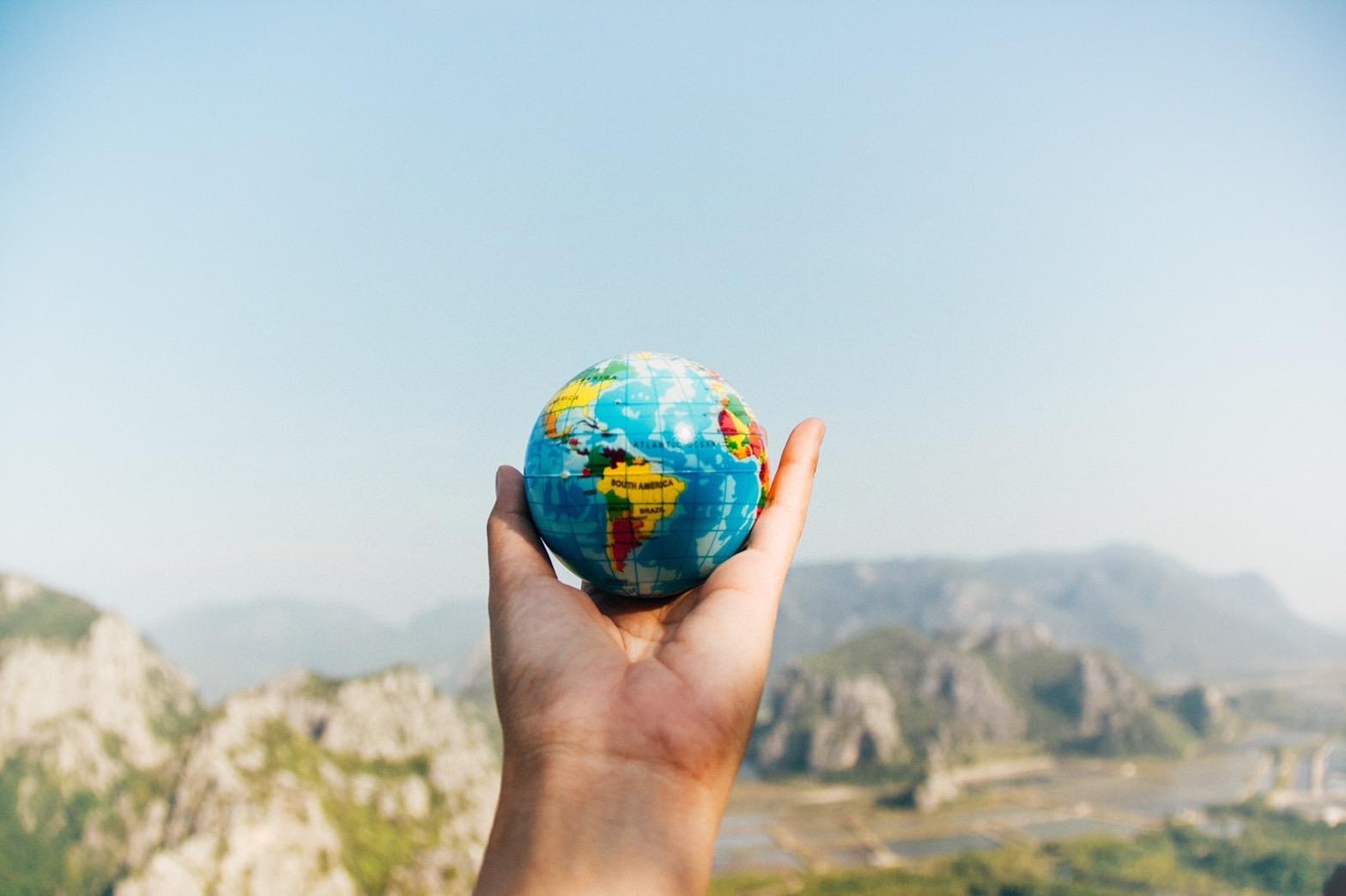




Real actions from all of us are needed to achieve the SDGs by 2030. UNIPLAT presents so everyone—regardless of their country, race, religion, economic situation, etc—can contribute to the initiatives of bringing a bright future to this world.




In the heart of every seed lies the potential for incredible growth. Just as the moringa seed holds the promise of nourishment and renewal, our platform lays the groundwork for a sustainable future.




With the world's first global standard for environmental credit, from plant to seed, we're not just planting seeds—we're nurturing the very foundation of environmental stewardship.


Join us in sowing the seeds of change, where every credit supports verified, tangible environmental regeneration. Together, we can cultivate a greener, more sustainable world. From the ground up, let's build a legacy of growth and resilience for generations to come.













The bloom of the moringa flower is a testament to what can be achieved when we commit to nurturing our environment. It symbolizes the flourishing beauty and tangible benefits that stem from our dedication to sustainability and regenerative practices.


Our platform is more than a bridge between intention and action; it's a catalyst for real-world change. Through our comprehensive audit trail, from seed to standard, we ensure that every environmental credit contributes to a healthier, more vibrant planet.

This is the power of transformation, visible in the vibrant petals of the moringa and felt through the positive impact of each credit. Embrace the beauty of making a difference. Together, we're not just growing flowers—we're cultivating a legacy of environmental regeneration and hope for future generations.
Start Your Journey with a Seed of Change
Read more: https://www.ecospera.com/join/



In the evolving battle against climate change, the integrity of carbon credit markets stands as a critical frontier. EcoSpera emerges as a visionary force, poised to redefine this landscape with its innovative solution that ensures unparalleled transparency, traceability, and integrity. Rooted in the lessons of past projects and aligned with the latest regulatory standards, including the Corporate Sustainability Reporting Directive (CSRD), European Sustainability Reporting Standards (ESRS), and the Voluntary Carbon Market Integrity Initiative (VCMI), EcoSpera’s mission goes beyond remediation to set a new benchmark in environmental accountability. Through its unique approach, combining blockchain technology with a cooperative governance model, EcoSpera is not just addressing the climate crisis but is leading the charge towards a sustainable future with high-integrity carbon credits.
The Kariba REDD+ project, once a beacon of hope for carbon offsetting, aimed to protect forests and wildlife on the Zimbabwe-Zambia border. Despite its ambitious goals for sustainability and carbon sequestration, it faced criticism for its shortcomings in verifiability and long-term environmental impact. This case underscores a broader issue within the carbon credit market—a pressing need for verifiable, sustainable projects that deliver on their promises.
The regulatory landscape is evolving to address these challenges. The CSRD/ ESRS requirements and the VCMI’s new guidelines for high-integrity carbon credits represent significant strides toward ensuring that carbon offset projects are both environmentally and socially beneficial. These regulations aim to establish clear, stringent standards for transparency, accountability, and the real-world impact of carbon credits, pushing the
market towards more reliable and impactful practices.
This backdrop of ambitious projects falling short and tightening regulations highlights the urgent necessity for innovative approaches like EcoSpera’s. By leveraging advanced technologies and adhering to the highest standards of integrity, EcoSpera is positioned to address these shortcomings, offering a new paradigm that meets and exceeds the evolving demands of the global carbon credit market.
EcoSpera’s Mission and innovative approach
EcoSpera’s mission transcends the traditional boundaries of the carbon credit market, championing a future where integrity, traceability, and transparency are not just ideals, but foundational pillars. At its core, EcoSpera leverages cutting-edge blockchain technology to ensure every carbon credit is verifiable and secure,

eliminating doubts about authenticity and impact. This technological backbone is complemented by EcoSpera’s governance through a Liechtenstein Venture Co-operative (LVC), a structure that combines the agility of a venture-backed entity with the ethical and participatory ethos of a cooperative. This innovative governance model ensures that all stakeholders have a voice in the direction and decisions of the initiative, enhancing accountability and aligning with global sustainabilitygoals.
The Decentralized Autonomous Organization (DAO) further democratizes EcoSpera’s operations, enabling community members from around the world to contribute to its mission. This approach not only fosters a broad sense of ownership and involvement but also ensures that a diverse range of perspectives and expertise shapes the future of EcoSpera. By integrating community governance with blockchain’s
ECOSPERA’S MISSION TRANSCENDS THE TRADITIONAL BOUNDARIES OF THE CARBON CREDIT MARKET, CHAMPIONING A FUTURE WHERE INTEGRITY, TRACEABILITY, AND TRANSPARENCY ARE NOT JUST IDEALS, BUT FOUNDATIONAL PILLARS.

transparency and the strategic framework of an LVC, EcoSpera is pioneering a holistic approach to carbon credit verification.
This model addresses the market’s critical need for projects that can be thoroughly audited and trusted.
EcoSpera’s platform offers an end-toend solution from the initial certification of a carbon credit to its final retirement, ensuring that each step in the process is recorded, transparent, and aligned with the highest standards of environmental integrity. Through this comprehensive approach, EcoSpera is not just contributing to the global fight against climate change but is also setting a new standard for how carbon credits are generated, traded, and retired. The ultimate goal is to inspire confidence among all stakeholders—investors, environmental groups, and regulatory bodies—that the carbon credits represent real, tangible environmental benefits.
The EcoSpera Ecosystem represents an integrated approach to carbon credit verification, ensuring every step from seed planting to credit retirement is transparent, traceable, and aligned with the highest standards of environmental integrity. By weaving together specialized
components like EcoAdvis, Trees4CO2, Better Globe Forestry, Nzatu Food Group, TraceX, and the Spera Impact Blockchain (SPIT), EcoSpera not only adheres to but also surpasses the stringent requirements set by CSRD, ESRS, and VCMI.
• Spera Impact Blockchain (SPIT) is the backbone of the EcoSpera ecosystem and enhances it’s traceability, offering an additional layer of security and verification for every transaction within the EcoSpera ecosystem. By making all data related to carbon credits readily available and indisputable, SPIT ensures the integrity of the credits and the projects they represent.
• EcoAdvis offers expert project management and compliance services, guiding projects to align with international sustainability standards, ensuring that each initiative within the EcoSpera ecosystem contributes positively to the environment and society while adheringto regulatory requirements.
• Trees4CO2 embodies the direct action of reforestation and afforestation, translating carbon credits into real-world environmental benefits. This initiative focuses on planting species like mahogany and moringa, which are known for their high carbon sequestration rates, directly combating climate change.
• Better Globe Forestry focuses on sustainable forestry practices that promote biodiversity, prevent desertification, and provide sustainable livelihoods for local communities. Its operations generate verifiable carbon credits by maintaining healthy forests that act as carbon sinks.
• Nzatu Food Group integrates sustainable agriculture practices, ensuring that projects support food security and socio-economic development, emphasizing the socialsustainability aspect of carbon credit projects.
• TraceX leverages blockchain technology to provide a transparent and unalterable record of carbon credit transactions, from the initial issuance to their final retirement. →
→ This ensures that all stakeholders can trust the authenticity and impact of the credits. This comprehensive ecosystem approach ensures that every carbon credit issued by EcoSpera is backed by real, verifiable environmental actions. By exceeding the standards set by CSRD, ESRS, and VCMI, EcoSpera not only contributes to the fight against climate change but also sets a new benchmark for transparency and integrity in the carbon credit market. Through this model, EcoSpera demonstrates how innovative technologies and cooperative governance can be harnessed to create a sustainable future, showcasing a scalable, replicable solution for global environmental challenges.
Addressing challenges and setting a new standard for carbon and biodiversity credits
Expanding the content to triple its length while maintaining the essence and introducing more depth:
EcoSpera’s strategic approach is deeply informed by the insights gained from the analysis of past carbon credit initiatives, such as the Kariba project. Recognizing the critical need for genuine sustainability, reliable verification processes, and meaningful community engagement, EcoSpera has engineered its model to transcend these historical pitfalls.
Central to its strategy is an unwavering commitment to the principles outlined by the Voluntary Carbon Market Integrity Initiative (VCMI). Through meticulous alignment with VCMI’s Monitoring, Reporting, and Assurance Framework, EcoSpera ensures each carbon credit’s journey from issuance to retirement is meticulously documented and verified, setting a precedent in the industry.
Further advancing the standard, EcoSpera embraces ‘Scope 3 Flexibility’ within its operational framework. This innovative approach allows for a more inclusive and comprehensive accounting of carbon credits, enhancing the scope and credibility of claims. By meticulously adhering to and expanding upon VCMI guidelines, EcoSpera is not merely participating in the market; it is actively redefining the paradigms of
accountability, transparency, and environmental stewardship.
EcoSpera’s holistic model, built on the lessons of past endeavors and the rigorous standards of current environmental integrity frameworks, positions it as a vanguard in the carbon credit market. The initiative’s forward-thinking approach—marrying technological innovation with stringent adherence to global sustainability standards—illustrates a blueprint for future projects. EcoSpera’s commitment to exceeding existing standards and setting new benchmarks reflects a broader mission: to cultivate a carbon credit market that is not only robust and reliable but also a true catalyst for global environmental change.
To fully articulate EcoSpera’s vision and its strategic direction for a sustainable future, it’s essential to highlight the initiative’s commitment to deepening its impact on the global carbon credit market through innovation, collaboration, and expansion. EcoSpera is poised to extend its reforestation and afforestation projects, incorporating a broader array of species and ecosystems, thus enriching biodiversity and EcoSpera exemplifies a revolutionary stride towards sustainability in the carbon credit market, setting new benchmarks for transparency, integrity, and environmental stewardship. Its comprehensive approach and innovative solutions underscore a commitment to addressing climate change, fostering biodiversity, and promoting sustainable development. As EcoSpera advances, its model of collective action, underpinned by cutting-edge technology, offers a beacon for global efforts towards a greener future. This initiative not only highlights the potential for impactful change but also inspires a broader movement towards sustainable practices worldwide, making EcoSpera a paragon for future endeavors in environmental conservation and carbon reduction.enhancing carbon sequestration capacities. The initiative’s expansion into new territories is strategically planned to ensure that
ECOSPERA STANDS AS A GROUNDBREAKING LEADER IN THE CARBON CREDIT MARKET, UNIQUELY OFFERING PLANT-LEVEL VERIFICATION AND CERTIFICATION WITH A DETAILED AUDIT TRAIL FROM SEED TO RETIREMENT. THIS UNPARALLELED APPROACH MARKS ECOSPERA AS NOT JUST A PARTICIPANT IN THE MARKET BUT AS THE VANGUARD OF A SUSTAINABILITY REVOLUTION.

each project aligns with local ecological conditions and community needs, fostering environmental resilience and sustainable development.
Moreover, EcoSpera envisions leveraging its blockchain technology to further enhance the traceability and verification of carbon credits, setting new industry benchmarks for integrity and reliability. This technological advancement will enable EcoSpera to offer unparalleled transparency in its operations, reinforcing stakeholder confidence and driving the adoption

of high-integrity carbon credits globally. Through collaborative efforts with governments, NGOs, and local communities, EcoSpera aims to amplify its contribution to combating climate change, promoting sustainable land management practices, and supporting socio-economic development in underserved regions. This comprehensive approach underscores EcoSpera’s dedication to not just mitigating global carbon emissions but also to fostering a more equitable and sustainable world. ■
EcoSpera stands as a groundbreaking leader in the carbon credit market, uniquely offering plant-level verification and certification with a detailed audit trail from seed to retirement. This unparalleled approach marks EcoSpera as not just a participant in the market but as the vanguard of a sustainability revolution. By joining the EcoSpera’s 100% Together Community, members become integral to a movement setting new global standards for environmental integrity. This opportunity to be part of such a pioneering venture is a call to action for those looking to make a tangible impact on our planet’s future.
EcoSpera is not just inviting members; it’s inviting change-makers to be at the forefront of an environmental revolution, making a real difference in the fight against climate change.


Welcome to your private island home where magic and memories go hand in hand. Rooted in honoring the Fijian way of life, creating a world community, and preserving the environment - on Turtle Island it’s easy to imagine the world the way it should be.
The Island is powered by solar energy, produce is locally grown, and the accommodations are hand-crafted by Fijian artisans.
With just 14 villas, acres of serene forests and 12 private beaches, Turtle Island serves as an idyllic sanctuary for travelers seeking connection, community, culture, and consciousness.
By THE POWER OF VOICE.

Myanmar’s state of emergency has been extended for six months, announced Senior General Min Aung Hlaing, Chairman of the State Administration Council, on Jan. 31, 2025. The South-East Asian country now begins preparing for a general election. This is a critical turning point that can break the deadlock in the escalating bloody civil war. Ingo PEACE., an NGO focused on Myanmar’s future, sent reporters to cover the situation on the ground.
As recently as January, 2025, vehicles were being stopped on entering Yangon International Airport, where the authorities made sure no local young men were present. The
regime’s conscription order means that men aged 18 to 35 are not allowed to leave the country. Under martial law, the city’s bustling streets are deserted by nightfall. The situation is a clear reminder that Myanmar is in a state of war, and the tension is palpable.
The world watched as the Tatmadaw military regime staged a coup on Feb. 1, 2021, citing voter fraud in the National League for Democracy (NLD)’s landslide victory in 2020 elections. On assuming power, the NLD had outlined a policy of eliminating the military, including the execution of its leaders. In response, the Tatmadaw attempted to initiate dialogue, but negotiations broke down and it seized back power by force in fear of an impending crisis. As the people resent being deprived of power and being subject to control, they took up arms and rebelled against the regime, leading to a state of civil war.

Four years on, the conflict continues to ravage the country, with no end in sight. The economic situation is dire, and civilians are in deep distress. Some areas have reportedly fallen into anarchy and become breeding grounds for international crime.
“Myanmar is falling apart,” said a local political expert, stating that “the country will collapse at this rate.”
Despite their daily hardships, more and more young people have acquired weapons. This paradox—risking their lives to survive—reveals the desperate national sentiment and abnormality of the situation.
The situation must improve immediately and the conflict must stop, this much is clear. A scenario in which the NLD defeats the military regime and regains power might seem like the most straightforward outcome.
However, history has shown that, when regimes are overthrown by force, a new reign of terror begins, another group rises against it, and fighting persists. This is a very plausible development. Moreover, we must not forget that both the regime and the opposition have been supported by competing foreign powers, making the conflict in Myanmar akin to a “proxy war.” Regardless of which side “wins,” there will be lasting repercussions in the international community.
Additionally, it is crucial to recognize that Myanmar is a multiethnic country with diverse cultural and linguistic groups. This civil war is no longer a simple anti-coup movement aimed at the restoration of the government and the removal of the military. It has become a complex issue intertwined with political demands, such as the autonomy and independence of ethnic minorities and the establishment of a federal system. If the centralized system continues, the discontent of minority groups will undoubtedly persist. Overthrowing the regime alone does not guarantee national stability. The one thing all parties have in common is that they each seek happiness from their own perspective.
We believe that a violent attack can never be justified, regardless of the reason.
Although it is not often reported outside the country, the regime has made public speeches declaring their efforts to ensure domestic stability and lay out a vision for development, while stating they are ready for dialogue. In February this year, they explicitly stated to us that they would peacefully transfer power to an elected government following elections. Each organization is fighting for its own sense of justice. Every claim is valid, but none are exclusive.
“A talented female employee has just quit,” said one dejected local business owner who is working with ingo PEACE. Her husband was conscripted shortly after they had married, so they decided to escape Myanmar together. People in the country say that 99% of those drafted never return.
Powerless ordinary citizens are caught up in the political turmoil and forced to make sacrifices. Is continuing the fight truly in the country’s best interest? Rather than people of the same country killing each other, would it not be a better choice for PEACE to create an environment where voices are heard, rights are respected, and people can live together?
However, the path to happiness for the country can only be determined by the people of the country.
A unique chance now lies before Myanmar to fundamentally reshape its future. ■

